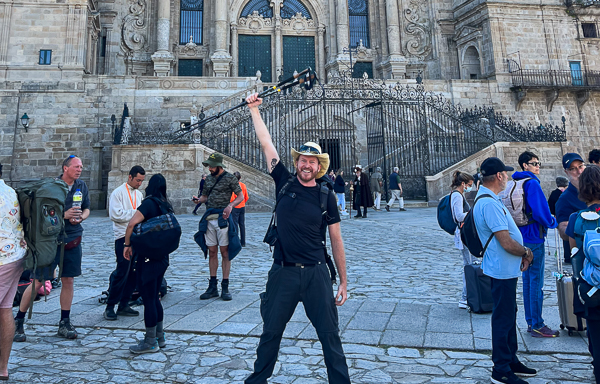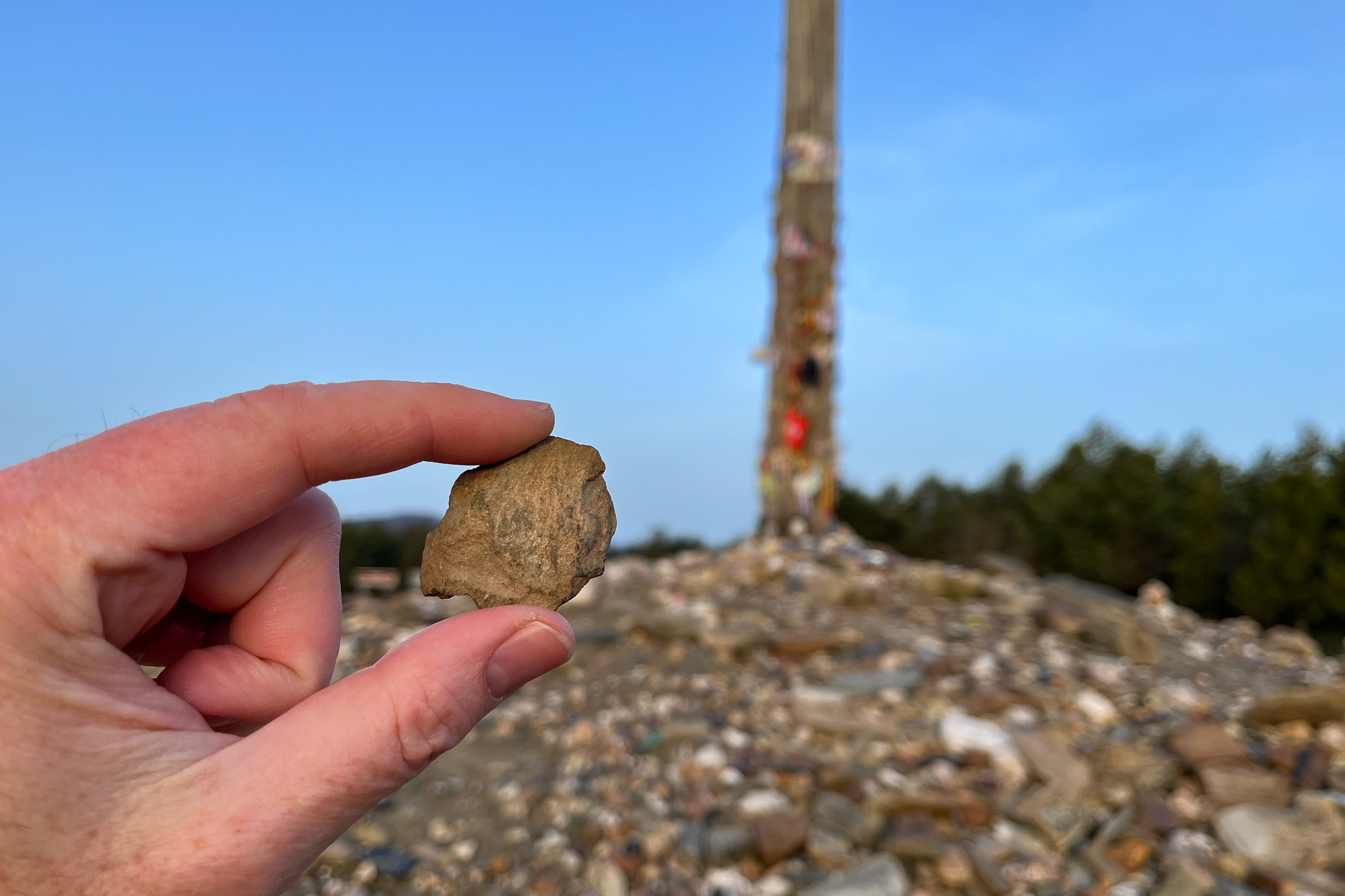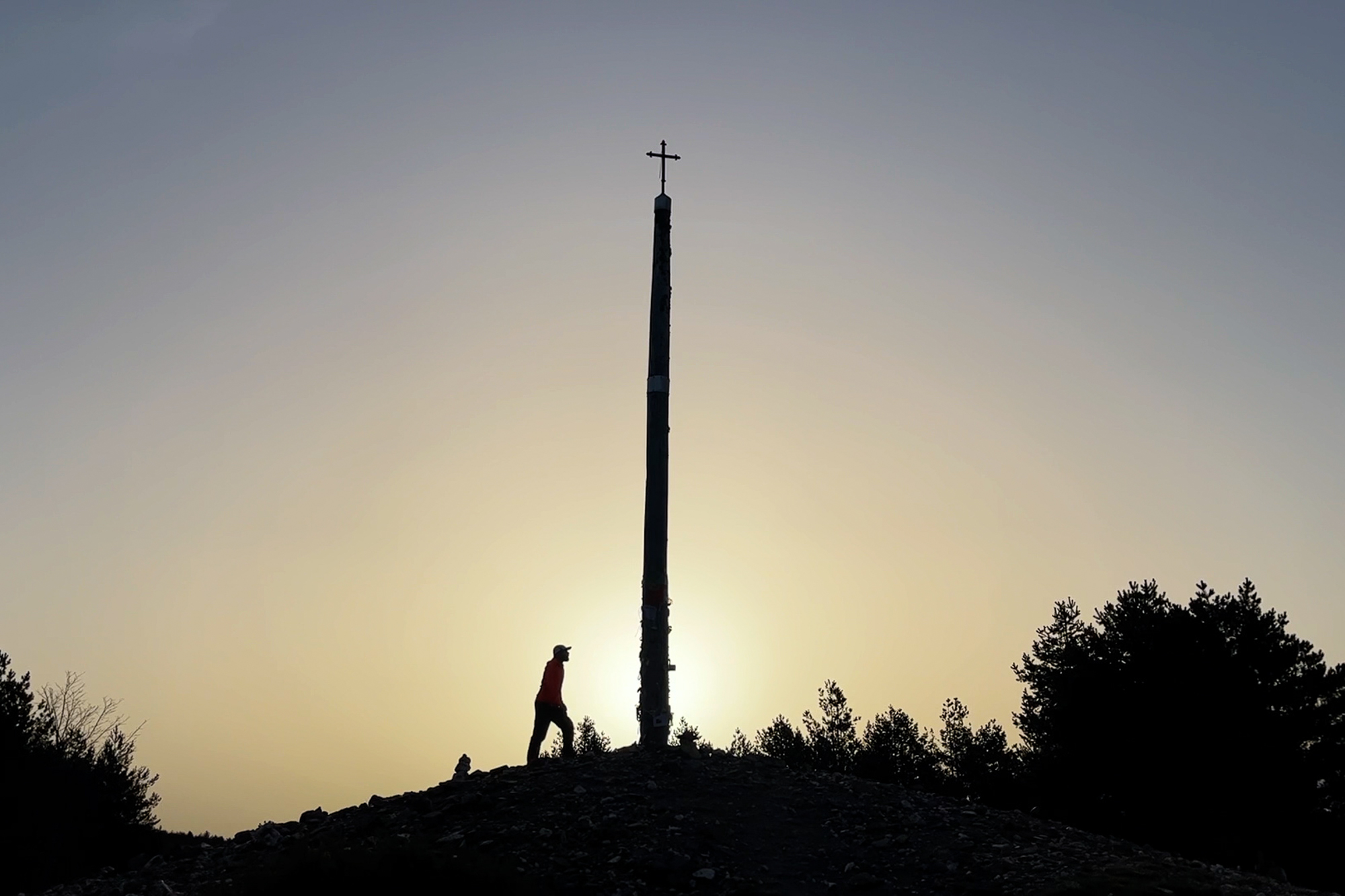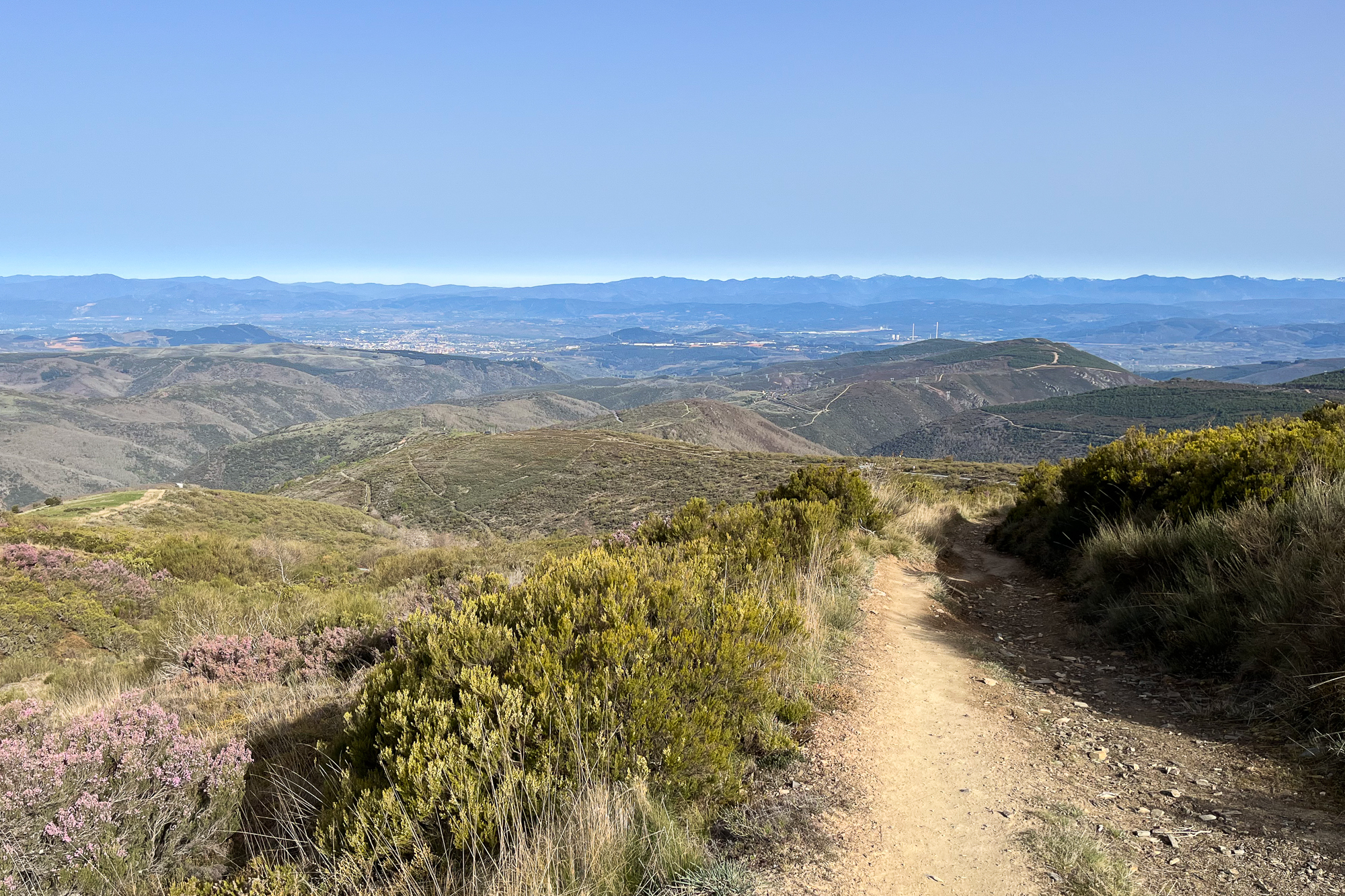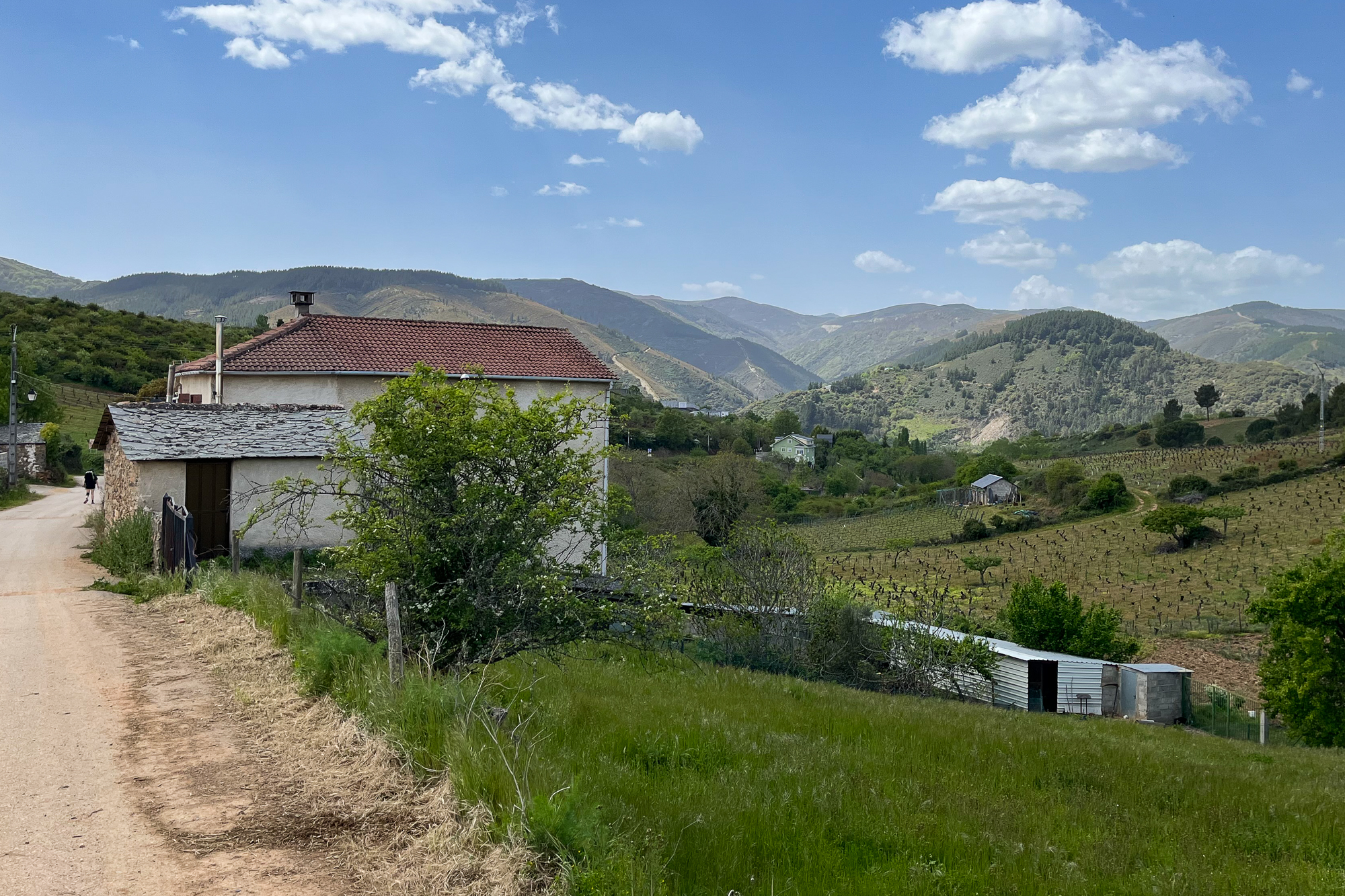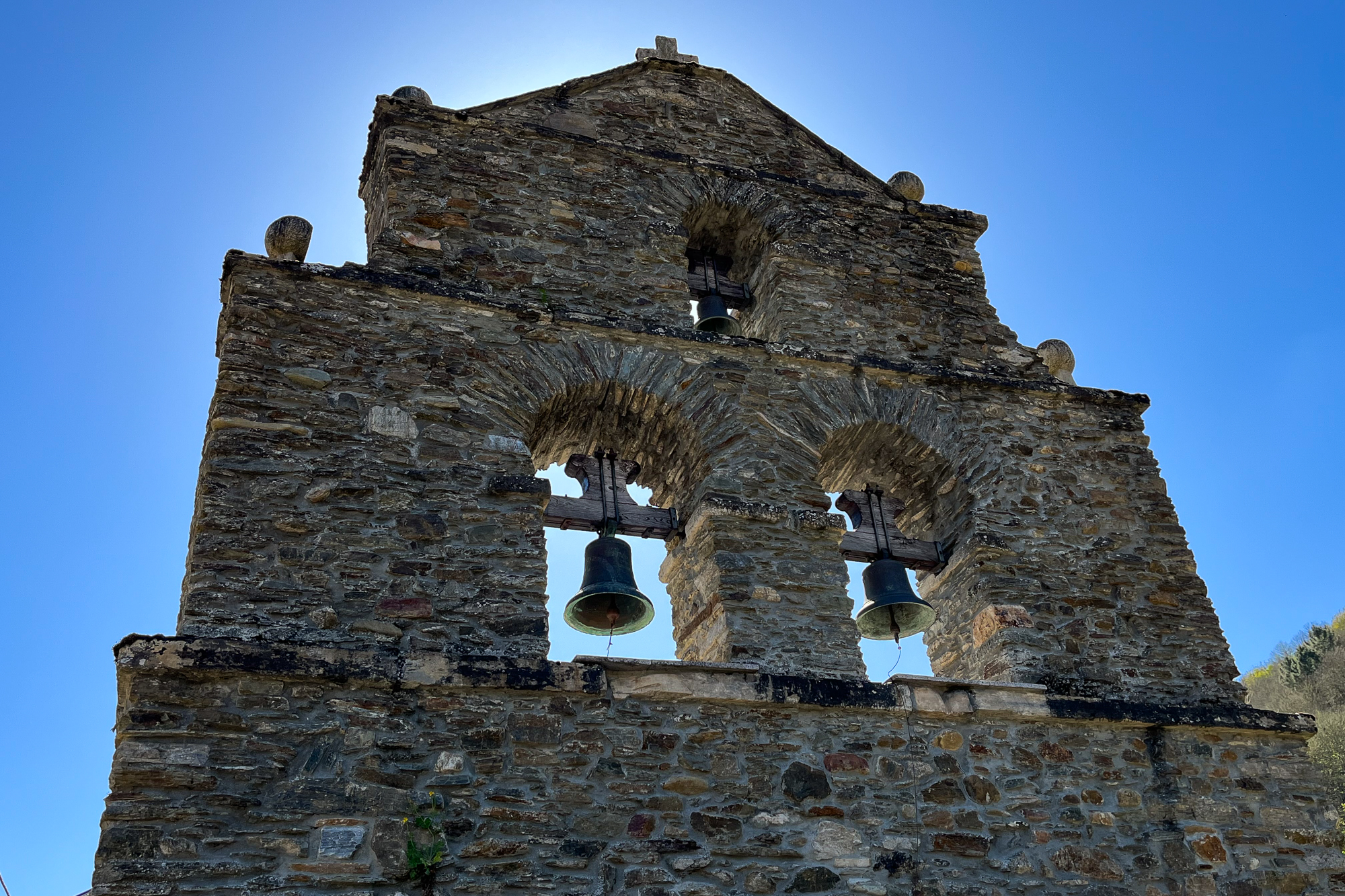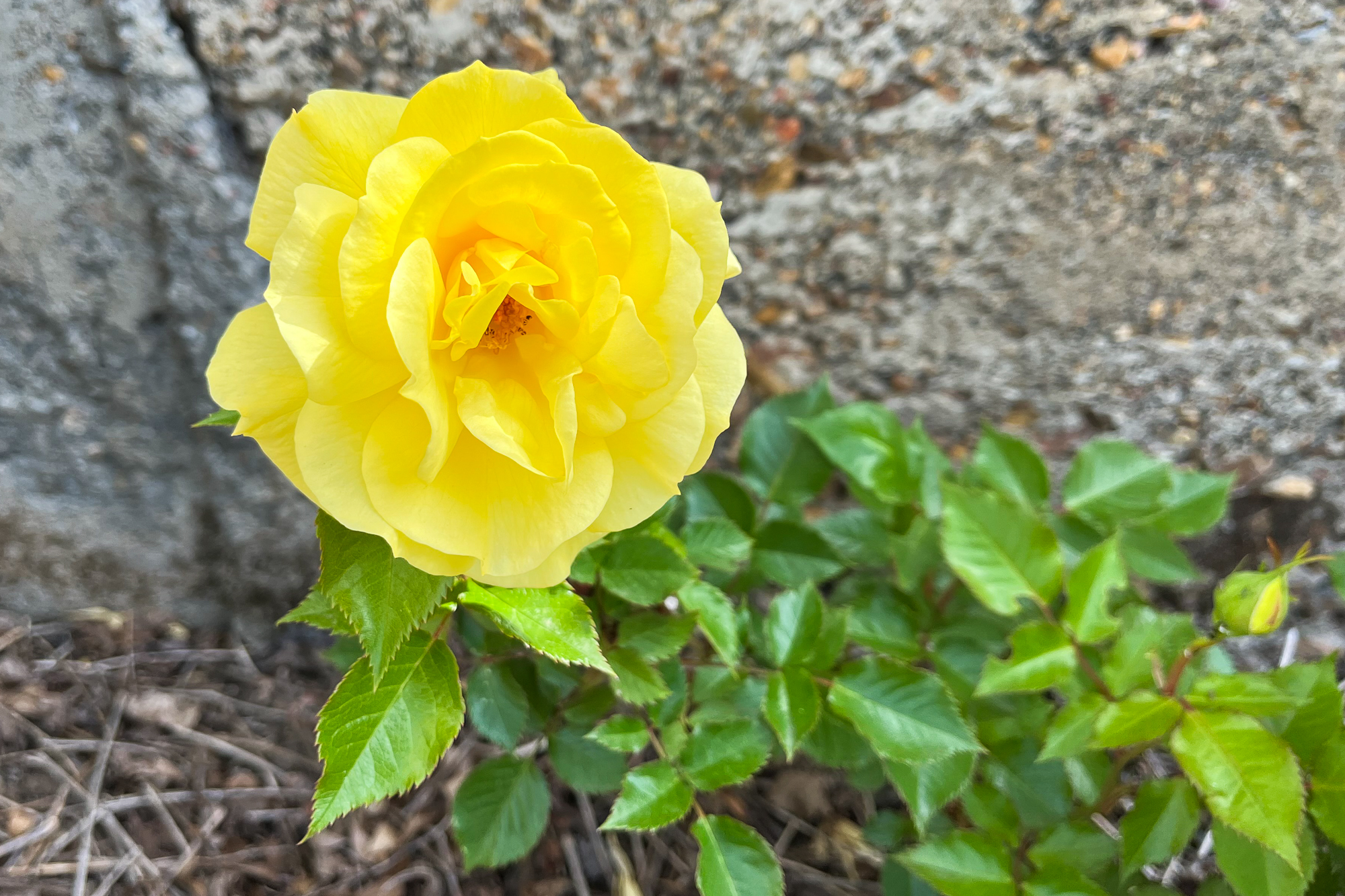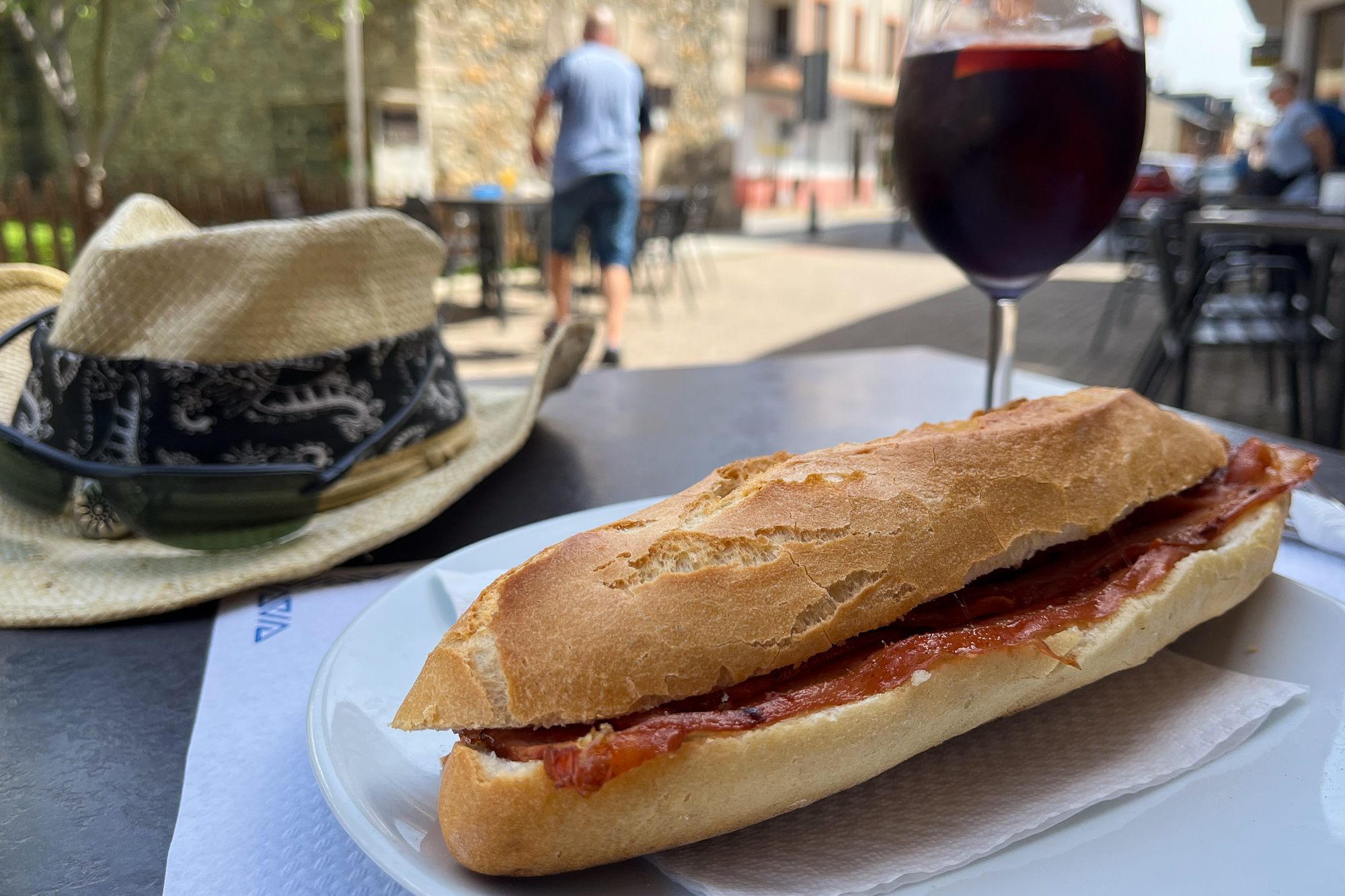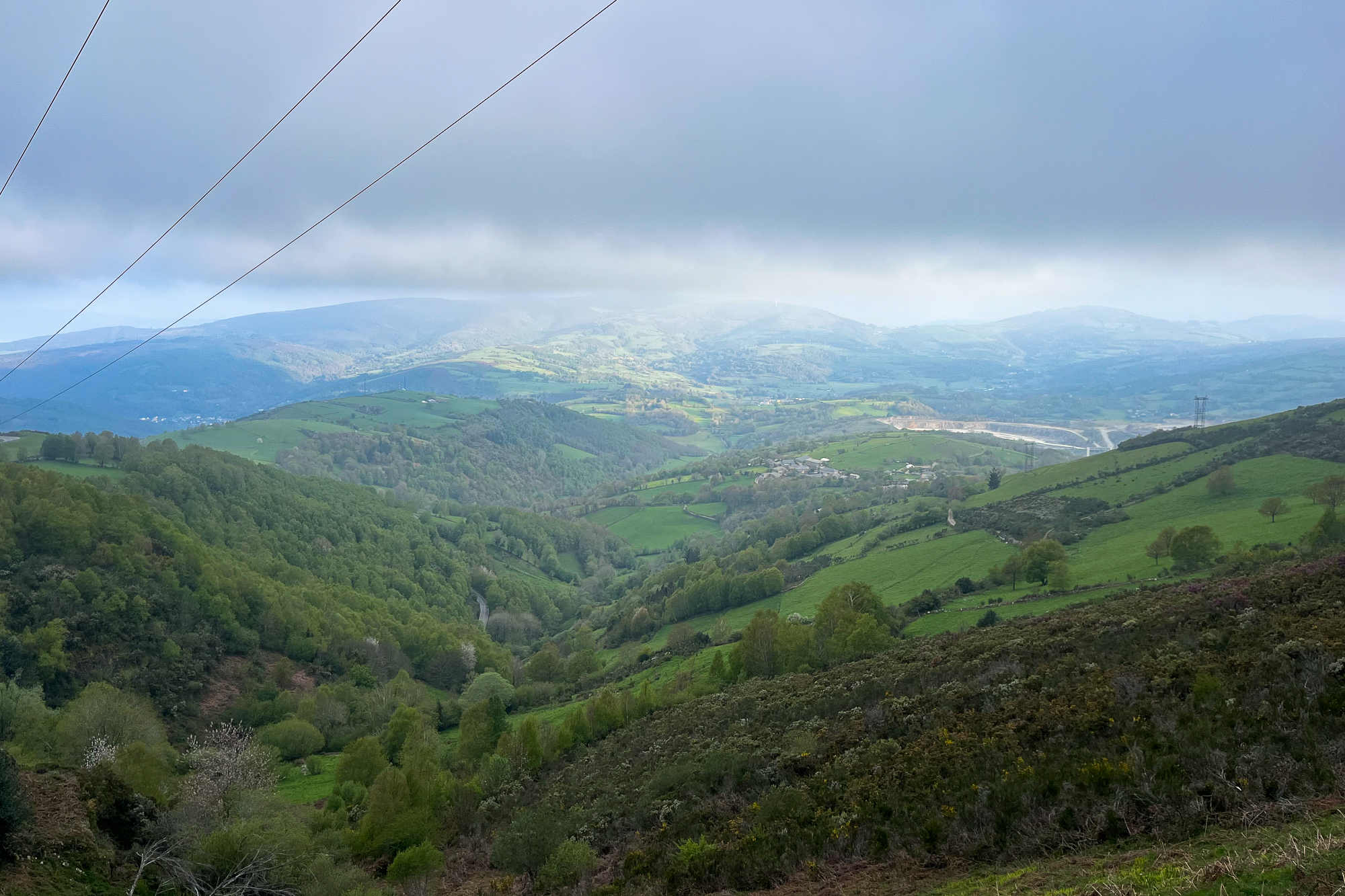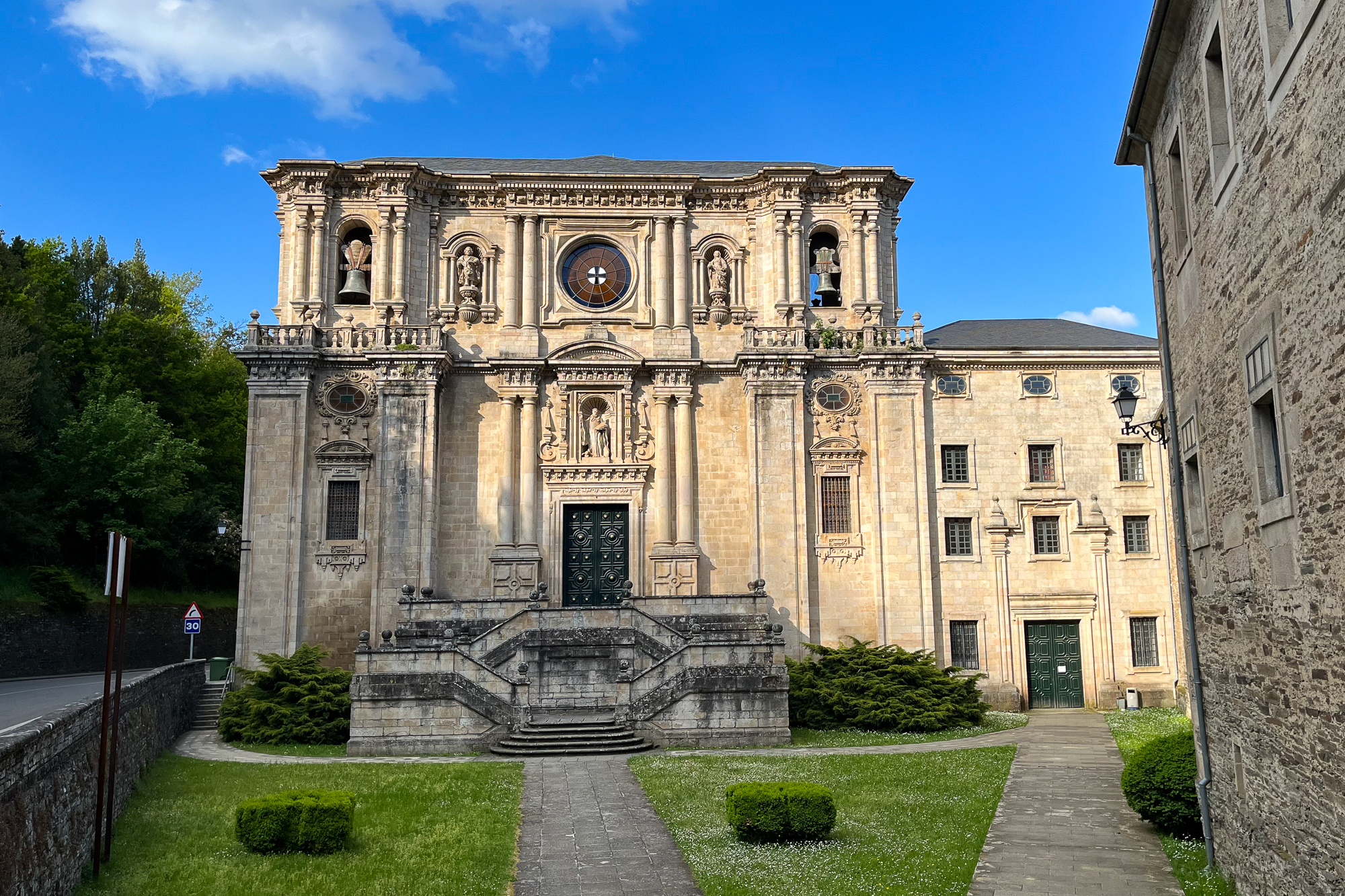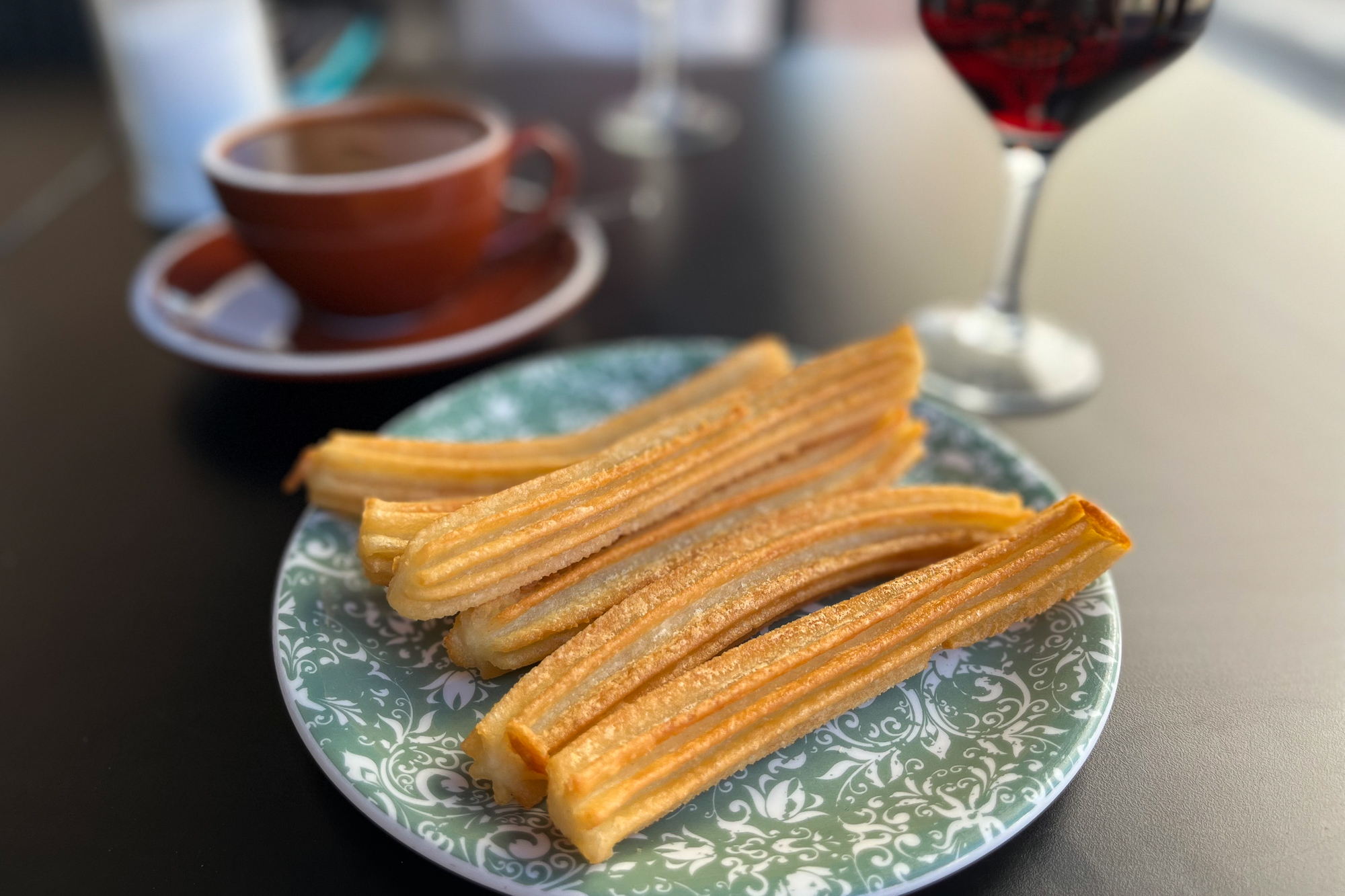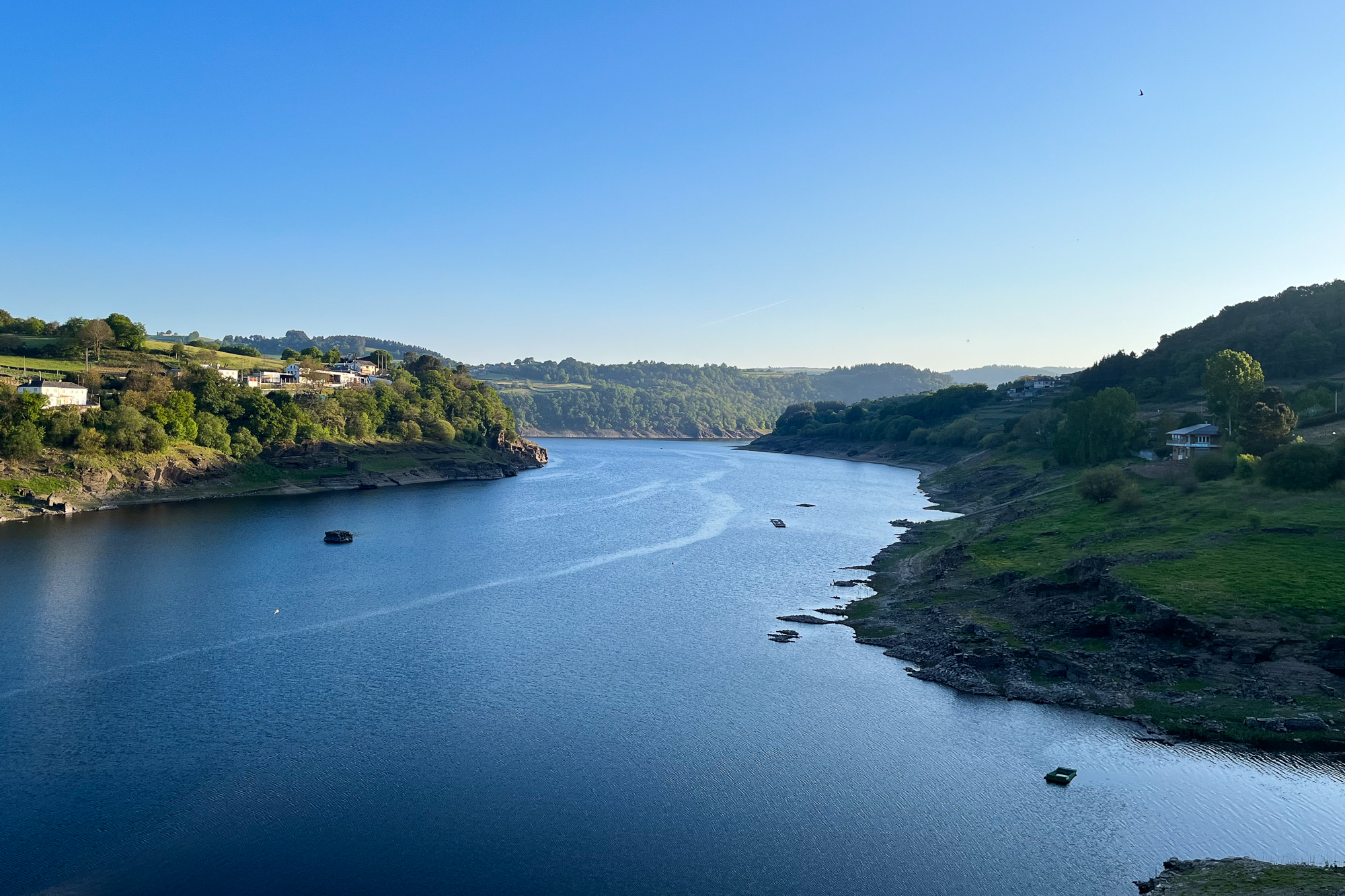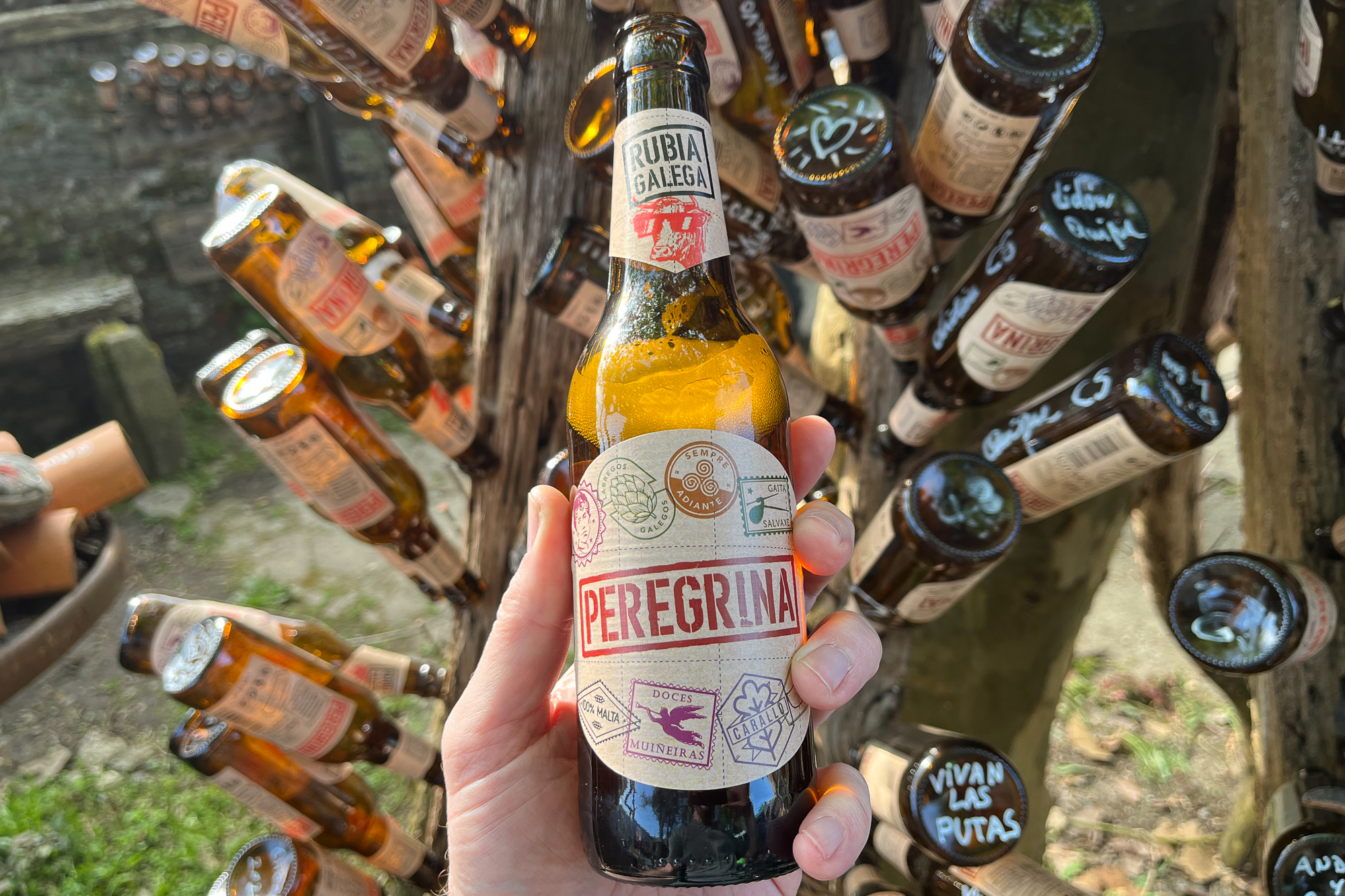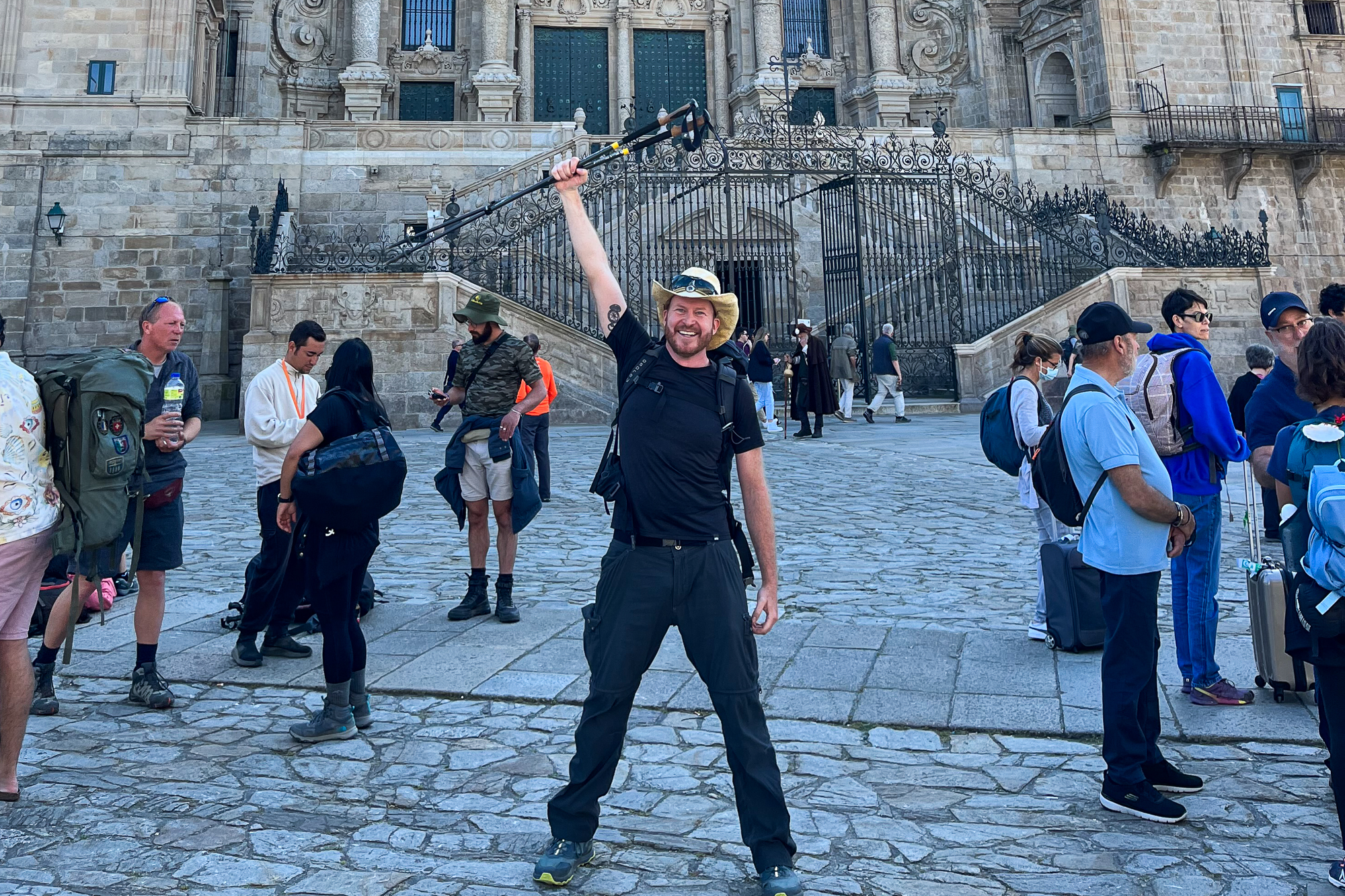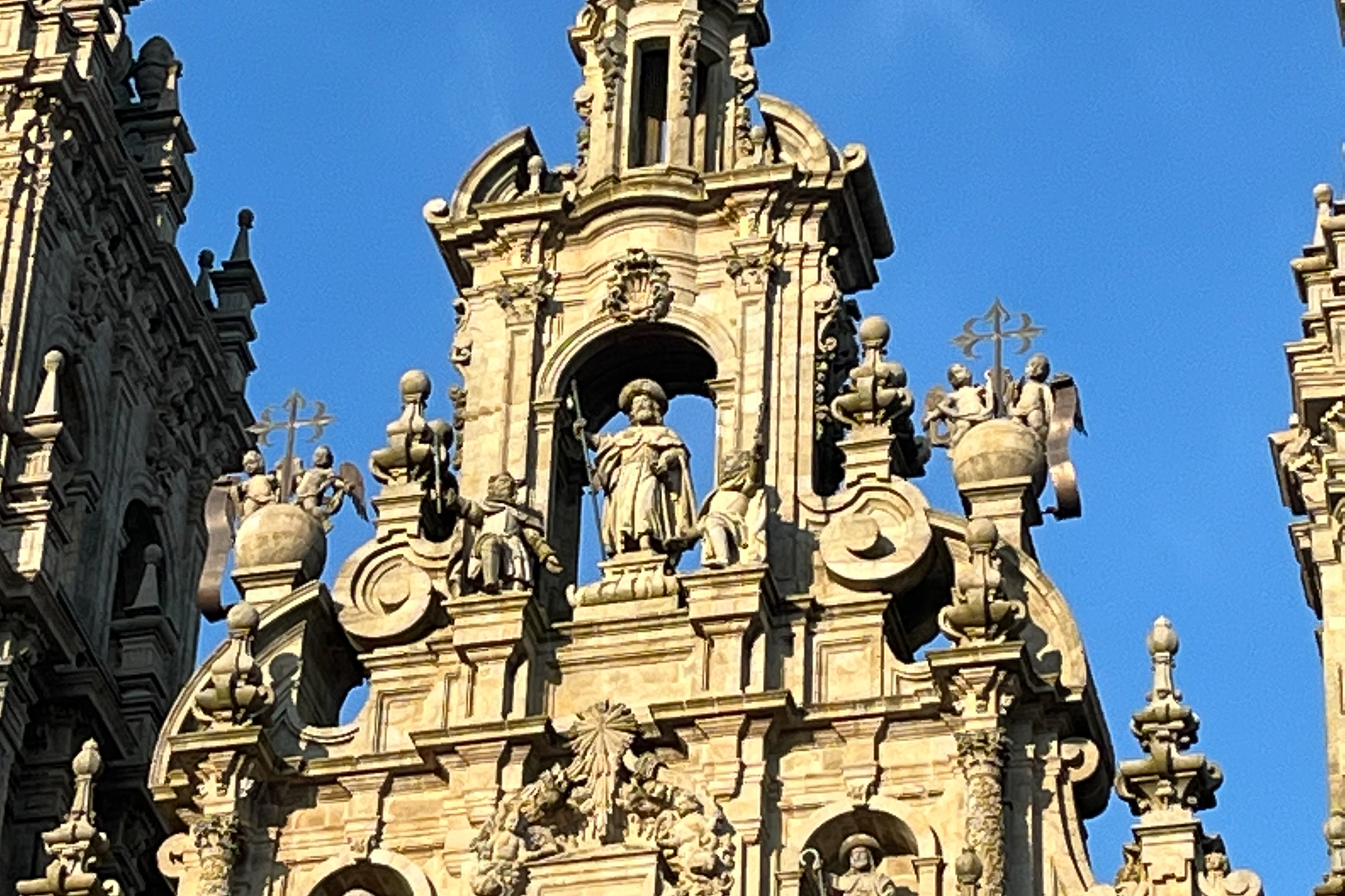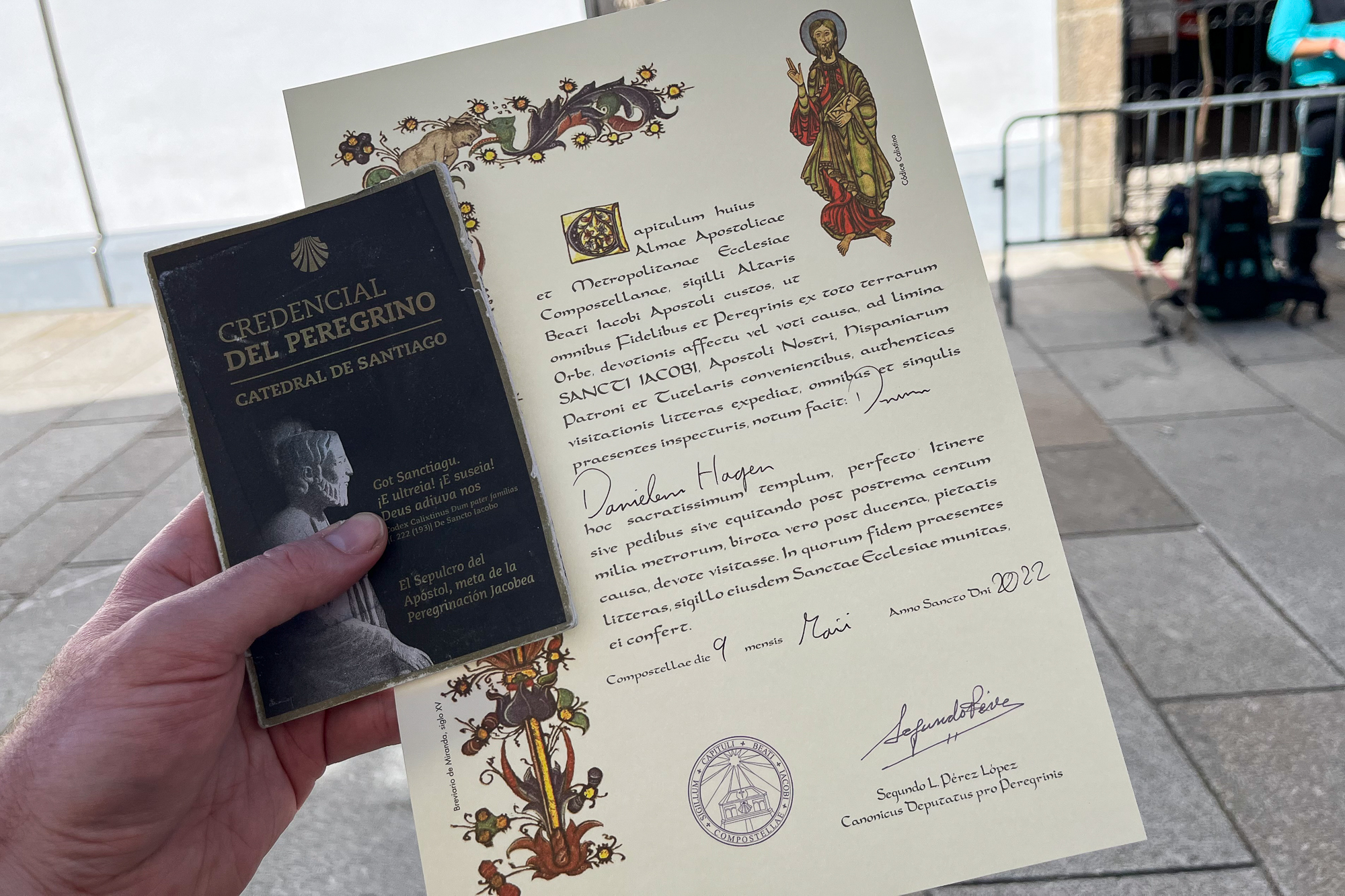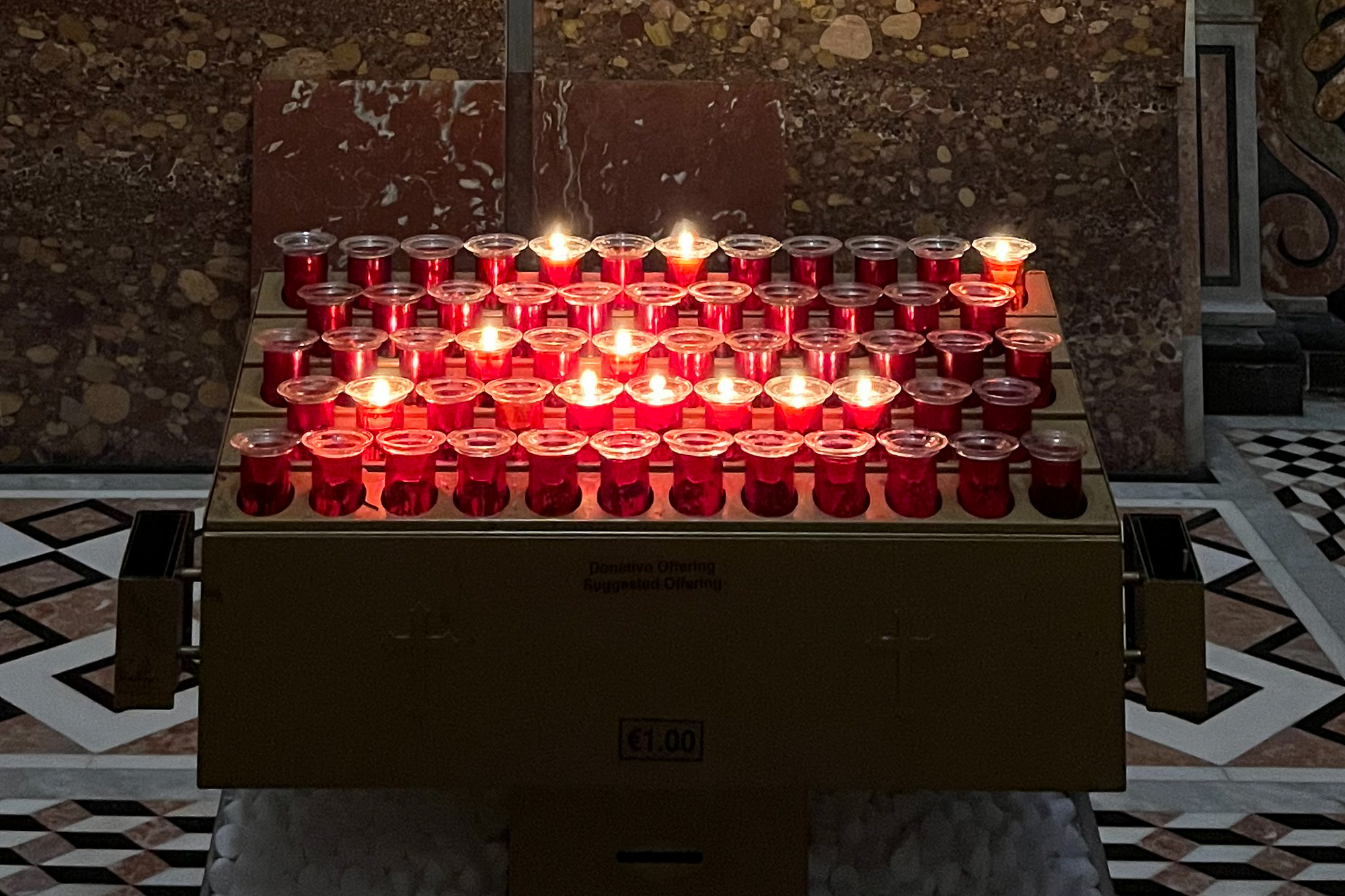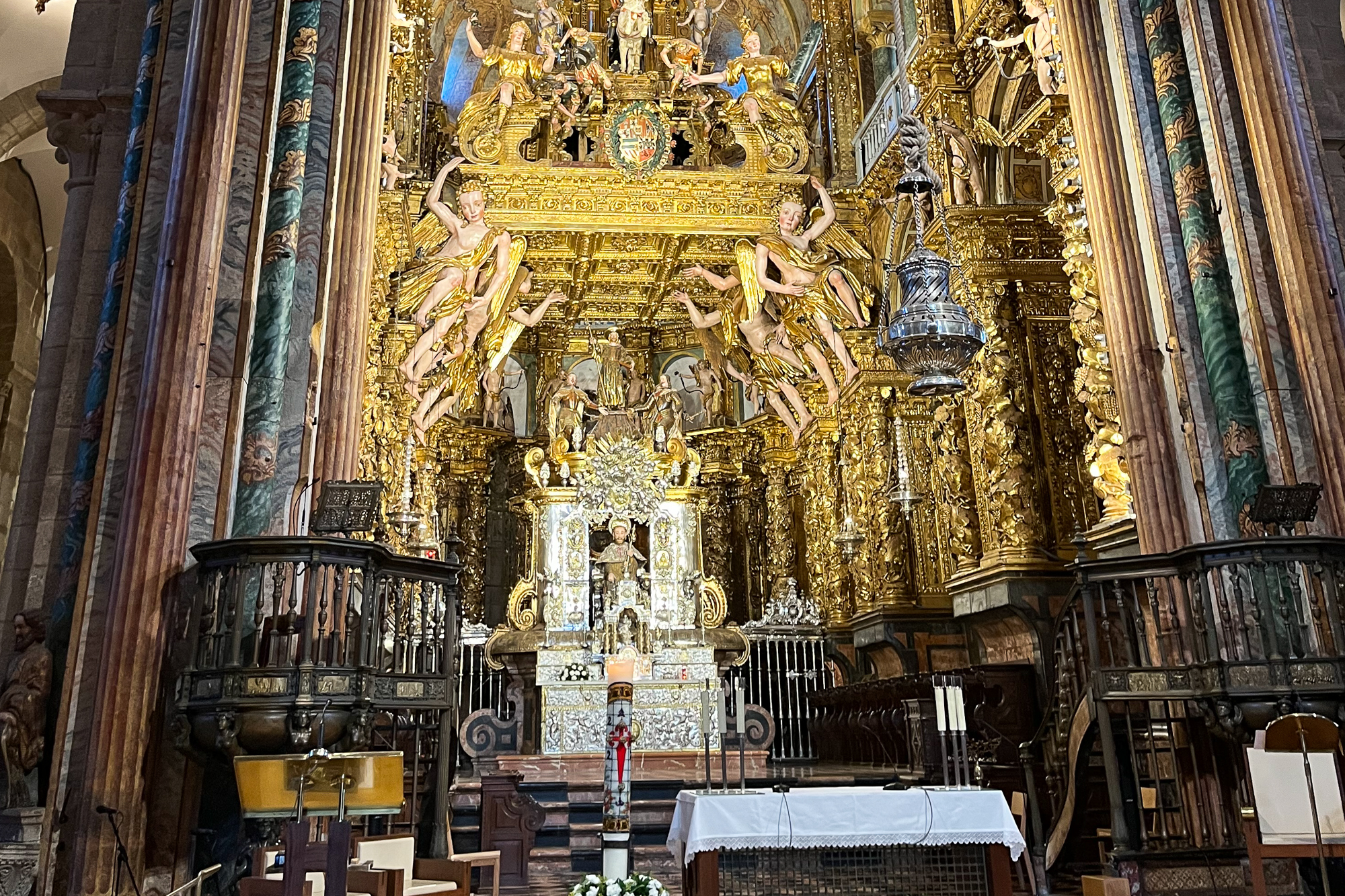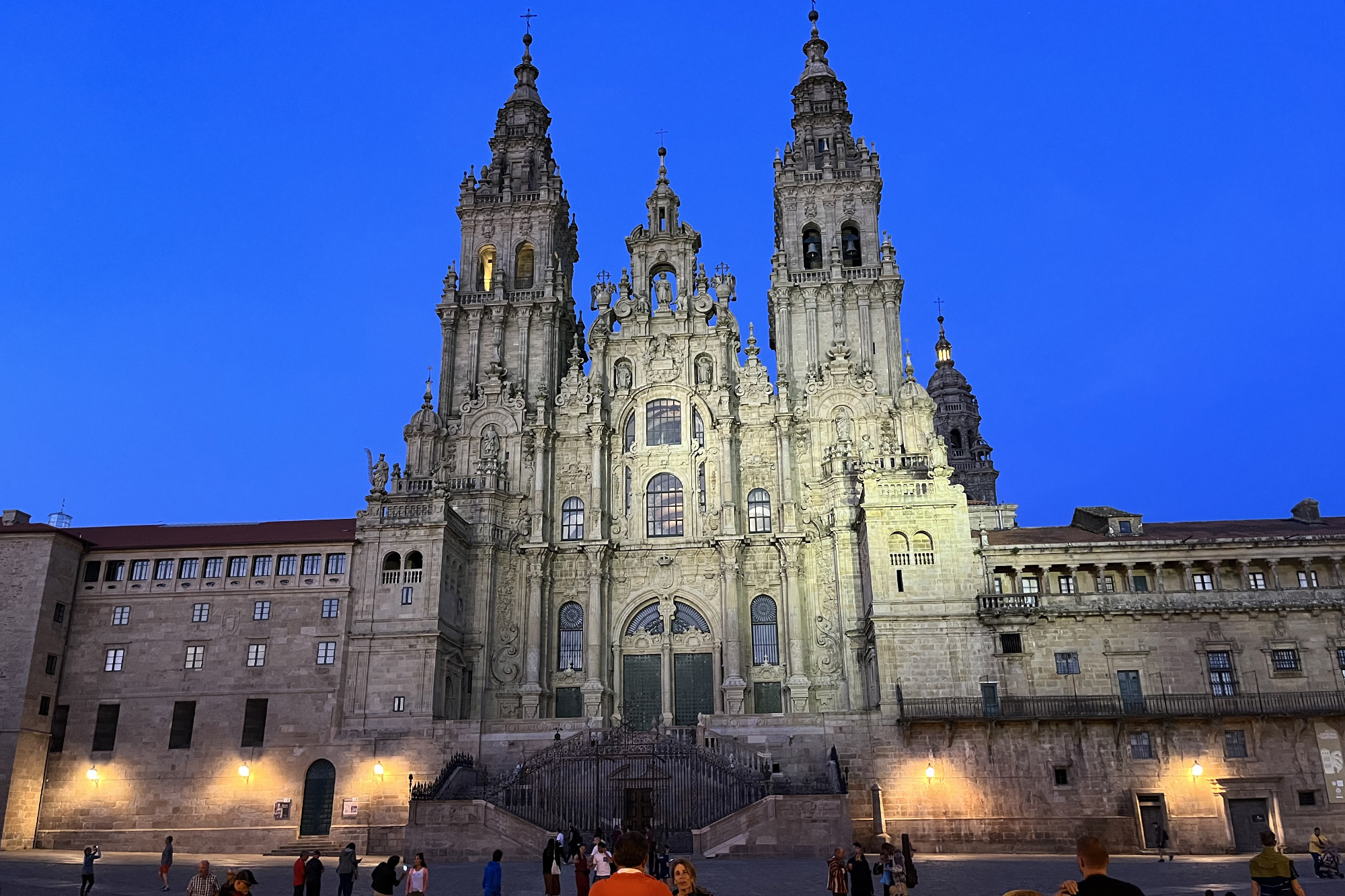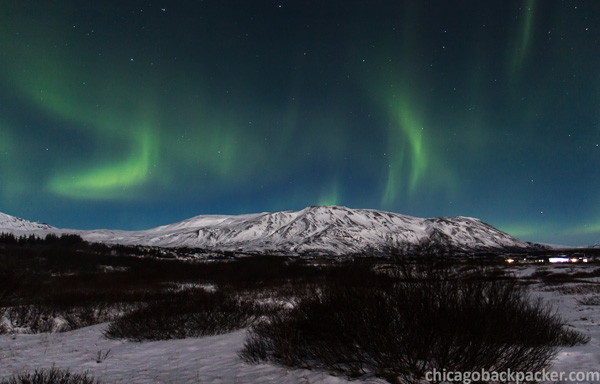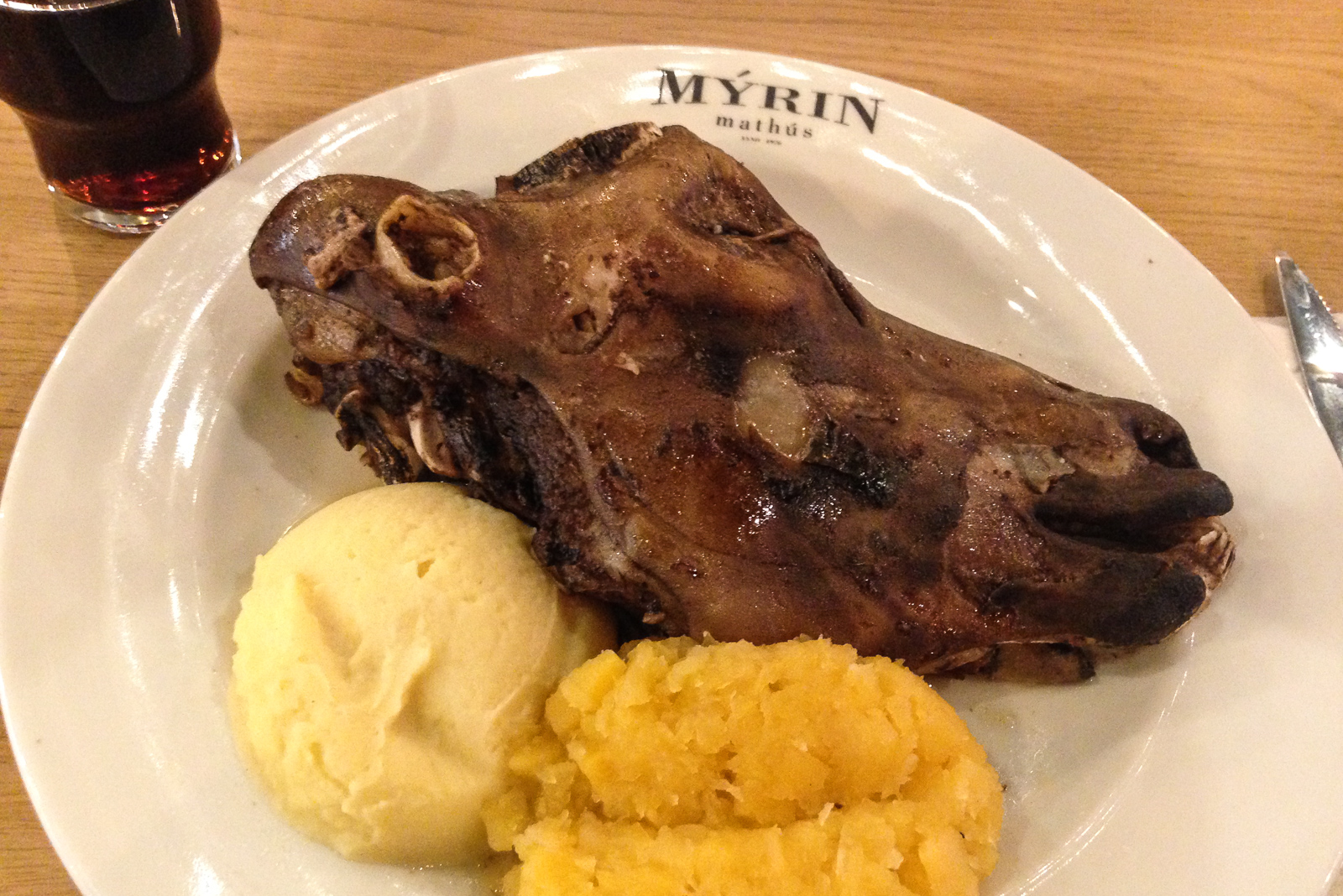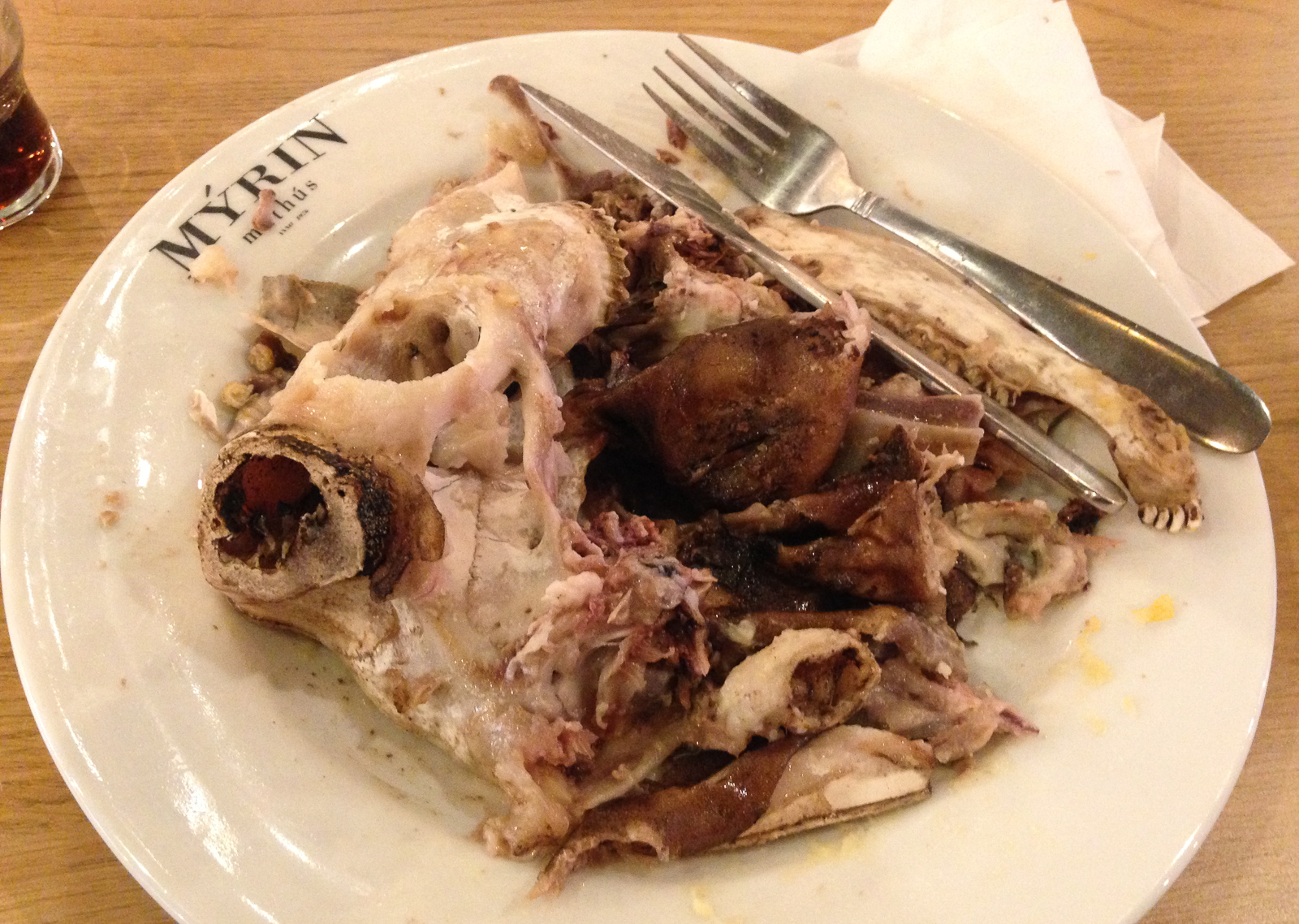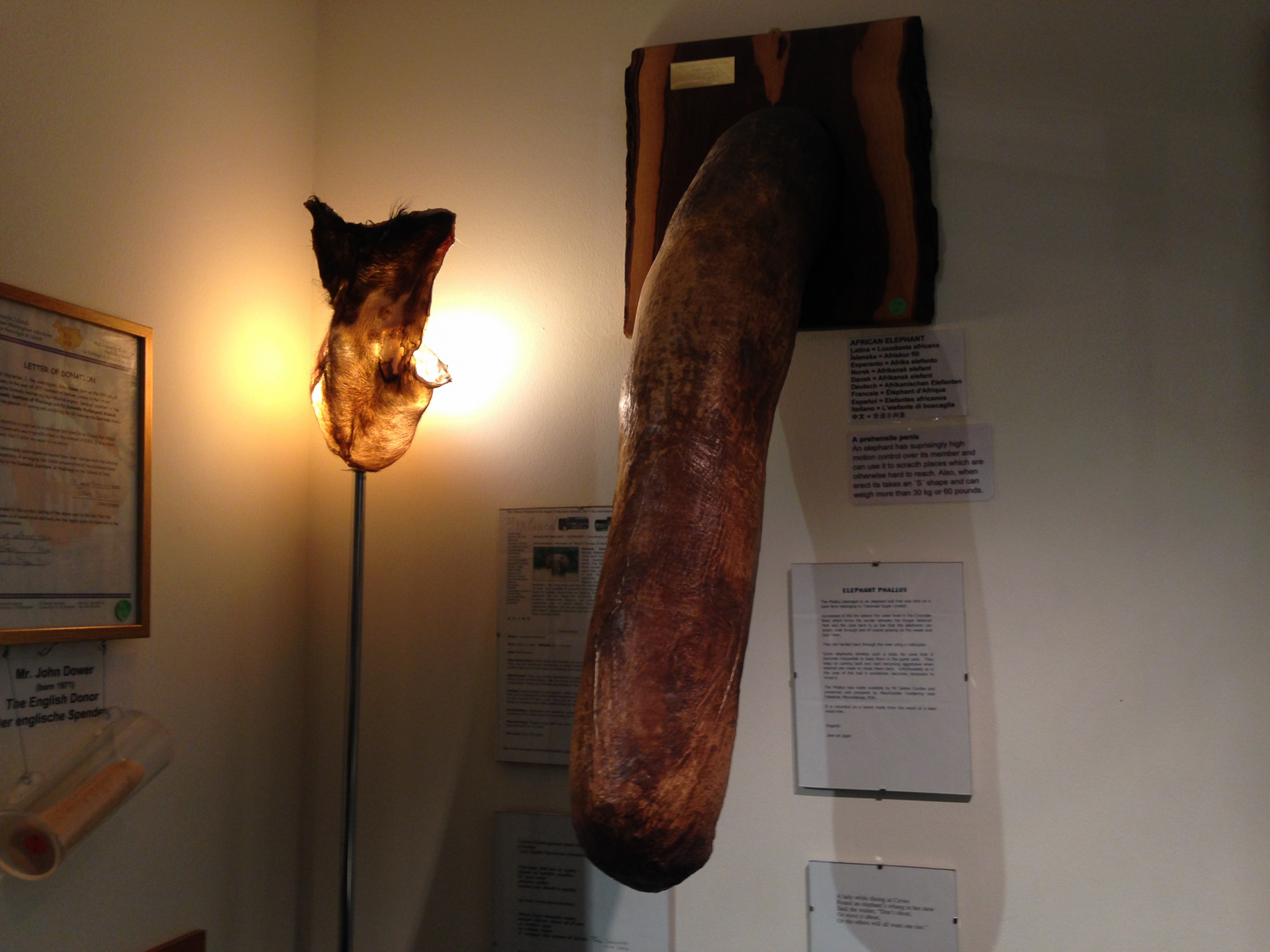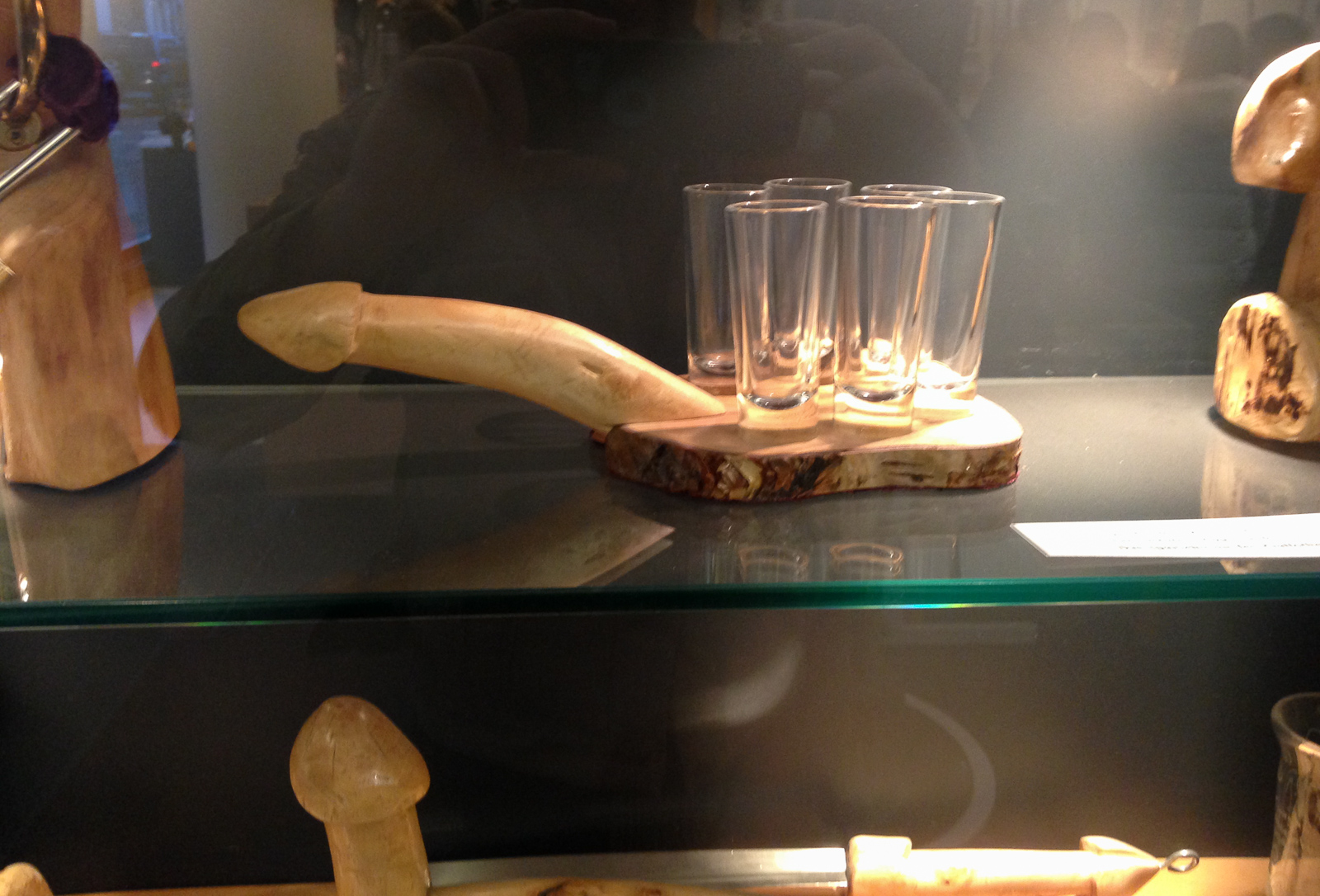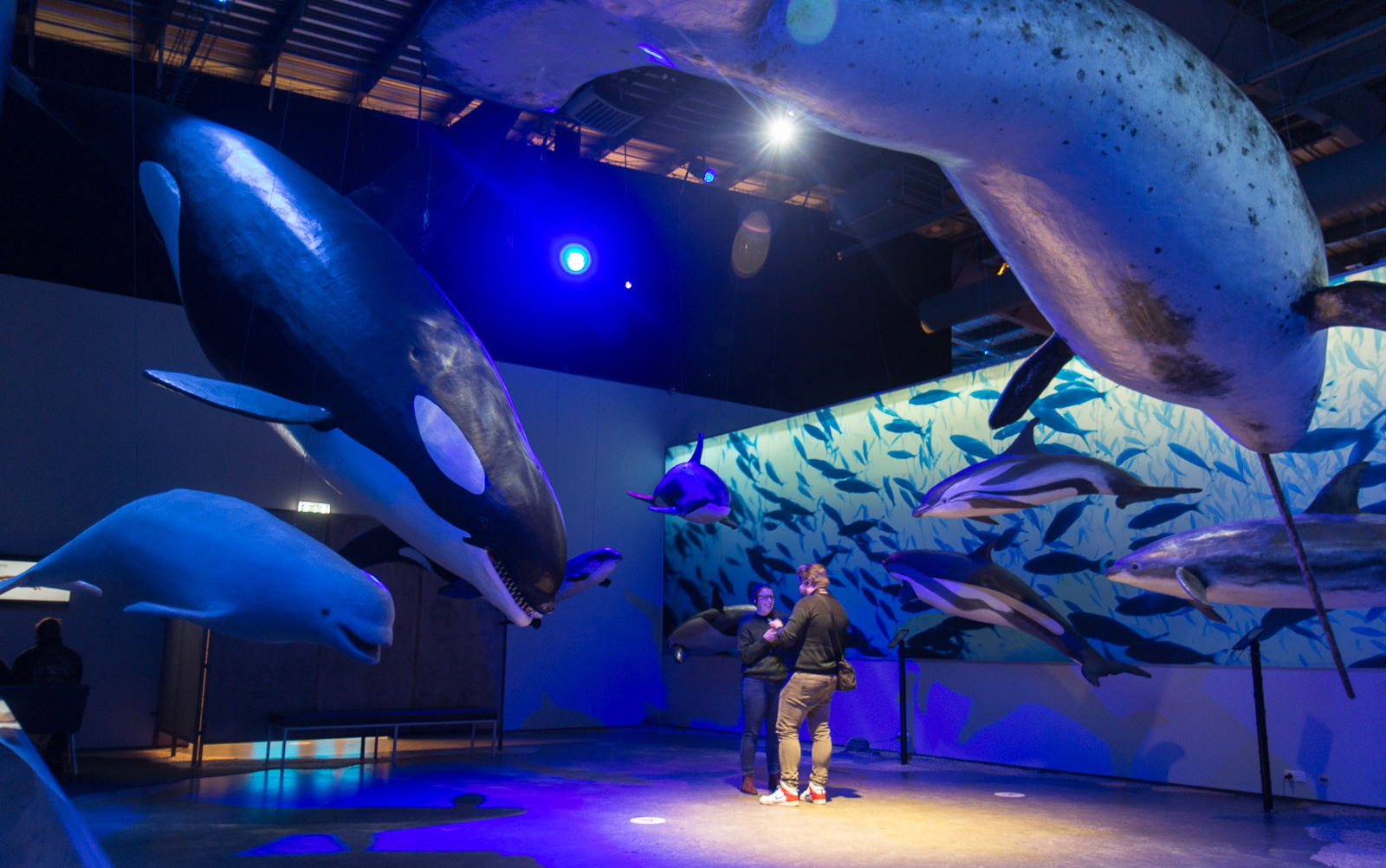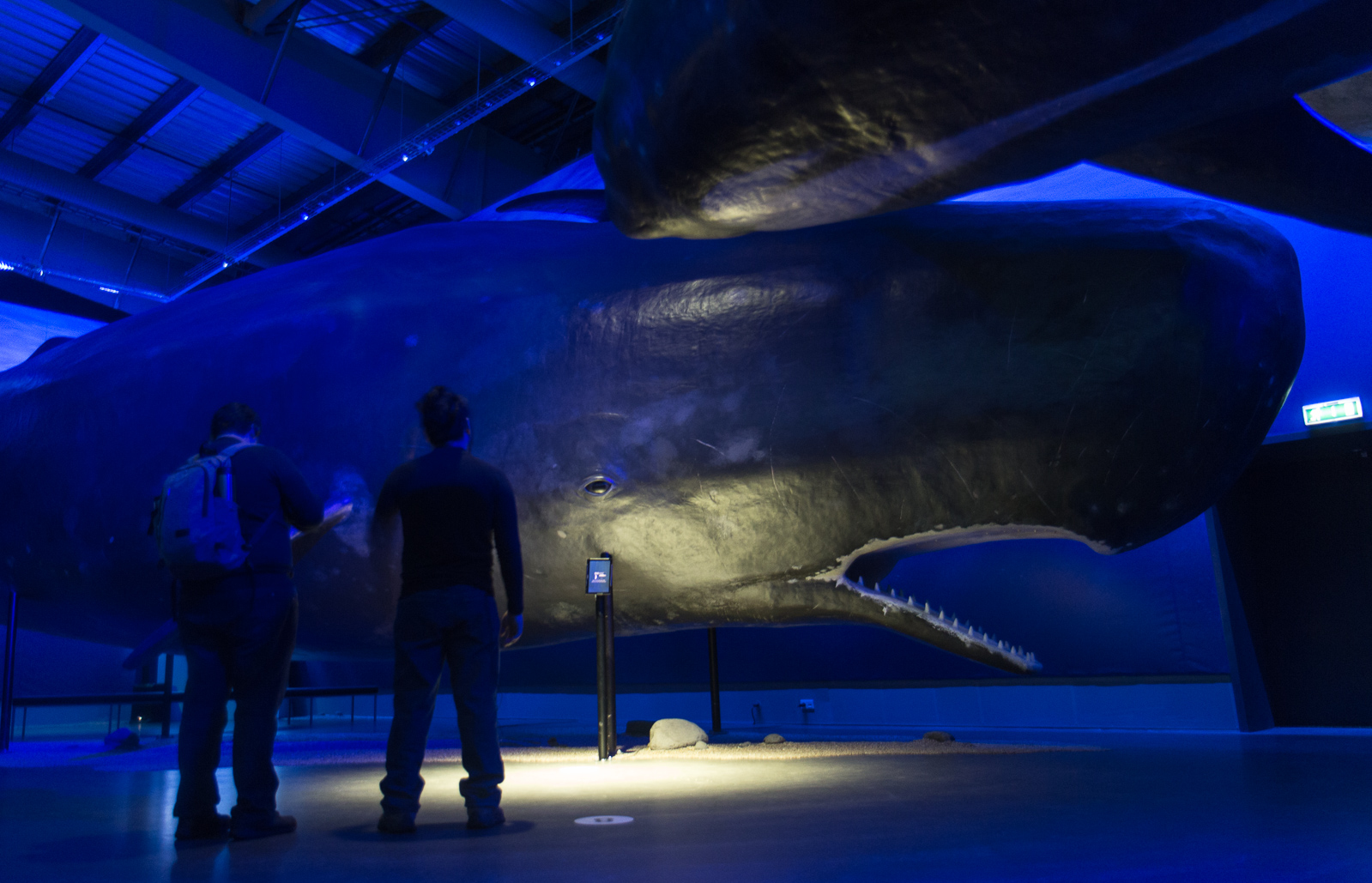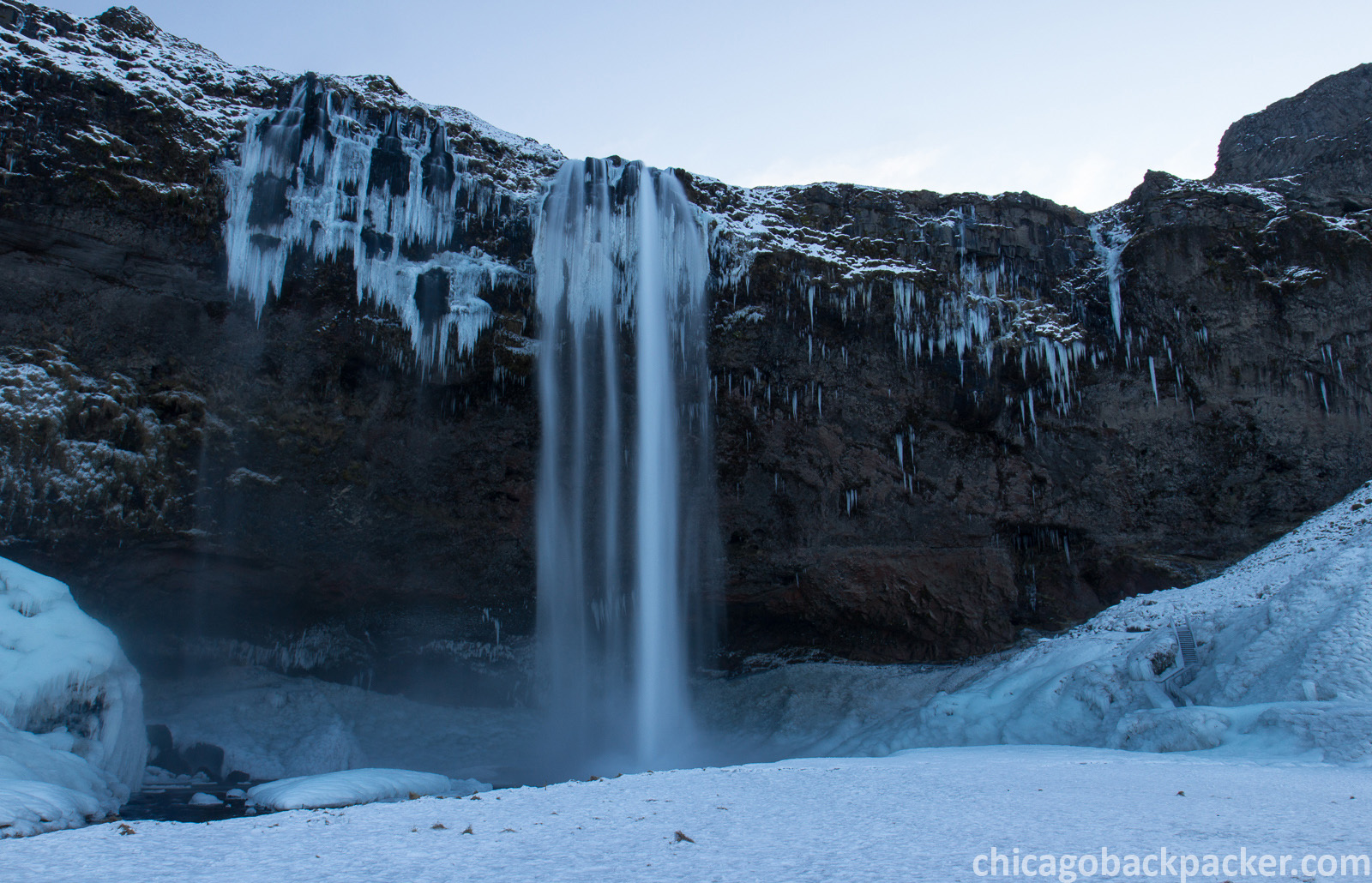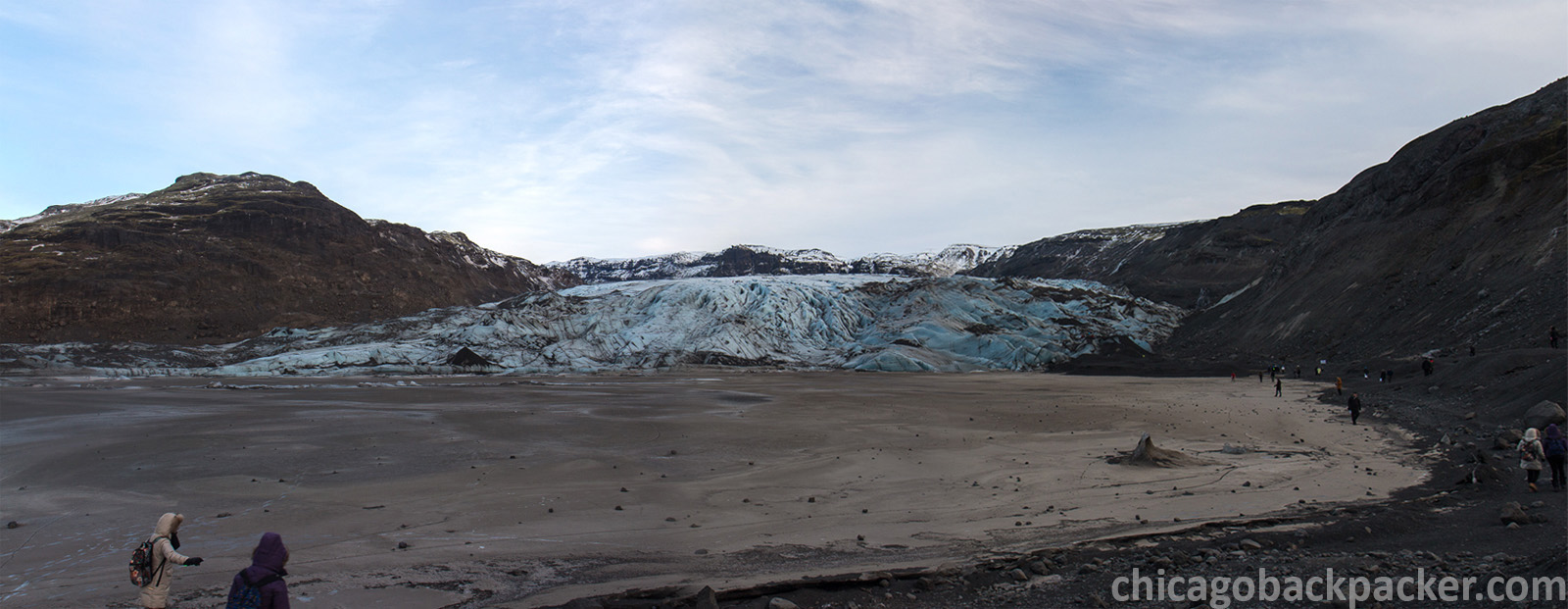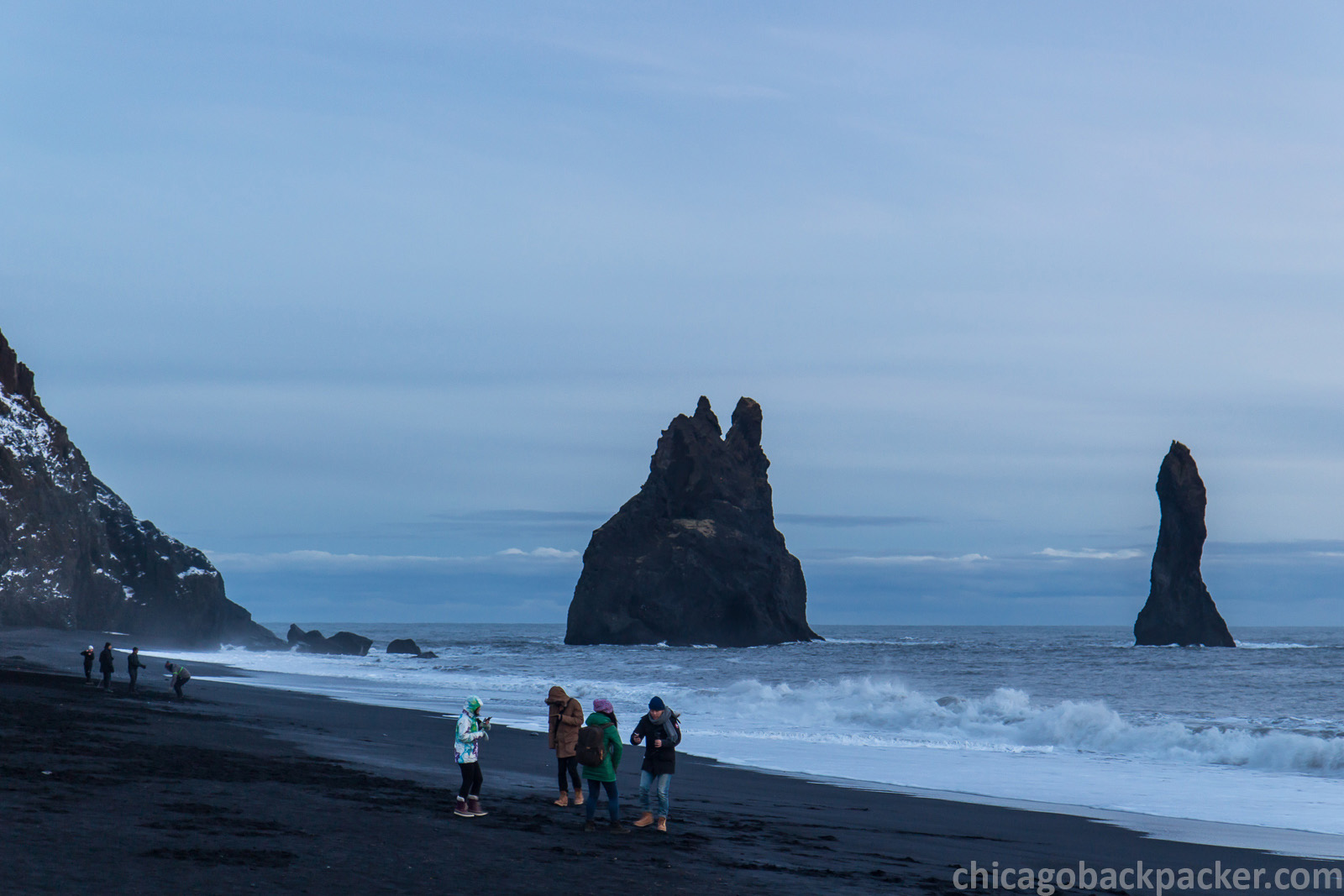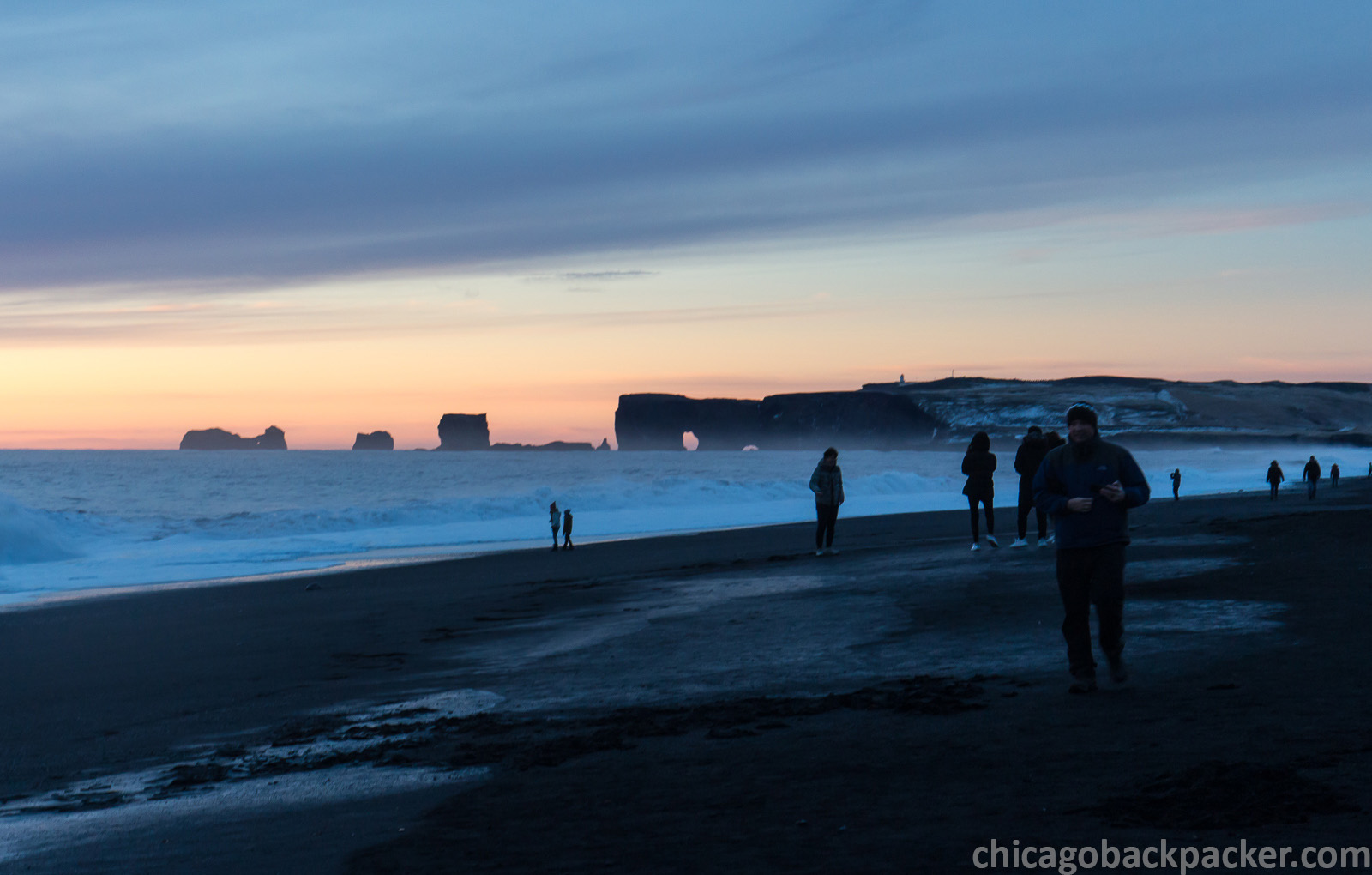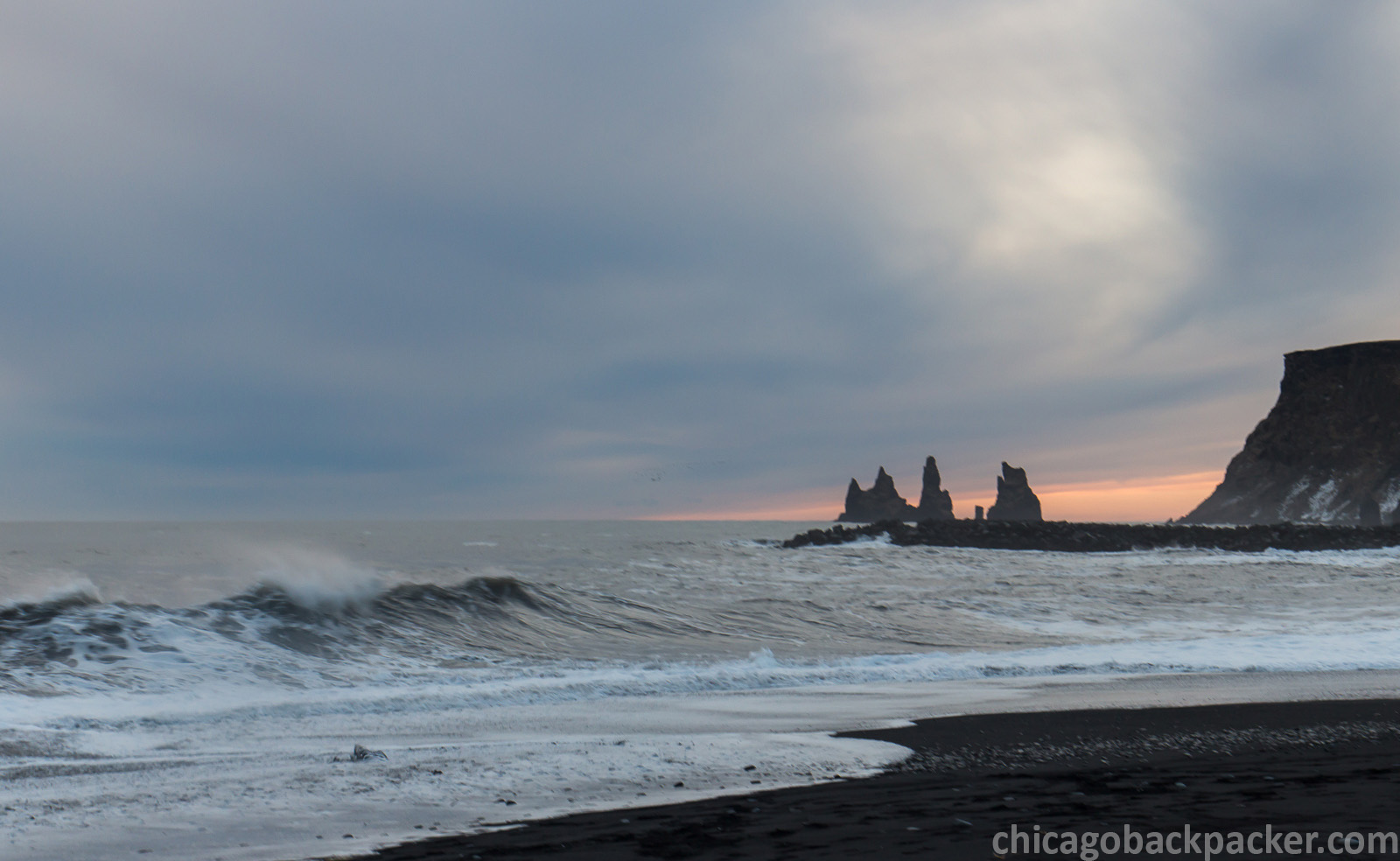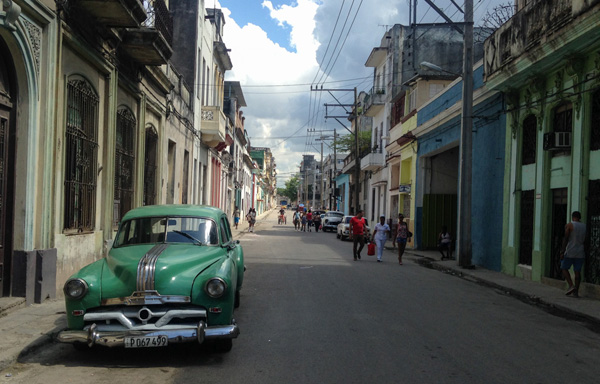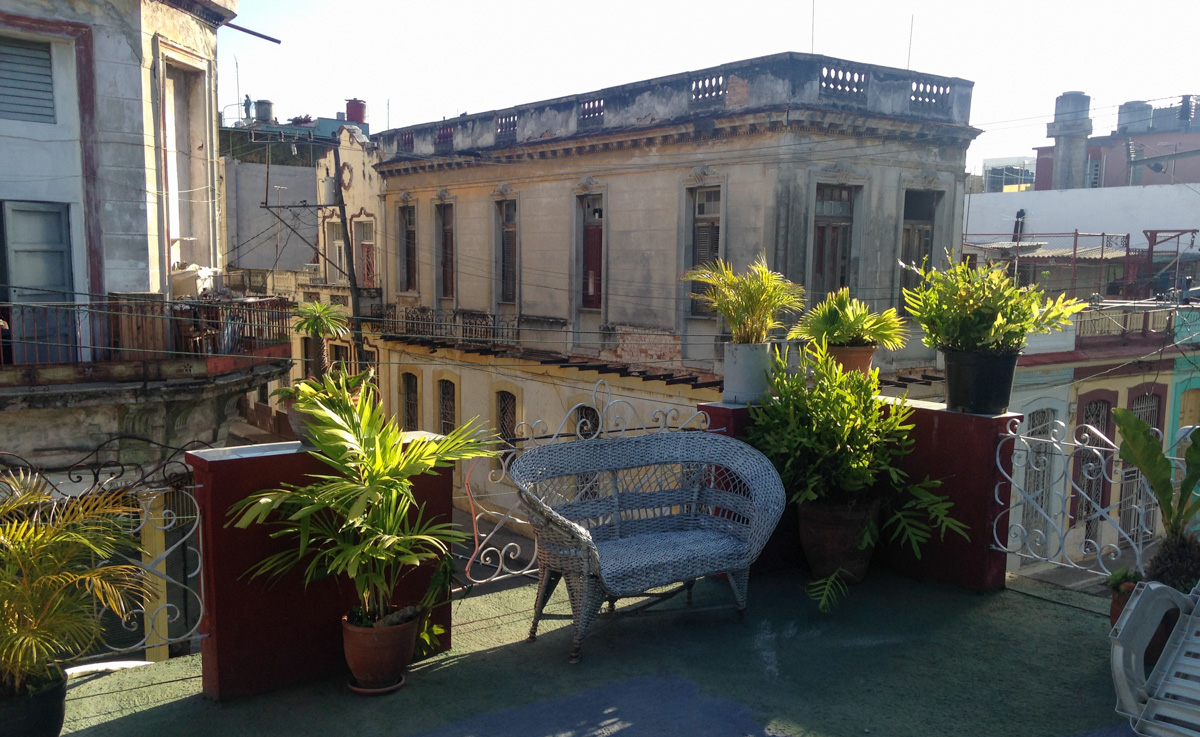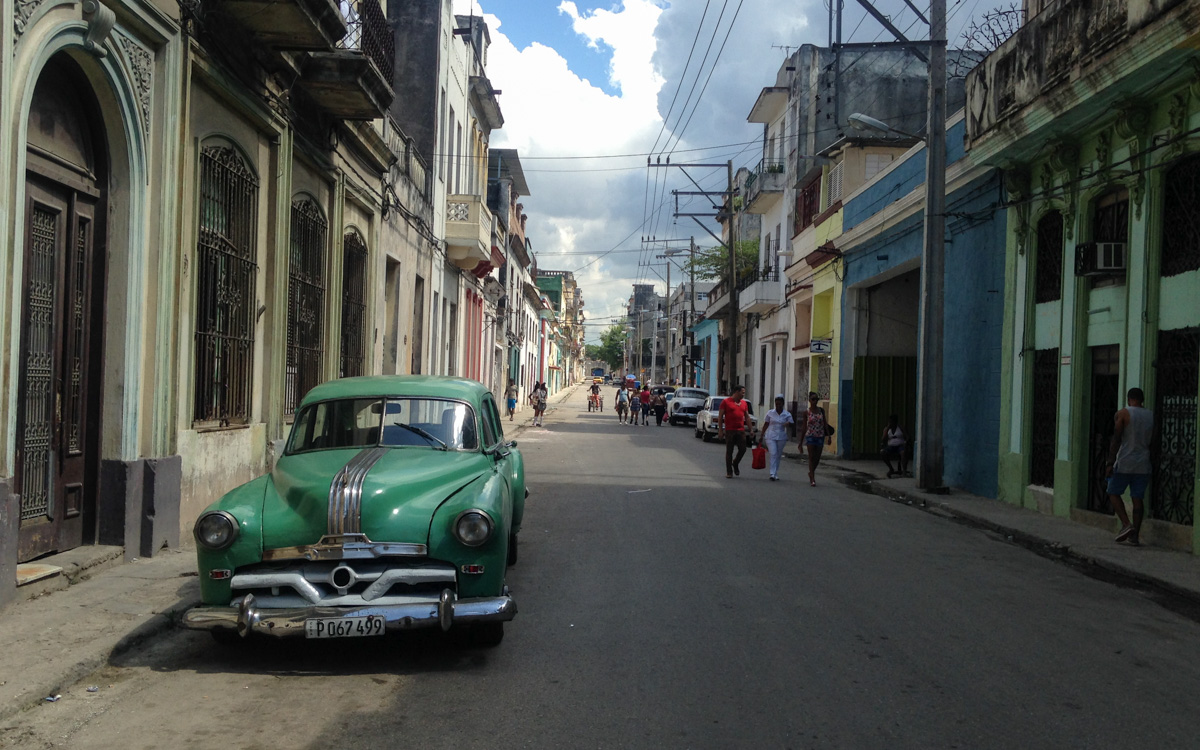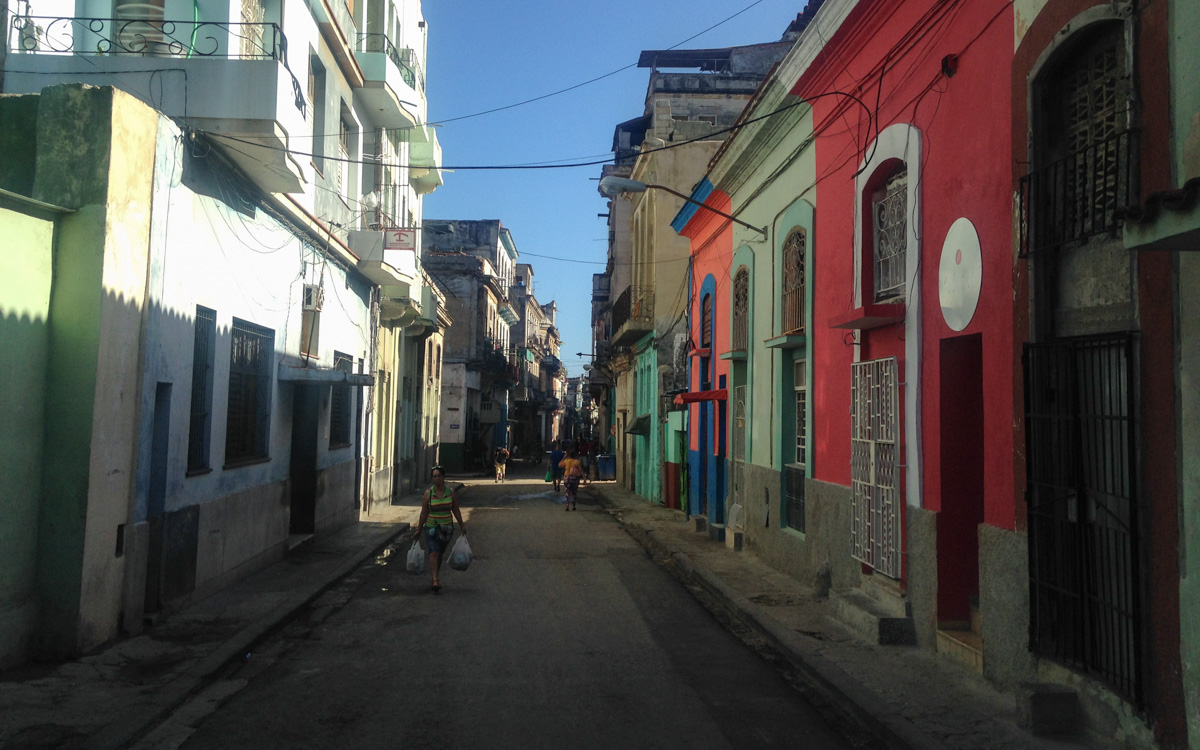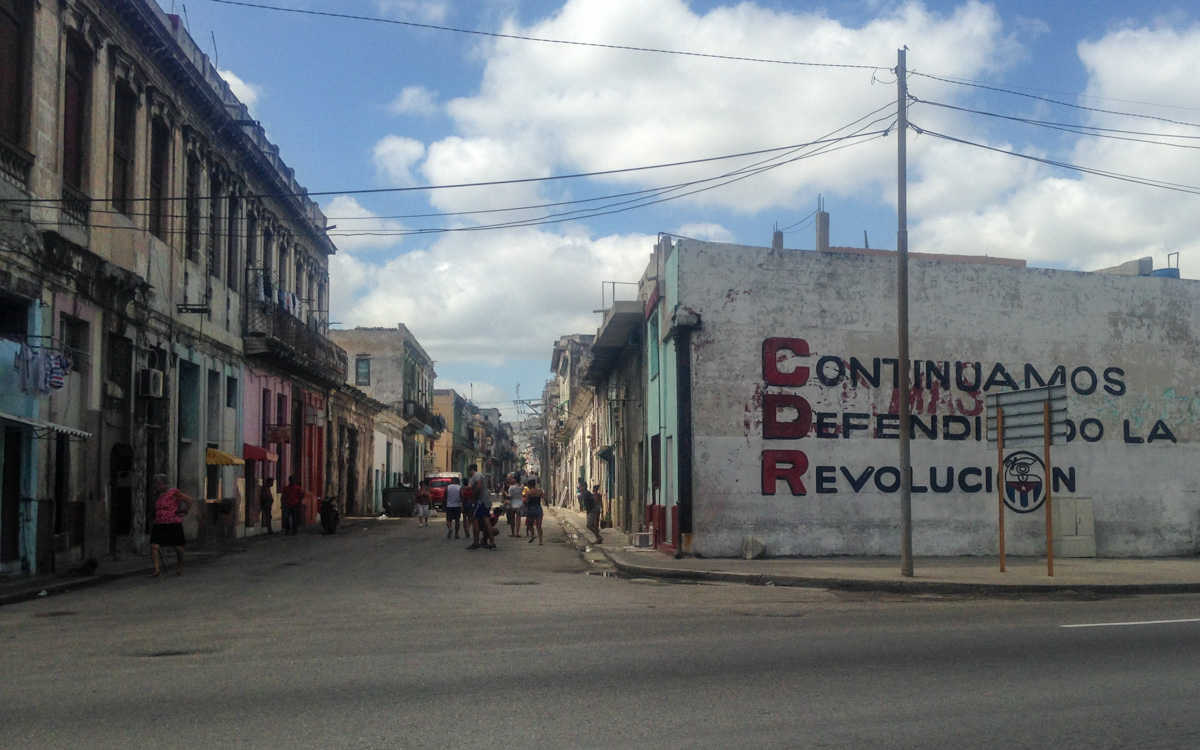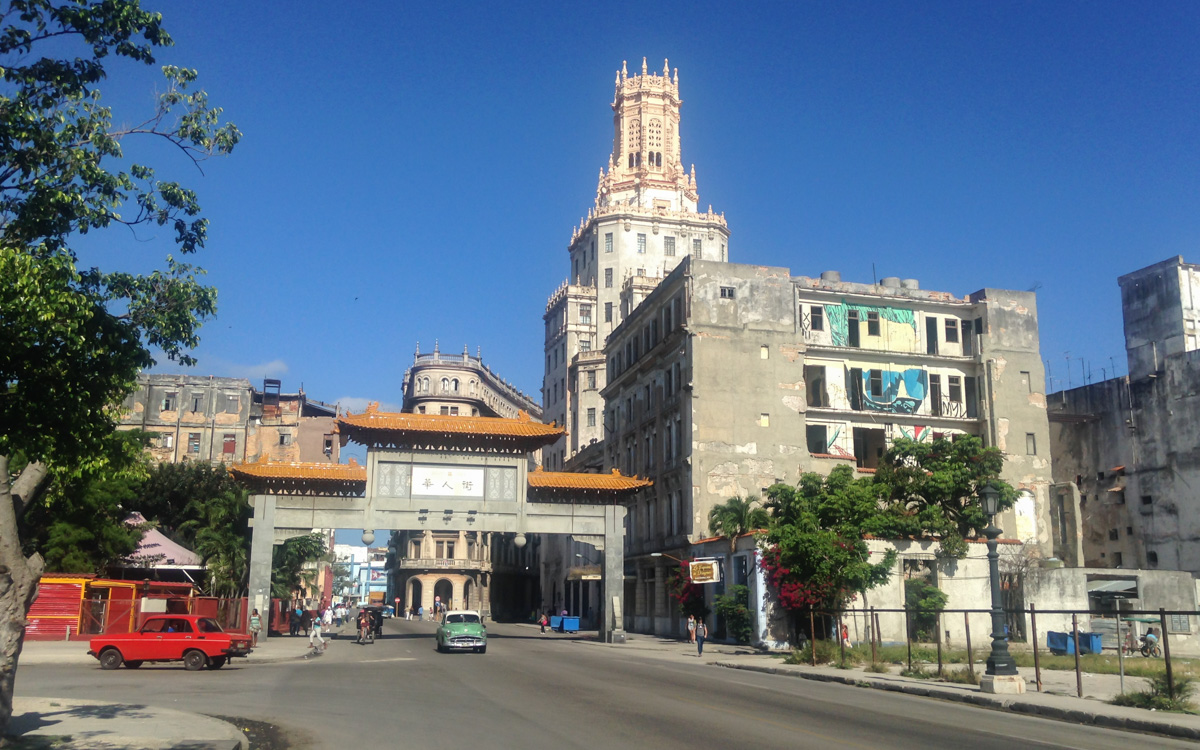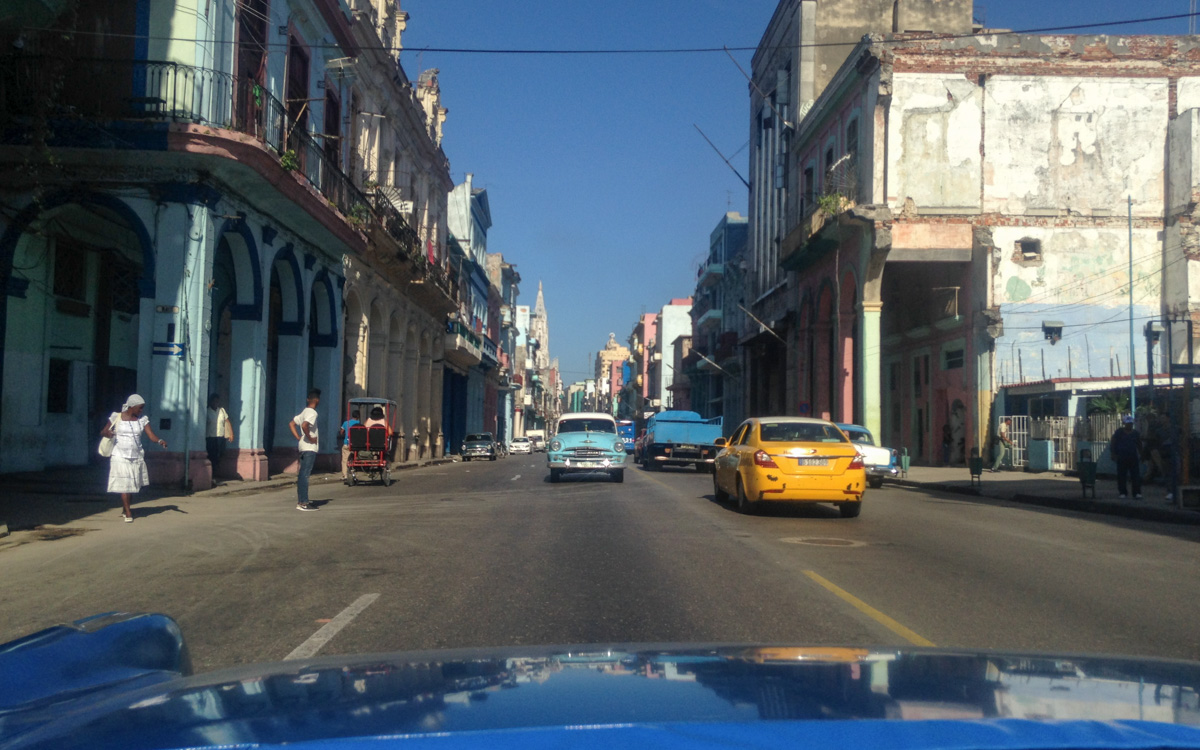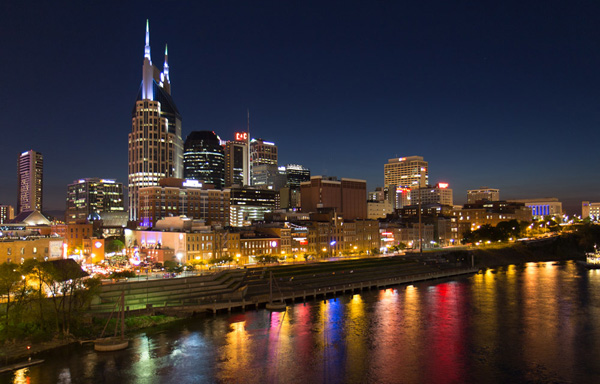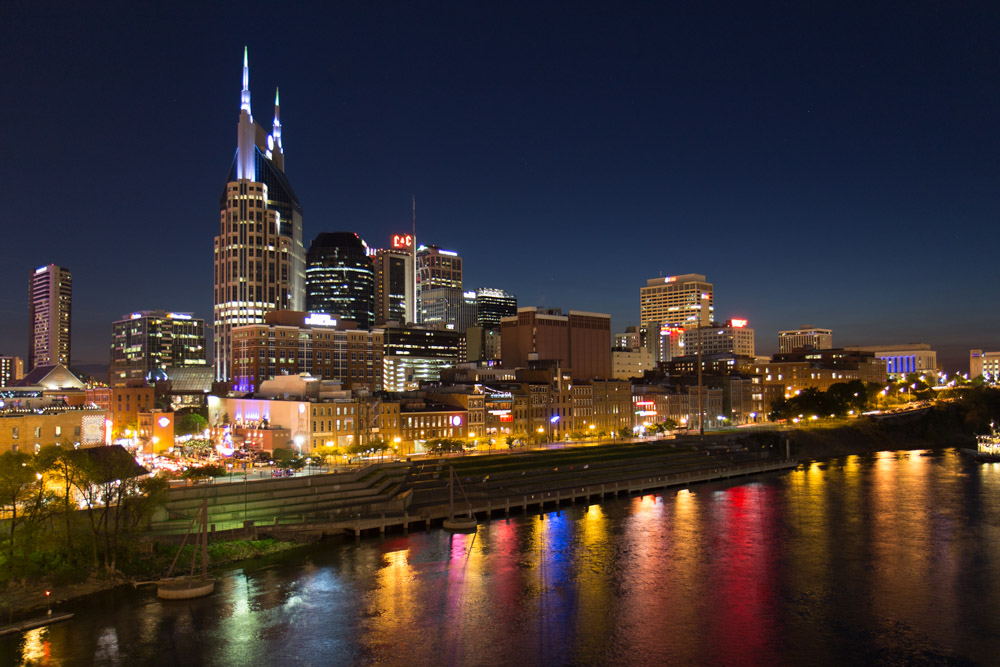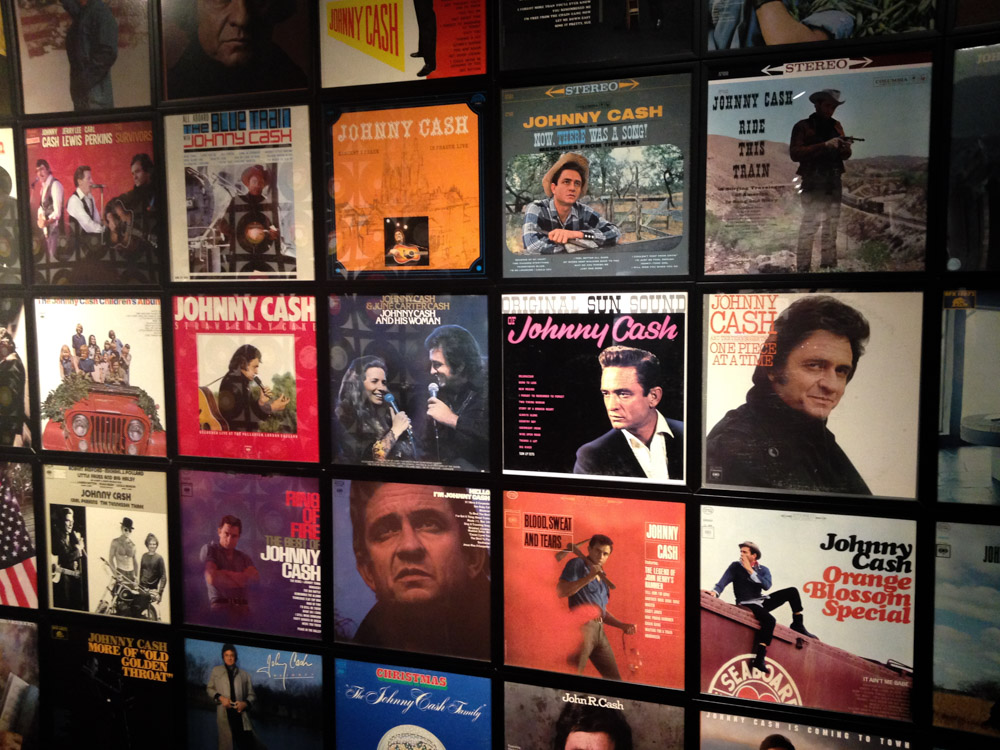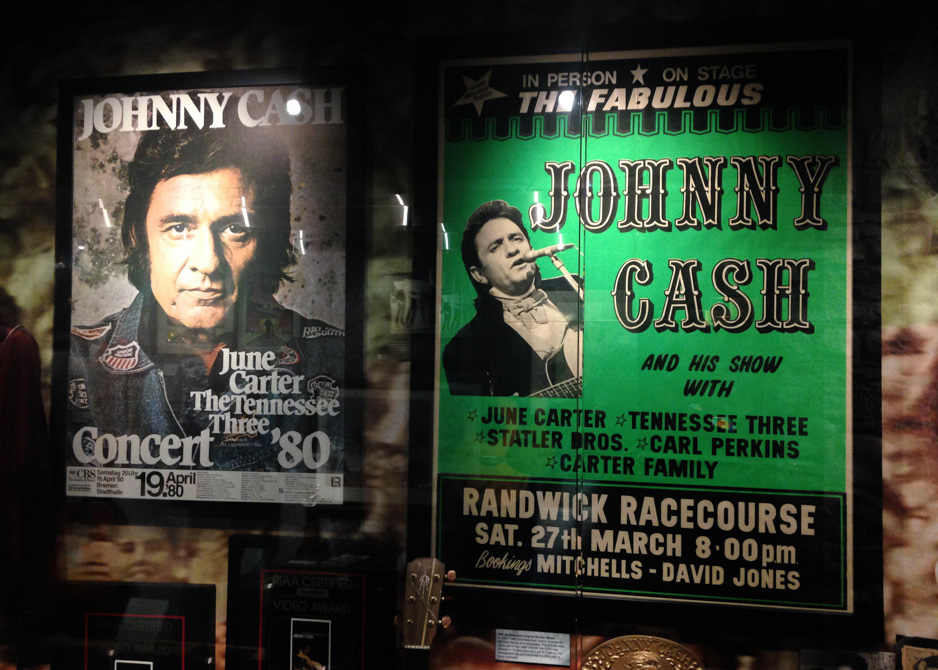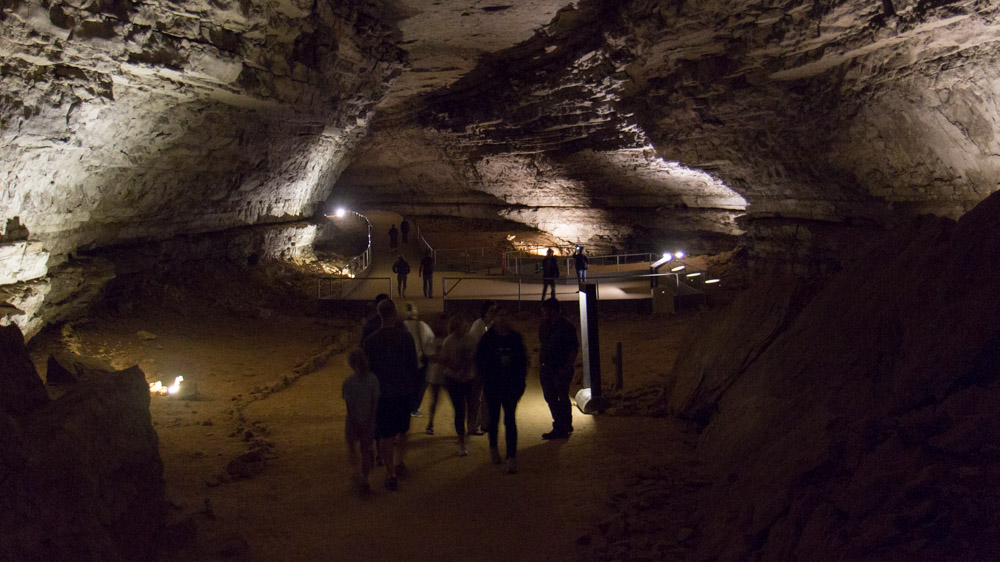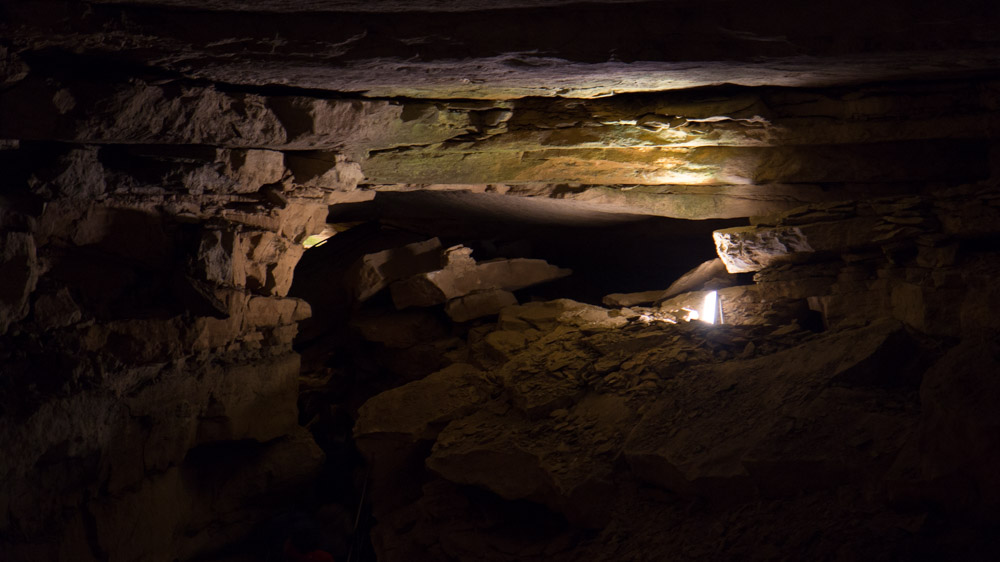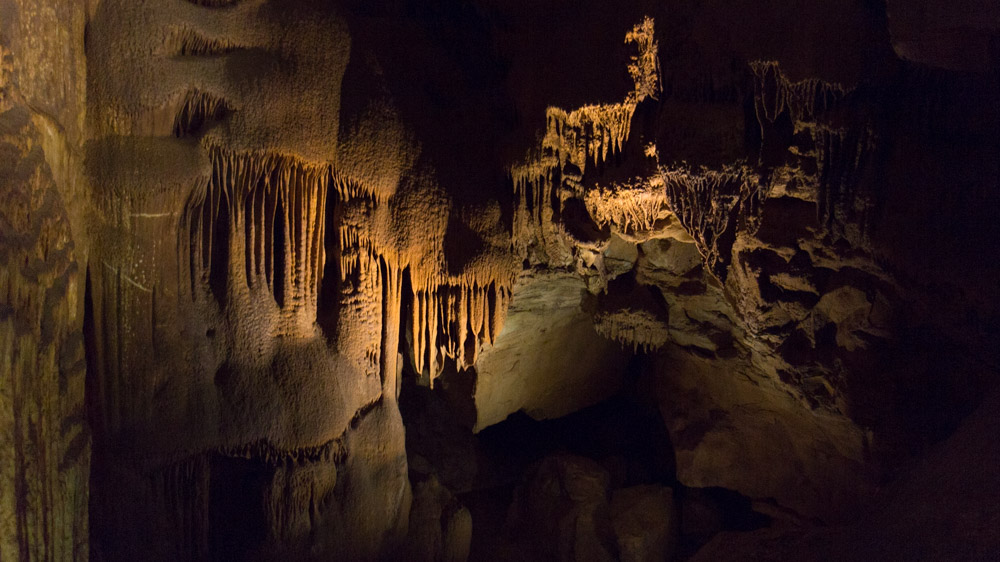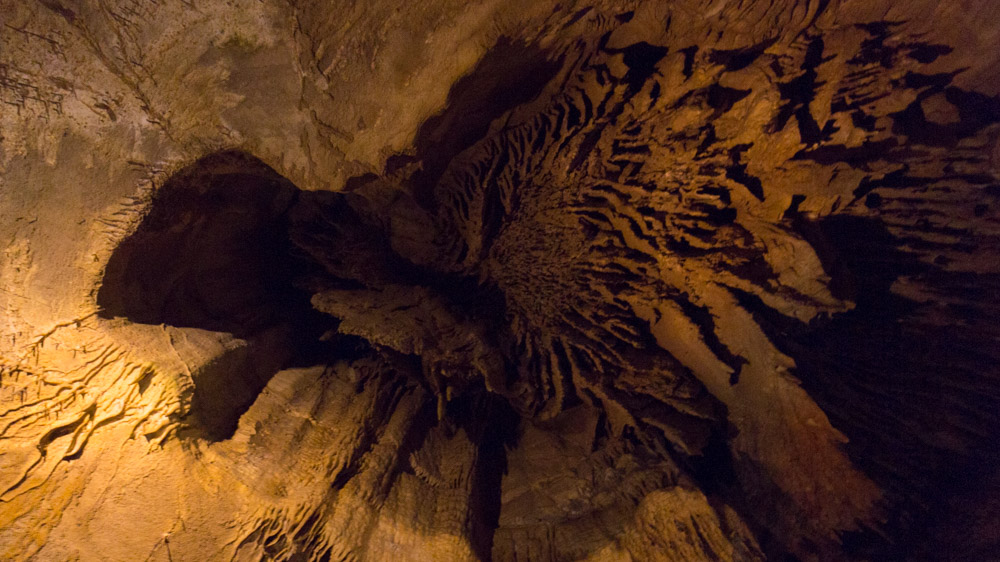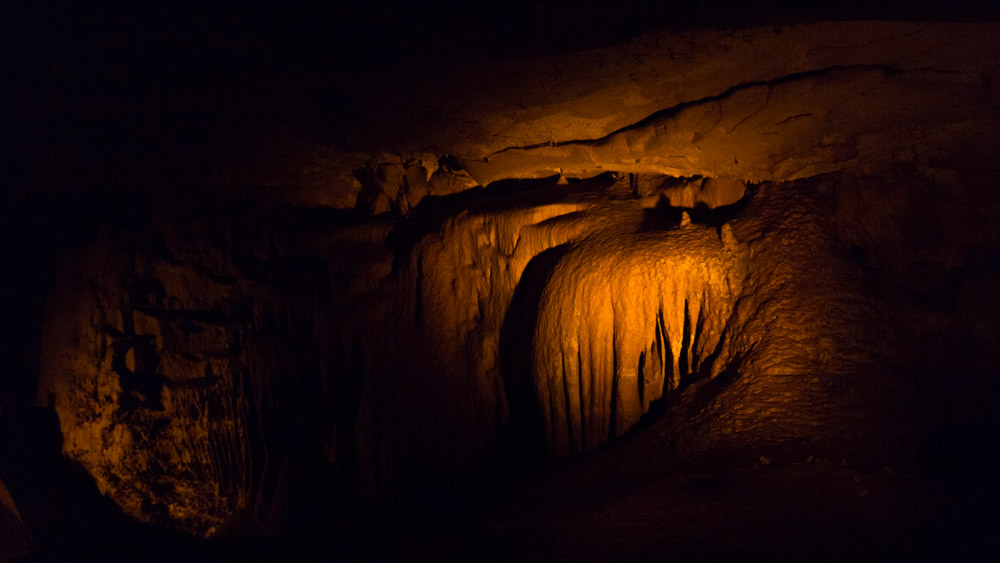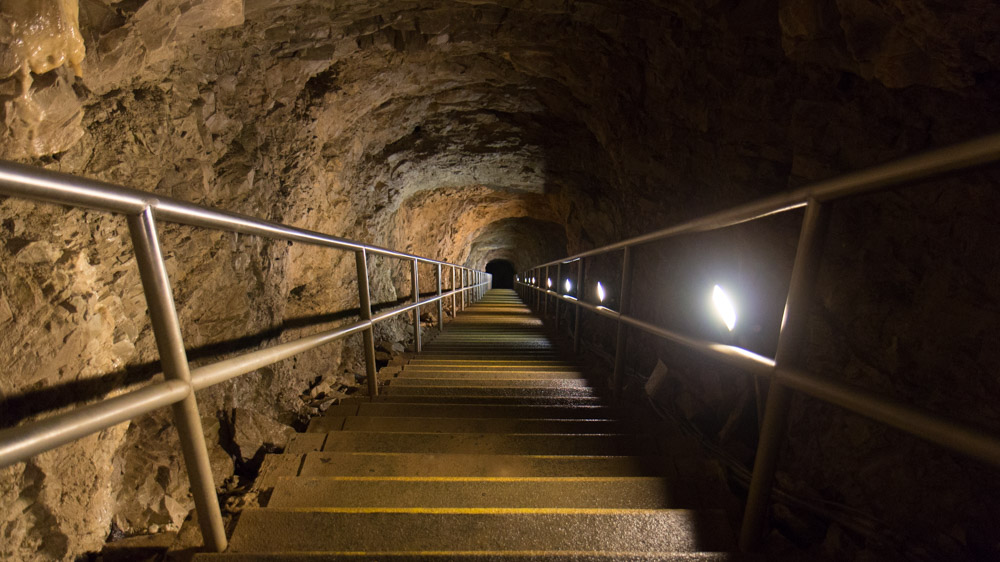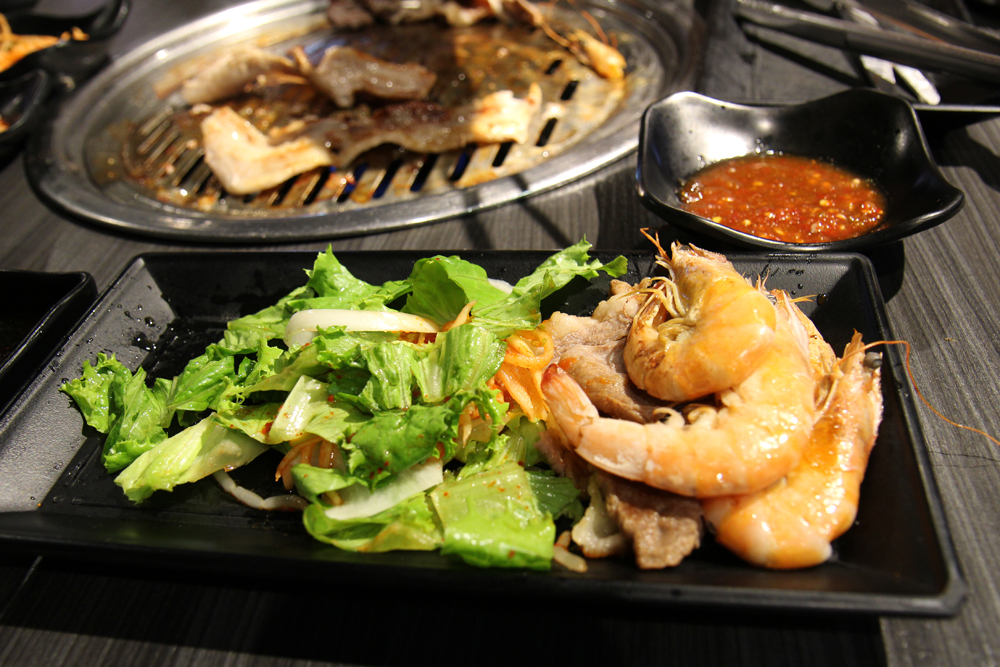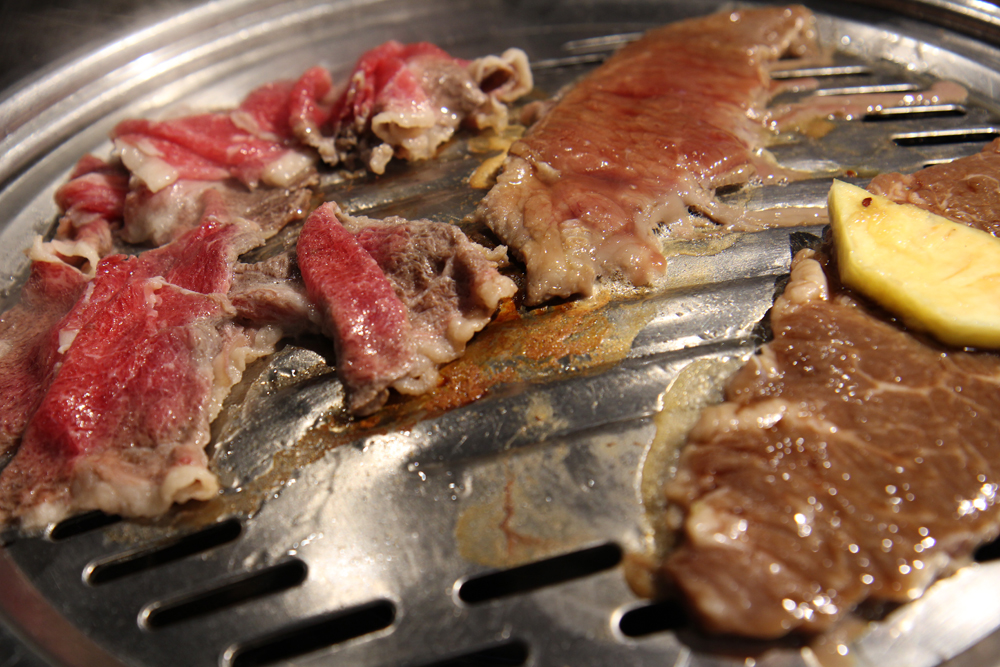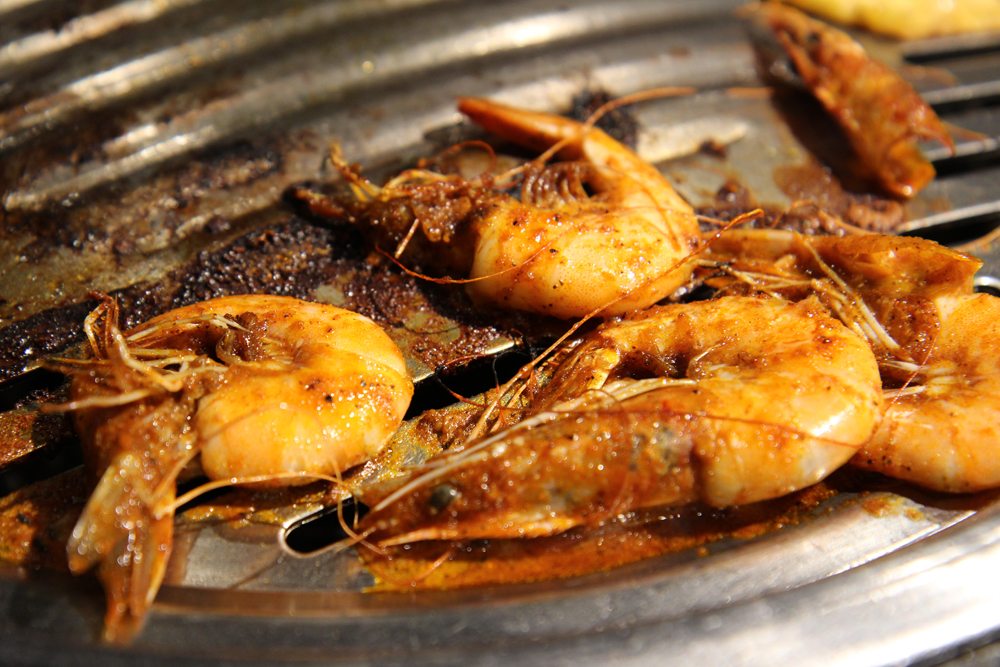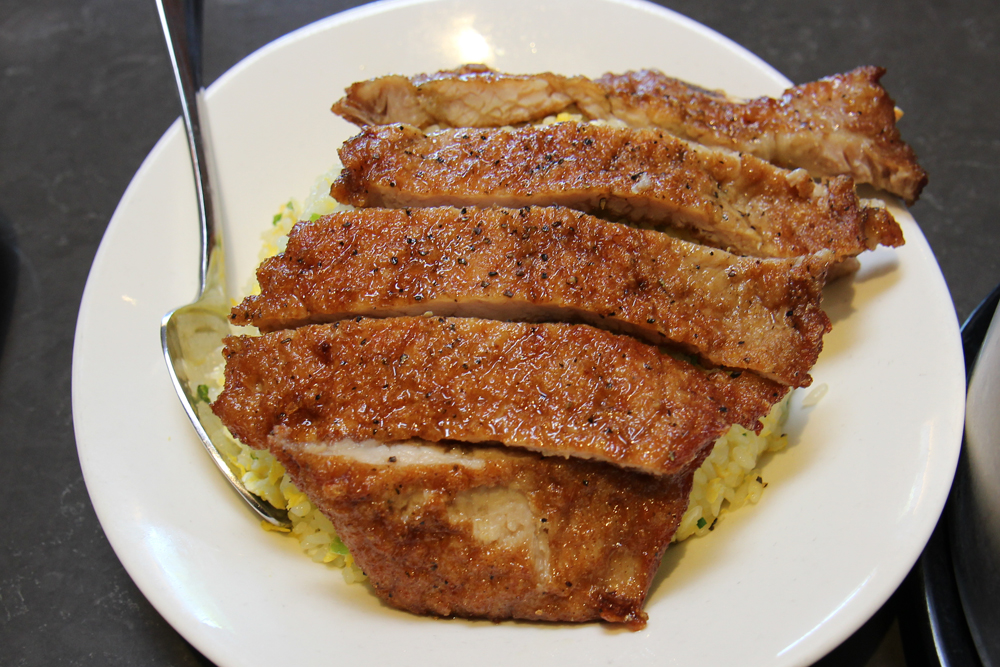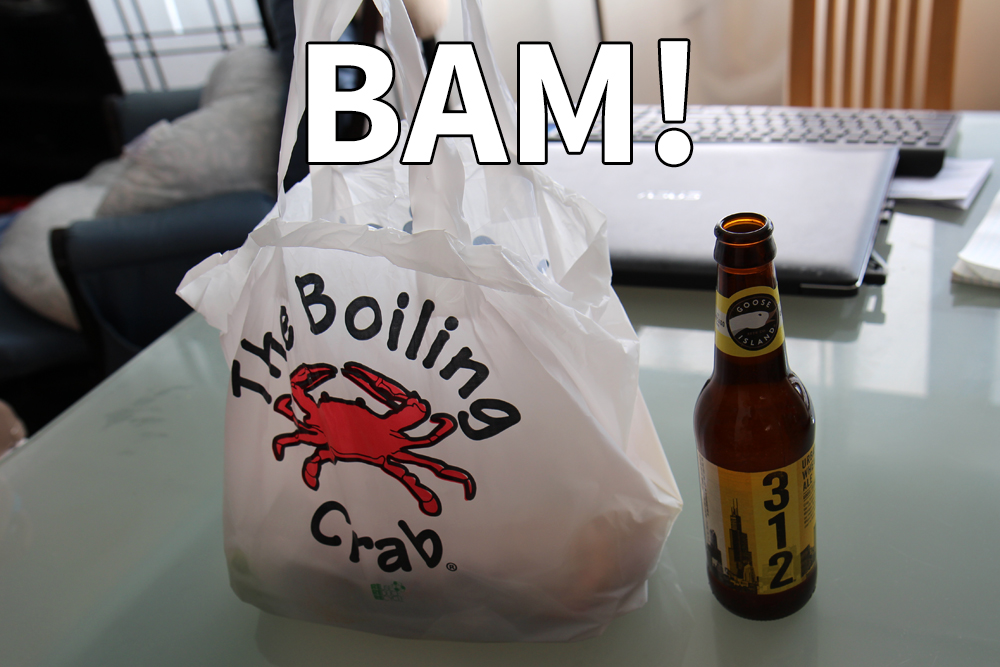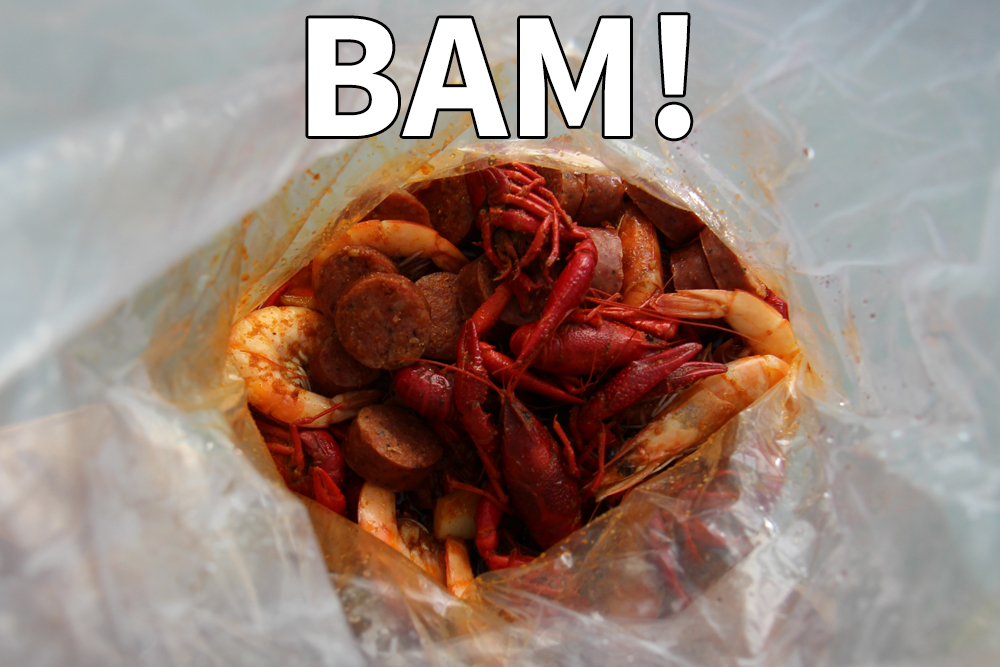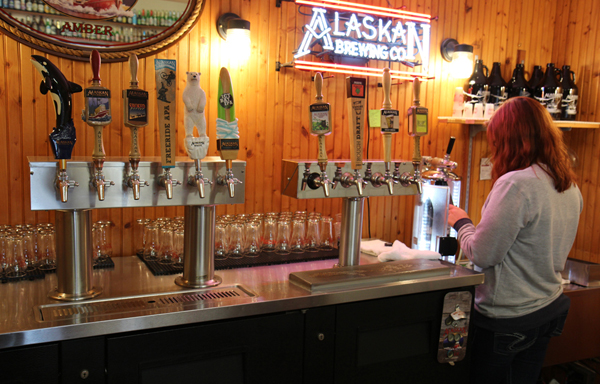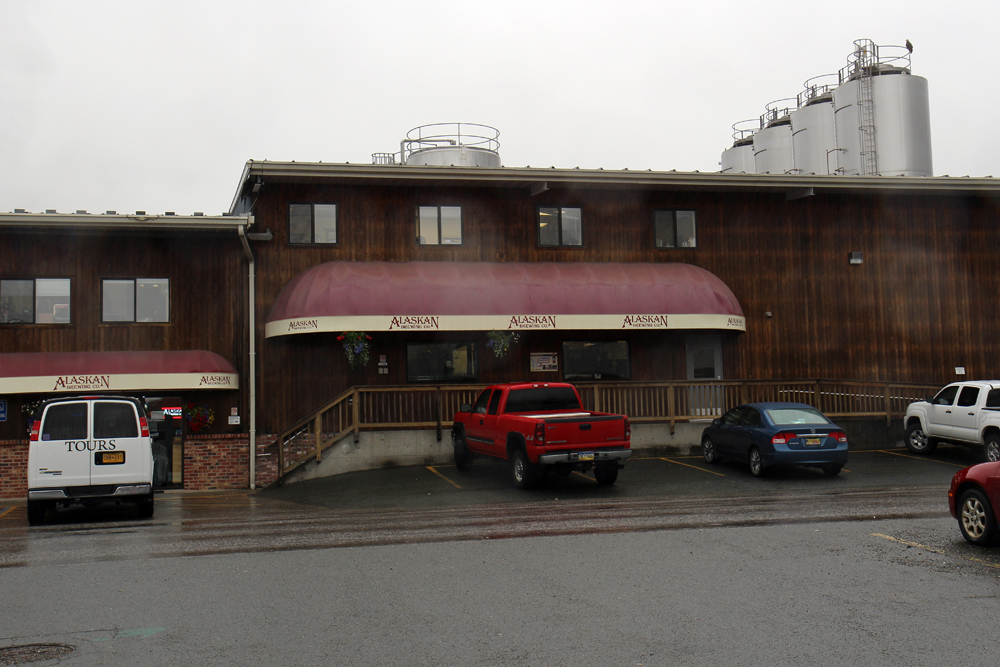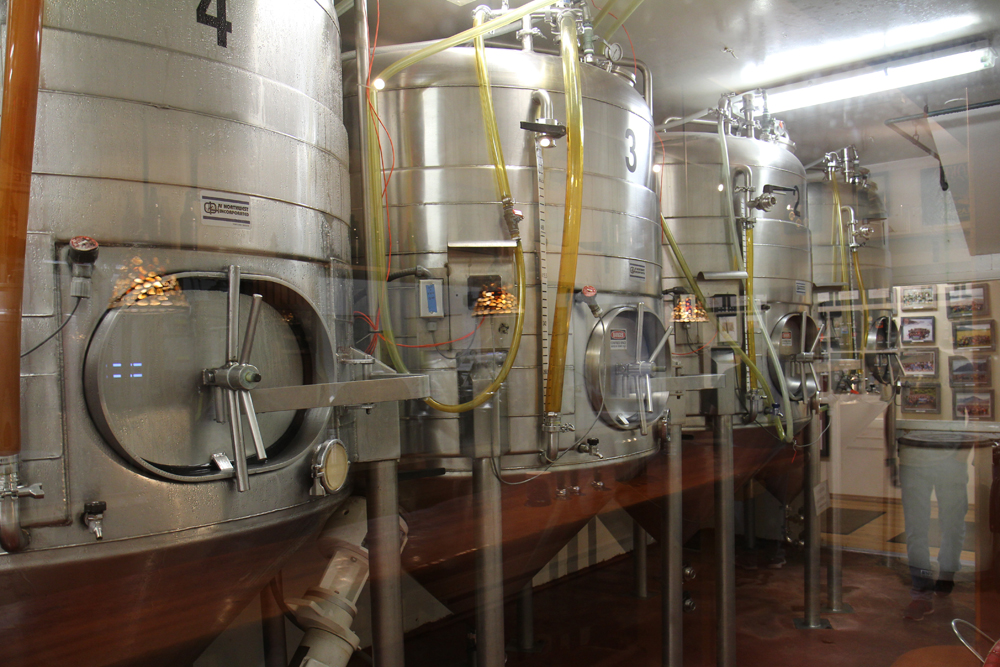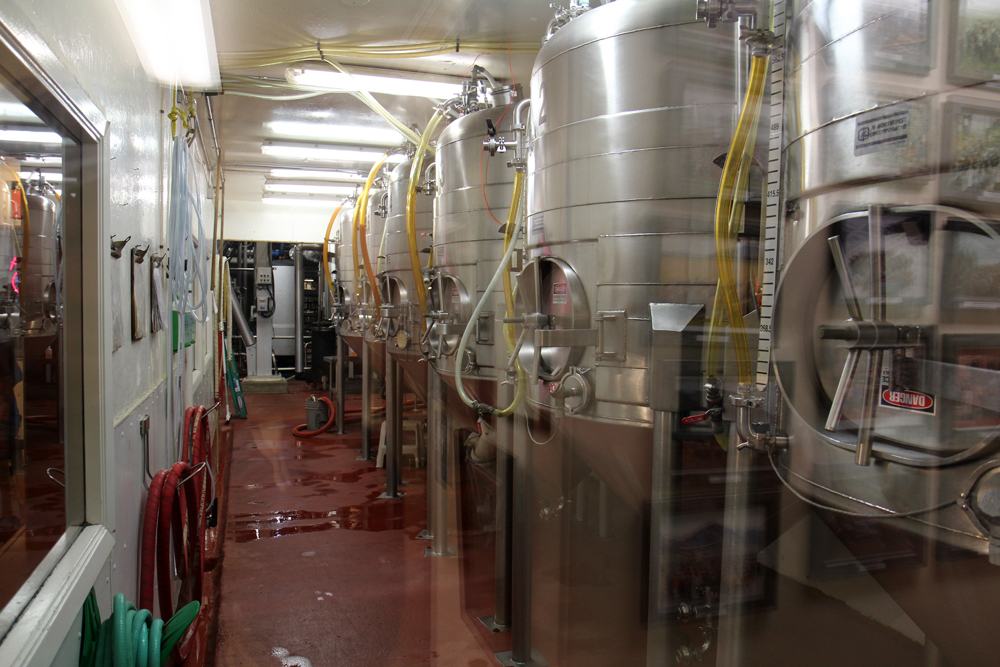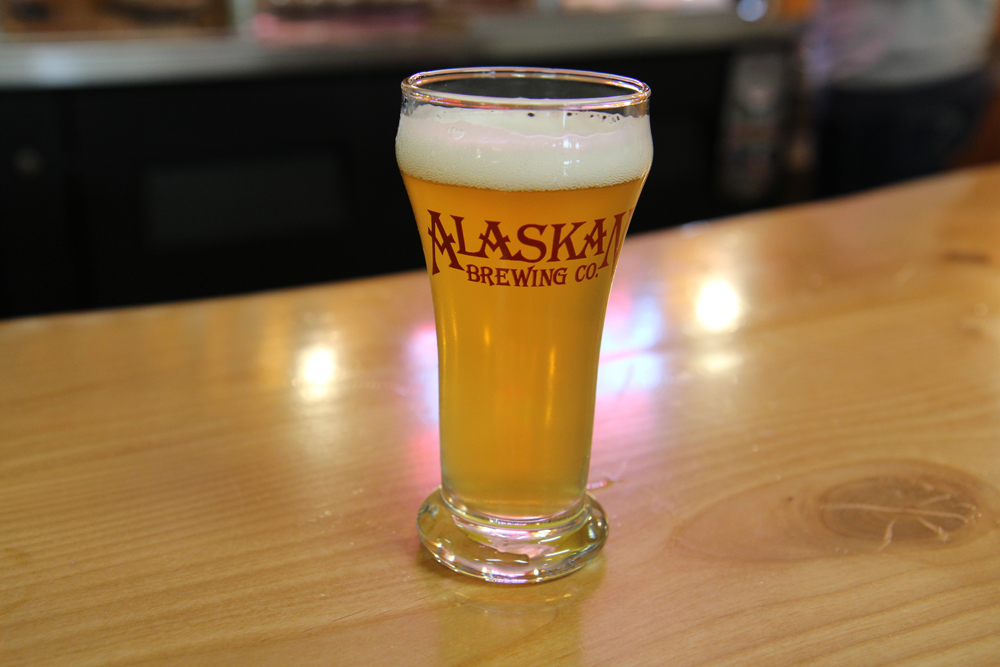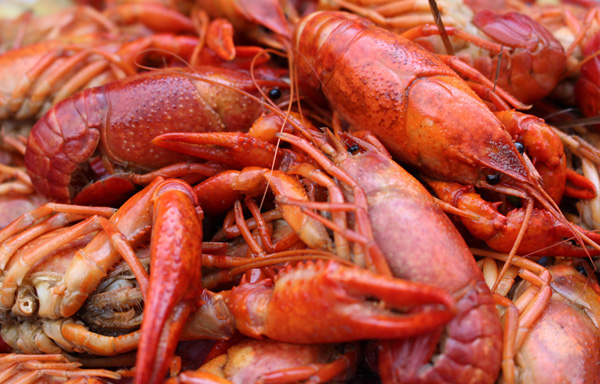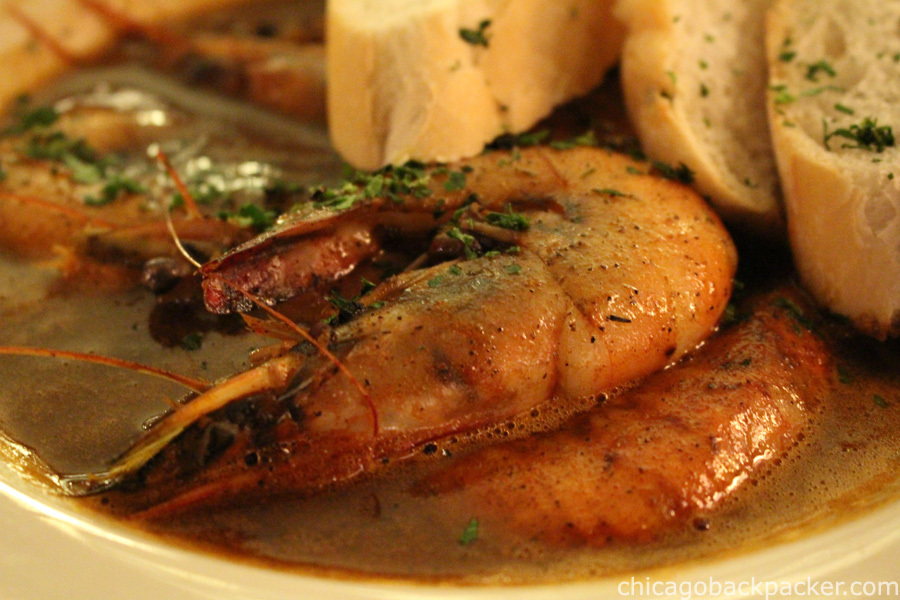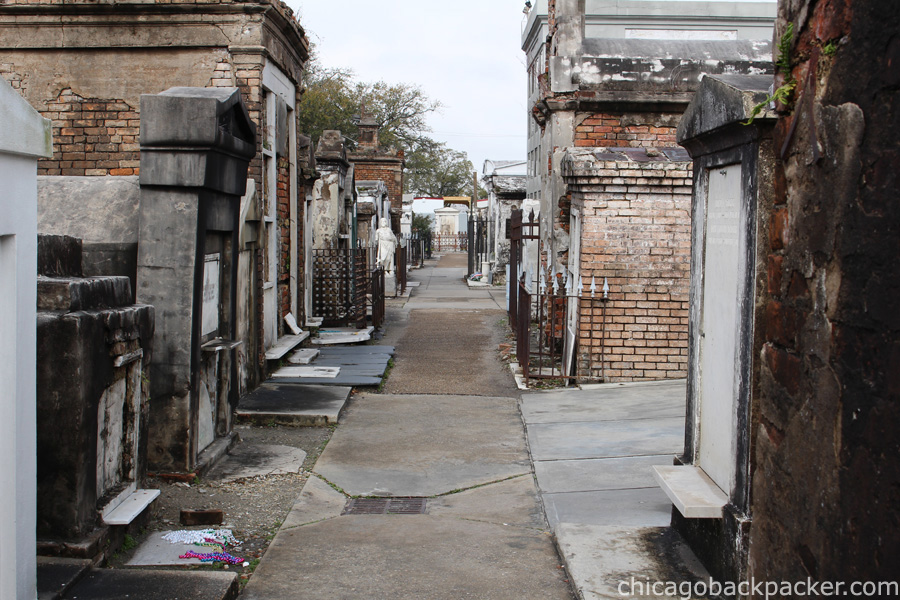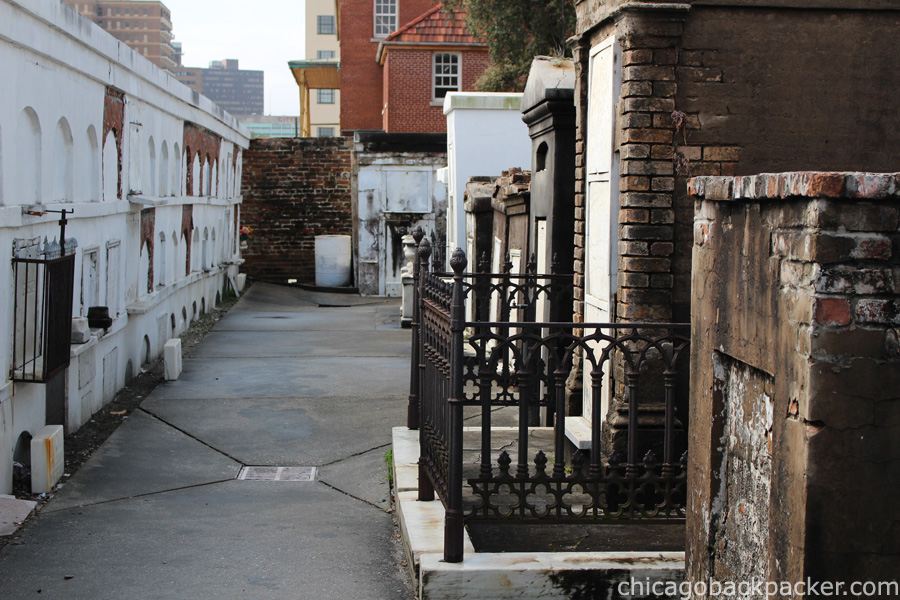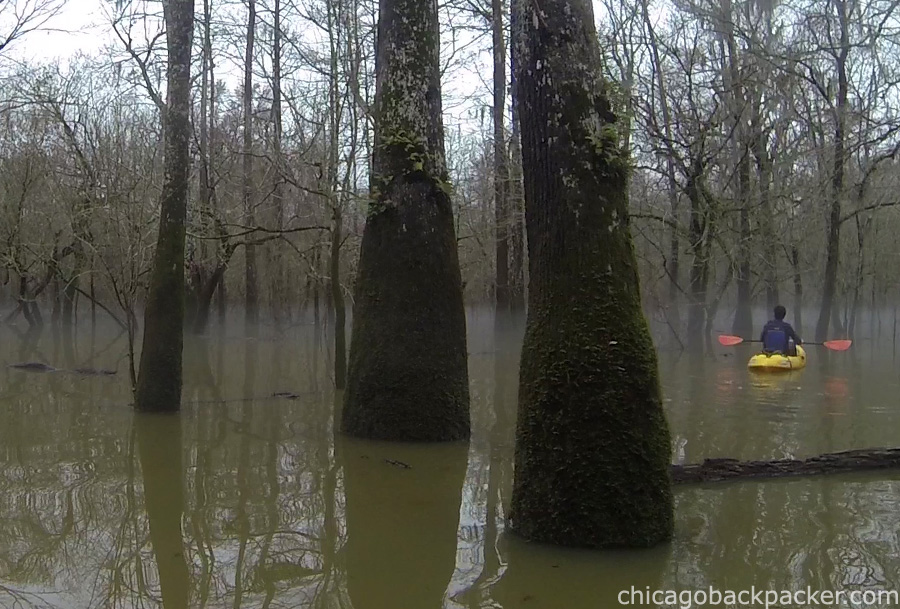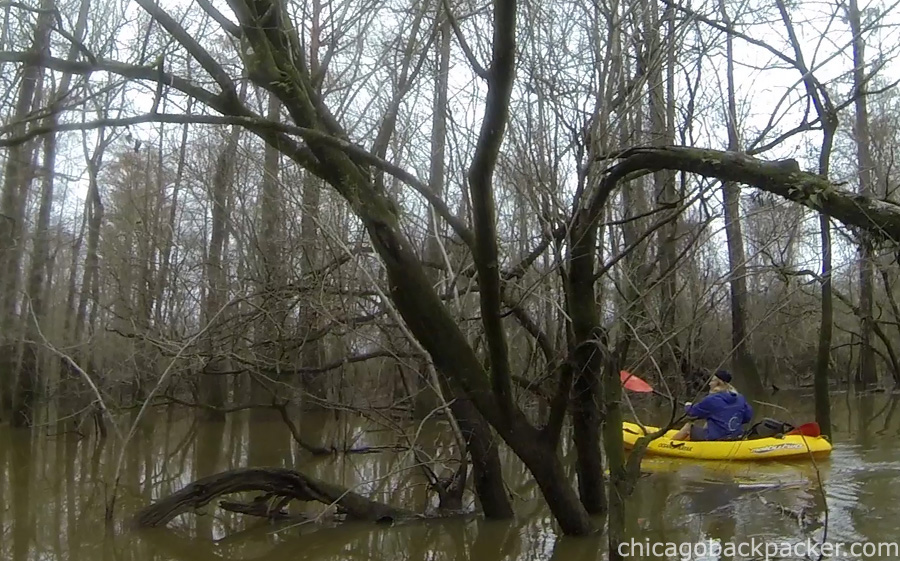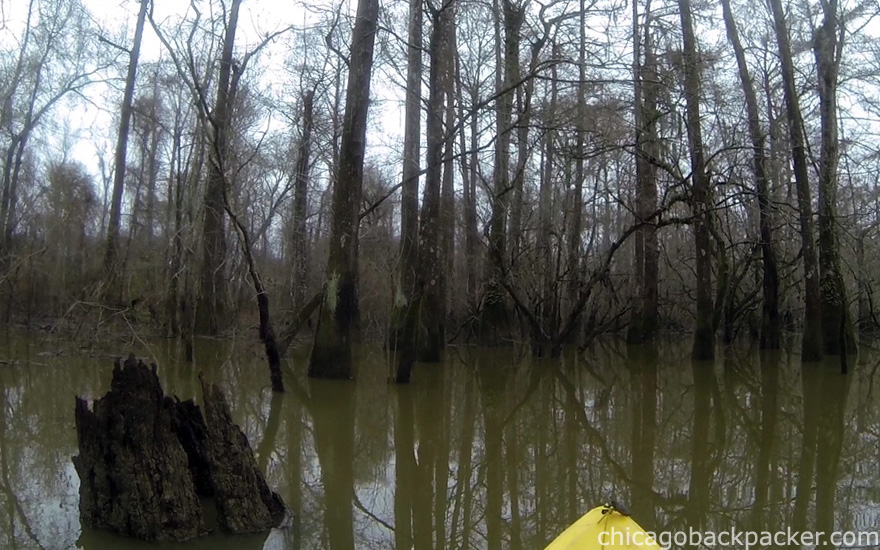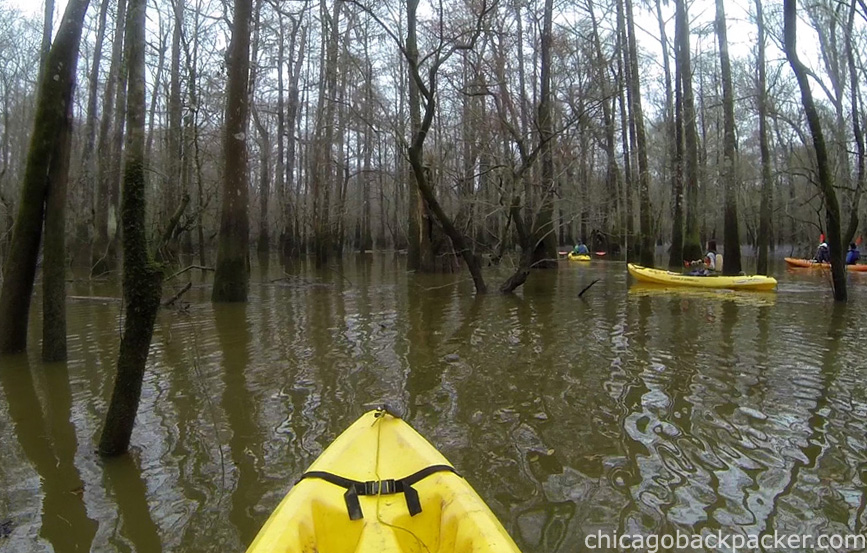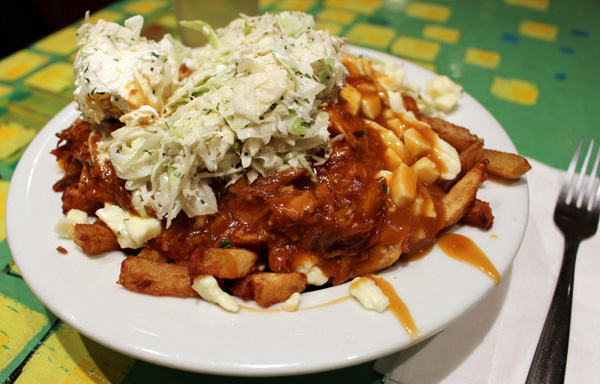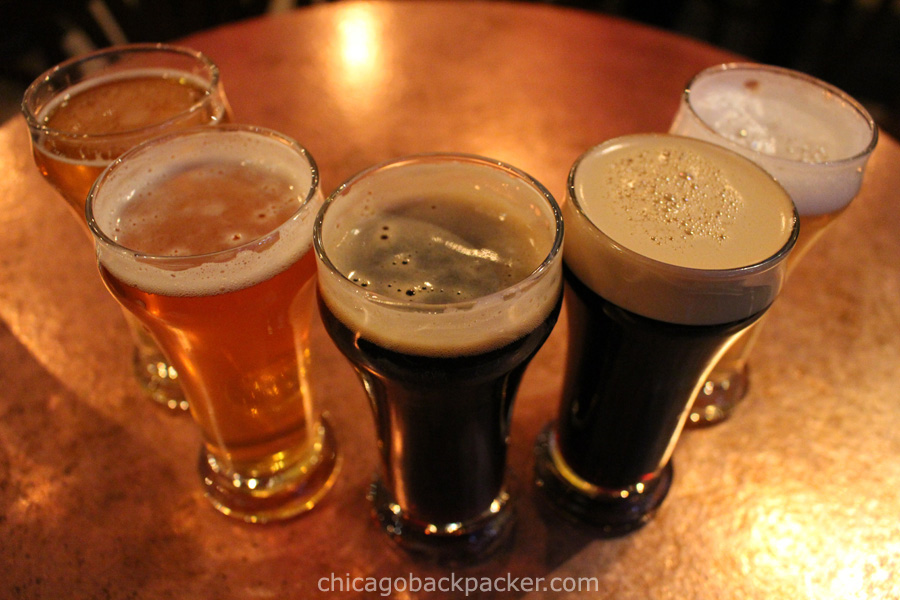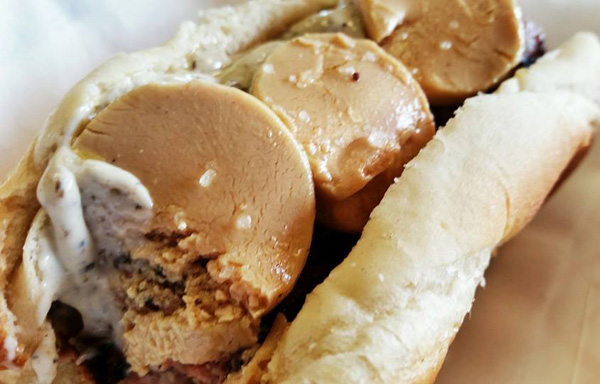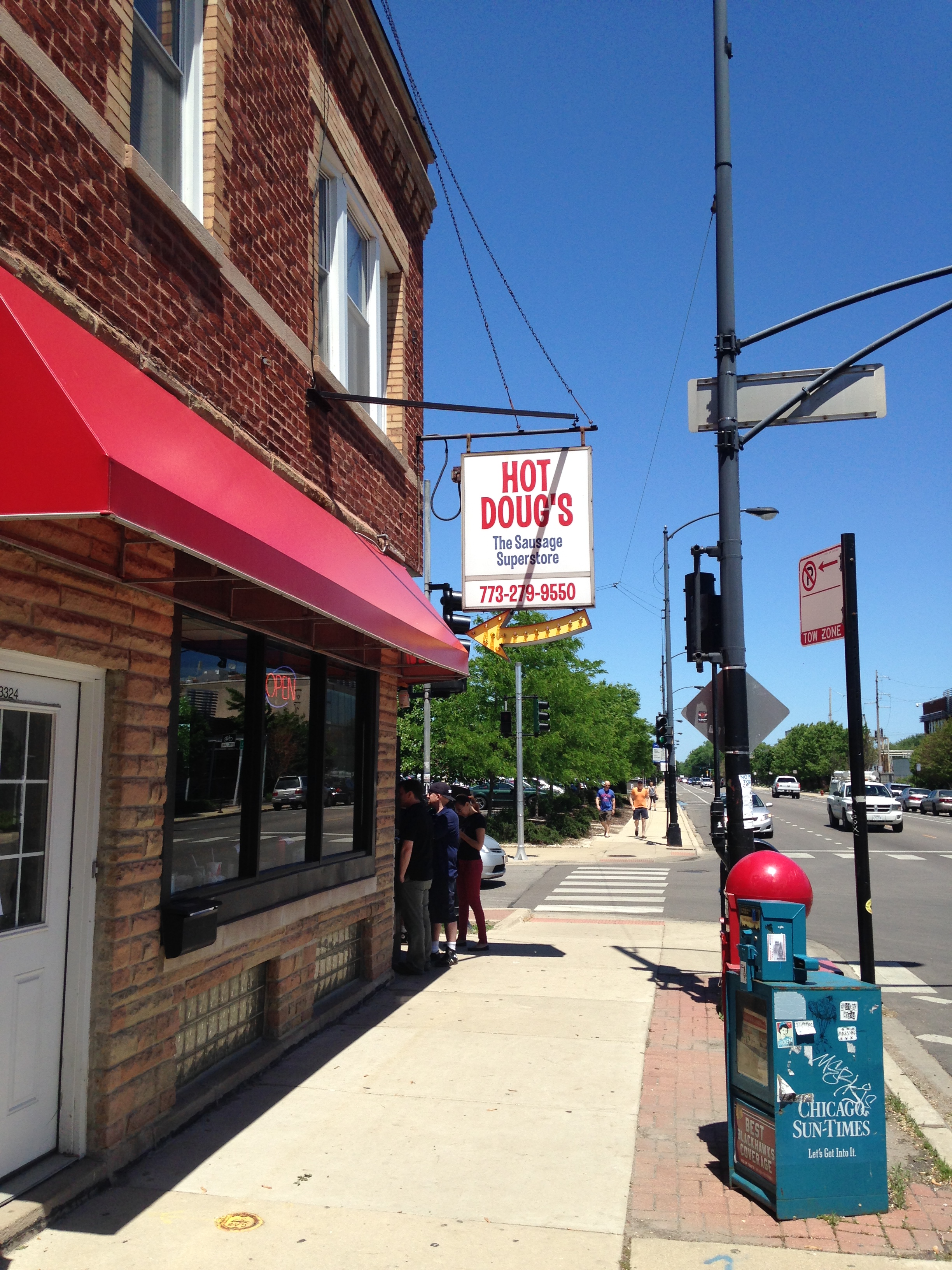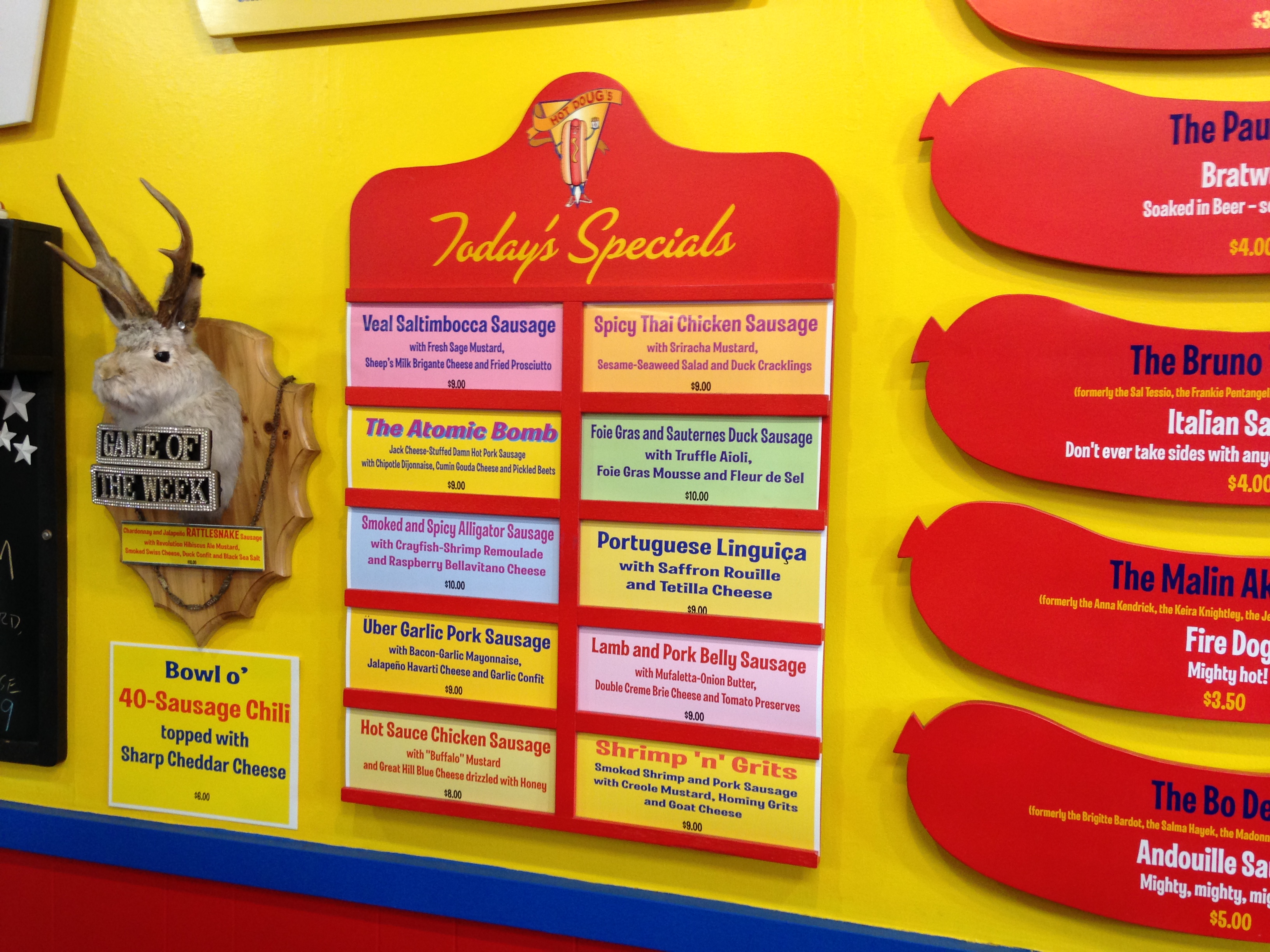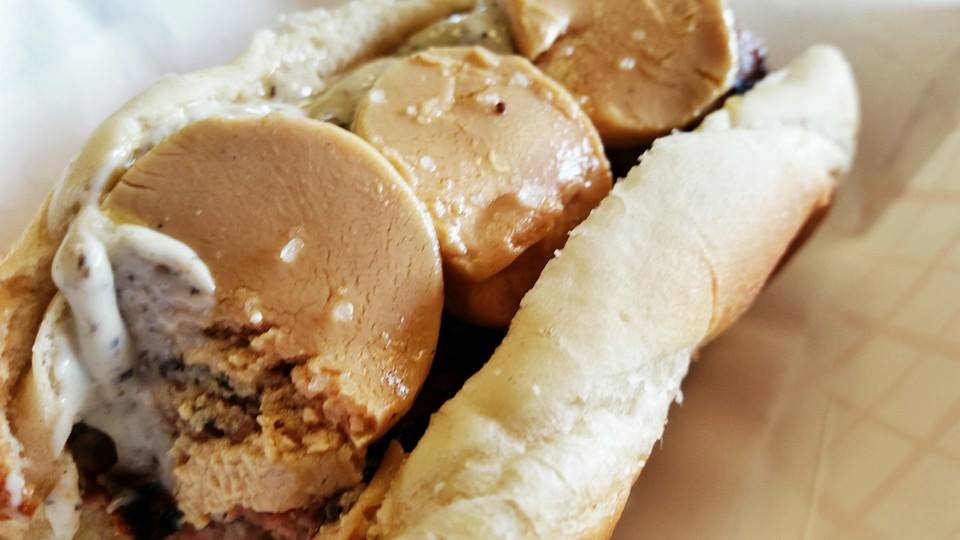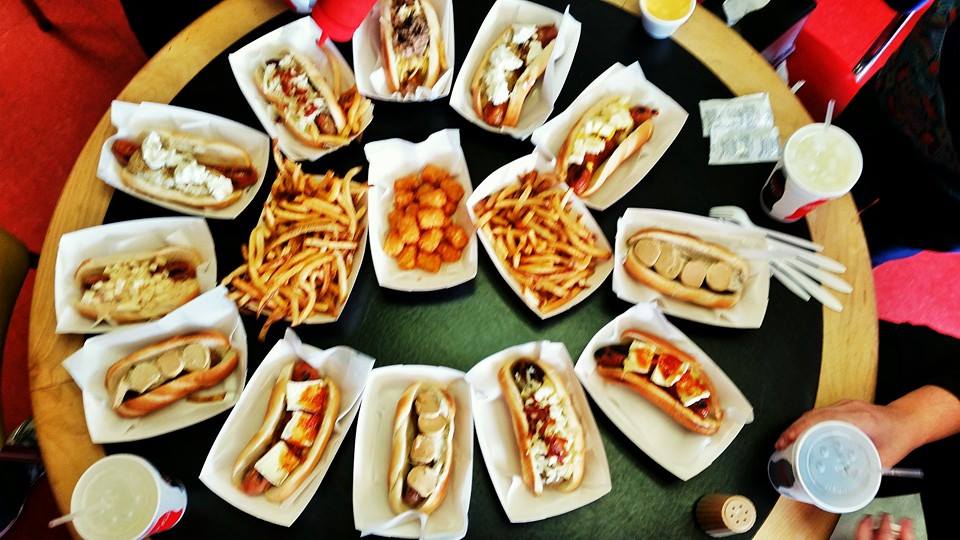The Camino de Santiago Part 4: The Way to Santiago
The Camino de Santiago Part 4: The Way to Santiago
…continued from Part 3: Crossing the Meseta
I have been hiking all day on a winding mountain road past little towns, highland farms, and wandering cattle. The terrain – and the weather for that matter – is a welcome change from the continuously flat Meseta and its April showers that consumed the last week of my life. I’m a few miles out from the Cruz De Ferro, an iron cross standing at the top of the pass just after the hillside village of Foncebadón. I check into an aubergue after a hard day uphill.
Many pilgrims regard the Cruz De Ferro as an important place to address the burdens in their lives, symbolized by a stone that each person brings with them on their journey. They hike for hundreds of miles, carrying their stones and the emotional weight of their hardships that it represents to this summit, cast their burdens at the foot of the iron cross, and continue on, hopefully in a better state of mind and heart. I too had my stone that I carried with me up this mountain. In my case, my burden was guilt.
There was a family dog who I neglected in my teenage years when he needed me. We didn’t know how to handle such a wild dog, so we left him chained up in the yard most of the time and I became busy with other matters. Eventually my family brought him in the house when he was older and calmer, but it was long after I had left. Only later in life did I realize the weight of my mistake – not being part of his life – far later than I would ever have the chance to repair. Before I started my journey, I went to his burial site at the family farm and picked up a stone. I have carried it with me, and the weight of my guilt, on the Camino since the very beginning. Now, I stand at the cross at the top of the mountain, I take it out, determined to never treat another family pet, or any animal, like that ever again and I cast it onto the pile.
The descent from there into the Ponferrada valley entails about three hours of steep, rocky downhill trails before leveling off at the valley floor. It isn’t much fun, but the view is great and the morning is pleasant. Flowers appear along the forests, soon blooming across entire hillsides. I try my best to enjoy the morning without twisting my foot on the rocky trail. I reach the bottom and stay in Molinaseca at the valley’s eastern edge for a night and then continue across the valley for an entire day through Ponferrada’s city centre, going west to the postcard town of Villafranca. The path leads me through gentle rolling hills, vineyards, and hazy mountains in the distance.
I meet Becky from LA, eating dinner by herself at a terrace and just starting her Camino. She has questions about logistics, like how easy is it to find available aubergues, should she make reservations, what the heck is she doing out here, etc. I was nervous on my first day too. Next morning, she already passes me at a faster pace. She’ll be fine.
After Villafranca and its beautiful Castillo, the trail follows a rushing creek along another big uphill ascent to O’Cebreiro, the second highest point of the Camino. Leaving the main road behind, I hike steeply up the large ridge for about three hours, soon revealing spectacular views of the valleys below. The Galician border is marked by a large sign at the summit of the pass. Becky catches up and we team up, hiking in and out of the mountaintop clouds before we reach her planned stopping point. I stay in the next town after and we keep going west the next day, hiking downhill out of the mountain fog.
Something dawns on me as I descend on the western side of the pass, going by countless villages and tattered yellow arrows: For the first time ever, Santiago is about a week away. This place that I spent years dreaming about was actually materializing – the end of all of this, by the gods, is in sight. And I don’t know how to handle it. Because up until now, I have been dealing with nothing but frustrating delays and setbacks.
For seven years, ever since I briefly dated somebody who hiked it, I was fixated on the idea of doing the Camino myself. I started learning about it, obsessively watched Youtube videos, and even bought a guidebook and outlined it at one point. My obsession snowballed into my first nervous decision to travel to Spain in 2018. Unfortunately, I realized then that I didn’t have the money to take the trip after paying for some unexpected dental work. I couldn’t meet the budget at that time, and I don’t travel in the red.
I tried again in the following spring, but canceled my trip last minute because I couldn’t find comfortable hiking shoes to work with my widening left foot. It’s possible that I could have used what I had for distance hiking, but I’ll never know. It was a situation fraught with anger and disappointment. Instead, I traveled around Europe for three weeks, visiting different countries as a contingency. To an extent the unexpected micro-adventures brought comfort and healing, but it wasn’t where I really wanted to be.
The third time I attempted the Camino was in the fall of 2019. I successfully hiked for the first third of the trek, finishing at Burgos with the intent on returning the next year to reach the end. Unfortunately, I didn’t have the foresight to anticipate an imminent global health crisis that might well complicate my plans.
The fourth attempt was derailed in 2020 by worldwide Coronavirus lockdowns.
And the fifth time? Well, that was my decision. It was the fall of 2021 and tourism was allowed again in varying degrees between America and the EU. The problem was that even though travel was allowed for vaccinated tourists, I could still be exposed to the virus – and if so, be required to quarantine for 10 days in a hotel. But where? How does it even work if I catch the virus in a remote village without any hotels? Further, I would also need a negative Covid test to return to my own country. And if it fails, I could end up in Quarantine Gulag for that as well. It led me to the conclusion that we as nations really didn’t have a grip on this problem yet. And places like Spain were allowing just enough people to keep their tourism industry from collapsing. Which I understood, but I realized I didn’t want to be dealing with so many unknowns. Is this how I’m supposed to travel now? Wondering if and when I get sick? As painful as it was to come to terms with it, I felt rushed and ultimately wrong in doing this. And so, once again, my Camino was delayed. This time by my own choosing.
And this time, I broke my own heart.
Well, that’s in the past. It’s a perfect sunny morning in the forest after Sarria. I got out of the mountains a few days ago and Santiago is closing in. Despite all of my sadness and hesitation, I’m not slowing down. Rather, I’ve been starting each day with a surge of pure energy. The weather is perfect and the hill country out here is gorgeous.
Galicia is noted for its lush forested hills, farms, and towns of ancient stone buildings, some converted for modern use. Others are left to crumble in time and the overgrowth of the forests. Going from to village to village each day, I’m reminded continuously that despite all of its modern advancements, Galicia bears the history of great kingdoms, old forests, and lovely hillside vistas that have stood throughout the ages. This place feels like a Shire by the sea.
The main cuisine out here is mariscos and pulpo caught from the coastal towns. That along with the local wines, which are always cheap, are perfect after a long hot day. I stop at the famous Pulperia Ezequiel in Melide, and then a cervezeria selling Pilgrim Beer, on my last day before reaching Santiago. Continuing past other bars and cafes, I see numerous people drinking together. They’re not in a hurry. Because tomorrow they will get to the end. And they don’t want tomorrow to come. We don’t want this dream to be over.
I keep seeing Becky, Ginger, Nick the Brit, the Canadian Ladies, and Dan the Storyteller, whenever I stop in the towns. I call him that because he started calling me Dan the Cowboy because of my hat. But every time I see him, he recalls some kind of interesting anecdote from the people he meets. He said he saw one guy on the trail with a cloth photo of a man’s face on his backpack. When he asked him what it was, the guy said it was a picture of his father. And that before this, his father had hiked the Camino eight times. This time would be his ninth.
Another time, Dan met somebody who was carrying a small pack in their front. He told Dan that it was the ashes of his mother. That she always wanted to hike the Camino, and now they were doing it together.
Back in Villafranca, several of us shared a terrace behind an aubergue with a young Spanish lady and her father. She said that he was hospitalized a few years ago with a severe case of Covid that almost took his life. After he recovered, he said to her, “I want you to come with me on the Camino de Santiago.” And there they were.
And then there is the story that I heard from my archive of YouTube videos about a young woman from South Africa whose father was murdered right in front of her. For her, the Camino was her way of working through her trauma and healing from the pain.
I’m sure there are so many other tales like this. So many kind, simple, genuine, broken people – in person or in spirit – who are out here on a journey for a myriad of reasons. We each have something calling us to walk together on this ancient Way of Saint James, ultimately bringing us each to the outskirts of Santiago de Compostela. Here, I choose to spend the night in O Pedrouzo, a half days walk from the plaza.
And so, Santiago is finally in sight.
I start early the next morning, and whatever sadness and hesitation I felt about this place is gone. I’m charging harder than ever through the outer suburbs with an incredible wave of energy like I have never felt in my life. I am unable to slow down or stop. It feels like an invisible wave of energy is literally pushing me from behind. For four straight hours. I can’t put the reasons why into words, but I want to reach the end as fast as I can. My pack is the only reason why I’m not running.
Passing the outskirts of the city centre, I see Kirstie from Scotland, who for the last few days has been limping painfully on an overused, swollen ankle. I saw her early yesterday and was worried about her, but it looks like she’s about to hobble gloriously over the finish line. Which I understand. At this point, something has to physically stop us from reaching the end of this dream. We chat for a bit, and I tell her I’ll see her at the plaza.
HOLY SHIT!!! IT’S THE TOWERS!!!! The spires of the cathedral stand out above the rooftops. It’s only blocks away.
Finally, I descend a stairway and walk into the plaza below the façade of the mighty Santiago Cathedral, unable to hold back my tears. The towers cut sharply in the brisk morning sky. This whole place is full of pilgrims celebrating: relieved, sad, joyful, and victorious people pouring into the plaza all day long. I find a few of my trail friends near the middle, like Caleb the drinking Irishman, the Israeli who reminds me of Borat, and Becky and Ginger arriving soon after, and Kirstie, limping in pain and glory. Below the overpass coming into the plaza, a guy on a bagpipe starts playing Amazing Grace, and with it, a reminder of home. I’m losing it.
Santiago was a lifetime away. But not anymore.
That night, pilgrims and locals of faith alike come together in the cathedral to attend the Pilgrim’s Mass. I don’t find out until later that the priest reads the name of each pilgrim who received their certificate at the Pilgrim’s Office in the last 24 hours, which must have included me. But I sit in awe of this immaculate, beautifully adorned sanctuary as he leads the congregation through each prayer from the high altar. I understand very little, and am certainly not familiar with any Catholic prayers and traditions, but I, a Pilgrim of the Camino, am welcome among them. The priest ends the mass with a beautiful prayer and blessing to the pilgrims.
I stay in Santiago another day, as some of my friends like Becky, Ginger, and Kirstie the Limping Scotsgirl, have already left town. But a few people like Dan the Storyteller and Nick the Brit are still around. Then there’s Vivian the Filipino, who was apparently around the whole time, but I only met her yesterday. We find Silvia from Italy at the plaza that evening and invite her to join us for mariscos and wine.
We’re about to end the evening when we pass by another group of pilgrims, already drunk and on their way to the next bar. They became a wild, close group of best friends ever since Pamplona. Before I realize it, we’re all drinking together. Cassie from Australia found them weeks ago. She tells me how she went through an extremely difficult situation in her personal life before coming out here and being swept up in her friendships with them. At the next bar, a guy on a guitar is singing cover songs. Everybody in this room has a smile. Pilgrims and locals alike are singing and dancing. Two of them are in love. I’m on my fifth drink as the guy sings La Bamba and everybody joins in.
And so, together in a tiny bar under the vibrant city lights of Santiago, we celebrate into the beautiful night. I can’t think of a better way for each of us to bring this crazy life adventure to its cathartic and inescapable end.
Only for me, this is not the end and my dream isn’t over. And so as the new day begins, I continue on the path going west out of the city.
This story concludes on the shores of Cape Finisterre.
Part 5: Iceland in Full Circle
Part 5: Iceland in Full Circle
…continued from Part 4: The Golden Circle
It was two days after Christmas. I sat on an overnight flight anticipating another Icelandic adventure, this time in the darkness of the Nordic winter. I didn’t know it yet, but in the next five days my trip would unravel into an insane emotional whirlwind of amazing places. I was coming back to Iceland, already, in this dark hour – this time to explore, eat local food, go to museums, celebrate the New Year, and perhaps most importantly, revisit a country that I had quickly learned to enjoy the first time.
The Blue Lagoon
At the time the average high in Chicago was in the single digits, and in Iceland it was twenty degrees higher with mostly clear skies. As far as the climate was concerned, I was getting a break. The trip there, not so much, though I had already planned a reward for the shitty overnight flight. When I got to Keflavik that morning, I got on a shuttle bus for the Blue Lagoon. I relaxed as the light of daybreak illuminated the lake and surrounding hills in ambient blue. I put on a mud mask and got a can of Gull from the island bar. The stress of my 6hr flight evaporated as I drank and swam about the lake among other travelers, watching gales of cold morning air blow fog across the hot water. When in Iceland, so they say.
The shuttle bus left for the city, and the sunrise took forever. Being only a few days after the Winter Solstice, it would slowly arc above the horizon in the south for a few hours each day before leaving us in darkness again. I tried to stay awake as the shuttle passed a huge snow-dusted lava field, glowing in the softest pastel blue I had ever seen. I was back. I couldn’t believe it.
The Northern Lights
I arrived in the city and slept my jetlag off in a hostel dorm. It took me 3 hours to feel like a functional person again. At 7:00 a shuttle from Reykjavik Excursions picked me up for a Northern Lights tour outside of the city. They brought us to Þingvellir National Park, an area with good mountain vistas an hour away from town. We drove through the dark country, passing many snowcapped mountains and farmlands, lit up by a waxing gibbous moon. Though the weather forecast was clear, the solar forecast on my aurora app called for 2%, a low percentage on the front of solar storms.
It didn’t matter. The guide pointed out a thin band of aurora over the north mountains close to the park entrance. To the untrained eye, it looked like a breath of cloud. Only in a few moments could I make out the green tones, dancing like a ribbon over the mountains. We got out. The air was in the low twenties with biting wind. But I got my damn Northern Lights, finally, after all this trouble. There they were, looking back at me as indifferently as an iconic mountain like Denali would – appearing, or not, when she feels like it. But this light show could vanish any second. I had to fucking do this.
I took off for the edge of the lot with my gear, frantically set up my tripod, took out my camera, lost the lens cover, focused on the shuttle headlights behind me, pointed back at the mountains, set to manual, plugged in the remote shutter, and started shooting. After a few underexposed shots, I found a good setting at f/2.8 ISO200 13s. Holy shit! There it is!! I was amazed at how much more color my camera was able to get from a 13 second exposure. To the naked eye, I only saw a fraction of it by comparison. But the picture was interesting enough that a few people started watching the preview screen as I stood there taking pictures. Here are a couple of my successes.
We lucked out. We were there for an hour, watching the aurora dance above the ridgelines. After a while, I was too cold to stay out any longer. The wind was picking up, and I felt like I had seen enough. I packed up and waited in the shuttle.
The Museums of Reykjavik
I didn’t have much time or budget to explore the city last summer, so this time I came back with more of both. I Googled something like “the best museums in Reykjavik” and it returned a great list of places to go – only half of which I ended up seeing. But first, I needed to eat. I left for downtown in the morning, hungry for a good, authentic, local Icelandic breakfast. According to the guy at the cafeteria, the sheep’s head, or Svid, was an Icelandic Viking tradition of thousands of years.
The cheek had the most meat, and was quite tender and flavorful. The tongue tasted about the same, and had a rubbery texture. But my favorite part was the eye. It tasted like cooked fatty tissue with a juicy middle, full of protein and flavor. It didn’t look appealing, but taste buds don’t discriminate.
Satisfied for now, I walked up to the Hallgrímskirkja Church to see the city at sunrise.
In other news, they have a Dick Museum in Iceland.
Just down the street from the cathedral, the Iceland Phallological Museum celebrates all dicks great and small. Whether you’re somebody to prefer a specific type of shaft, or perhaps you just want to see all the dicks, I believe there is a penis here for you. Take for example the taxidermied elephant dick hanging in the back room (pictured above). Feel free to take dick pics and buy your partner a souvenir.
Informative, like the Icelandic Punk Museum, a tiny exhibit close to the Harpa venue nearby. This was a rad little hole in the ground showcasing the rise of Icelandic Punk Rock.
I went to the Whale Museum early the next day. It offers a self-guided audio tour with an mp3 player and headphones, where an Icelandic fellow explains many interesting facts about these great sea creatures. Rumor has it that in ideal weather conditions they can be seen flying above the city.
The South Coast
The city was great, but I needed to see the countryside. I drove around Iceland for a week last summer, and remember being impressed with the south coast. I came to find out later that I missed most of the important places in that area due to time. On this trip, I signed up for a south coast tour on New Years Eve to see everything that I had missed. The shuttle picked me up at 7am and we left at 8 from the BSI terminal an hour before dawn.
In the summer you can hike behind the Seljalandsfoss waterfall and see the landscape in front of it. Now, however, you would slide underneath the water. I enjoyed that as well as the iconic Skogafoss, another beauty created by the steep, cascading rivers of the high country. After a 40 minute visit there, we continued east and went on a short hike to the Sólheimajökull Glacier. It was an easy hike over moraine to the glacier and frozen lake below.
We reached the tiny oceanside town of Vik in the afternoon. I had dinner at the cafeteria and went out to the beach to take in the ragged shoreline. We made one last stop at Reynisfjara just in time for the 3:30 sunset. The sun slowly appeared beneath the clouds, casting red light onto the beach. Highland volcanoes lit up in alpenglow above us. Waves crashed on the black sand beach as the spires of Reynisdrangar darkened against a backdrop of pale blue.
The line of overcast met with the sea. There, the sun appeared, lighting the clouds ablaze in tones of red and orange. As we drove west, I made friends with Val, a teacher from Sao Paulo who was visiting Iceland for a few days. To her, that sunset was the best one of her life. I watched it slowly change the colors of the landscape and agreed, thinking it was certainly in my top five. It just so happened that a full moon rose above the white mountains to the north.
As the night darkened we passed farms and little towns, often seeing huge bonfires and fireworks from locals already celebrating the New Year. We reached outskirts of Reykjavik, where even more fireworks exploded above the city lights. The magic of their holiday was unmistakable – yet I couldn’t deny in that early hour that they were holding back. It was New Years Eve in Reykjavik, and the city was coming alive in celebration.
This story concludes at the Sigur Ros concert at the Harpa Concert Hall.
The Streets of Centro Havana
I left Mexico last May to see the one island country that we Americans have only recently been allowed to visit. It is technically still illegal for Americans to go there, but there are twelve travel exceptions that our government allows its citizens to use while visiting Cuba, one of which is “journalism”. So when I bought my ticket from Mexico to Havana, I listed it as my reason to go. If I had to, I would tell Customs agents that I’m a journalist for a travel website, chicagobackpacker.com, and that I’m reporting on the tourism industry in Centro and Old Havana. Fortunately it didn’t come to that at border crossings. Nobody cared.
My plane landed at sunset. Google Maps was wrong about my AirBnB host and the airport taxi dropped me off in the wrong place. Where the hell am I? It was getting dark and I didn’t know how bad this area would get in a late hour. I had a wallet full of cash, a backpack, a passport, and my phone. And nothing I wanted to lose in a random foreign city. I followed the street numbers south for four blocks until I found the host’s building. She welcomed me in and talked my ear off for an hour. She had a nice apartment with a comfortable air conditioned room and an excellent terrace.
I spent the next few days walking around the streets of Centro and Old Havana. A few of the vehicles in the city were newer and probably belong to a well connected taxi company or politician. Most of the cars, however, are of another era.
This is Chinatown, or as my host would say, “Chinatown”.
There are famous revolutionaries.
The Cubano food is very simple and quite good.
If you need to rent a Casa for the night, look for one of these signs. They’re everywhere.
On my second day, I took a ride in an old convertible around the old city.
The guide drove me around Centro, Old Havana, the embassies and mansions on Quinta Avenida, and then circled back to La Plaza de Revolucion. I understood some of the things he said about the buildings and he could understand some of my Spanish. I’m getting there a few words at a time.
Presently, there are only a few places to get wifi in the city. You can try to piggyback a signal next to one of the hotels. I didn’t have much luck with that. Or you can go to a city park and buy an hourly card to use right there in the park. I thought it would be funny to get on Tinder and try to get a date with one of the local mujeres Cubanas at a nearby cafe. Even if it didn’t go anywhere, I didn’t care, I just wanted to be able to say that I met a Cuban lady on my Tinders. When I loaded up the app in a city park, I got this message:
“Haha, their government blocked it!” I thought and left to do something else. I came back the next day and tried it again. The error message came up like before, but this time I closed it out and left the app open. A few seconds later, it started loading in profiles from local women and other female tourists (presumably trying to do the same thing). So it did work after all. Too bad I had to leave in a few hours, facepalm.
I stayed one day longer than I needed to, didn’t plan very much other than the taxi ride, stayed inside in the afternoons because of the heat, didn’t get to experiment with my Tinders, didn’t have enough money or time to explore the country, and couldn’t withdraw it from their ATM machines because our banks weren’t wired to work with theirs. A lot of this left me feeling underwhelmed at my first visit. If I were to come back with more cash, a better plan, and an up to date Tinder profile, who knows?
I left for Mexico City and eventually the States again. Like before, nobody cared that I was a journalist with a travel blogging website. The Customs officer didn’t so much as even glance at the Cuban stamp on my passport.
Nashvegas and Mammoth Cave
Nashvegas and Mammoth Cave
“I know that some of you don’t know who Vince Gill is, and that’s because you don’t listen to country music. And I know you don’t listen to country music because a lot of it is shit.” -Lewis Black
I just visited Nashville for the first time, and for better or worse, it wasn’t what I expected. For the record, I didn’t know that much about the city other than that it is the Mecca of country music, and that it would be the best staging point for a drive up to Mammoth Cave last weekend. And as far as the people go, I knew it would mostly be cowboys, southern girls, and people trying to break into the industry. That aside, I assumed it would be about like any other big city.
What I didn’t expect to see was the fucking shitshow that was Nashville’s Broadway Street every Friday and Saturday night. I stayed in downtown and couldn’t really avoid it. Every weekend, the street is packed with drunk southern frat boys and bachelorette parties. It reminded me a lot of NOLA’s Bourbon Street, but at least the party scene in New Orleans had some character and soul to it. This was just a carnival of drunk assholes. I see why they call it Nashvegas. It is Las Vegas for rednecks.
That out of the way, I’ll tell you what I liked about Nashville. The first thing was the Seigenthaler Bridge, a pedestrian walkway that crosses the Cumberland River right in front of the skyline. It has a great view of the riverfront and downtown buildings. I went up there at sundown on Friday to practice shooting lowlight.
Then there was the food. I do love me some good old southern home cooking, mostly because the primary ingredient in any good southern fried food is cholesterol. Give me some pulled pork and egg on a hot buttermilk biscuit, darlin, and I will sit at your counter and drink your coffee. And you don’t have to call me darlin, darlin.
Jack’s on Broadway is a well respected barbecue restaurant with some outstanding Texas Brisket. I went there on Friday night right in the middle of all the Nashvegas action. The line looked like it would be an hour, and I almost didn’t go in. Then I changed my mind last minute and chose to wait it out, which turned out to be the right decision. The pork shoulder was solid, the St. Louis ribs were even better, and the brisket was a fucking home run. It was the only kind I’ve had where the burnt edge tasted like roasted marshmallows. Imagine that kind of sweet flavor blending into tender, smoked beef. Go there and eat it, people, it’s awesome.
On 3rd Avenue just around the corner from Jack’s is the Johnny Cash Museum. Don’t those three words together sound wonderful? I’ve honestly never liked mainstream country, but to be fair, Nashville does pay its respects to the pioneers and veterans of the industry.
The museum was full of memorabilia from every phase of Johnny Cash’s life – from his childhood in the cotton fields of Arkansas to his Folsom and San Quentin concerts, to his years as a Highwayman, and then his epitaph on American IV. It was a haunting place, and I was genuinely humbled to walk amongst the artifacts of the greatest country singer who ever lived.
As a final thought, the very last exhibit showcased the video for Hurt on the TV screens. It had a montage of clips taken throughout his life, and shots of him singing his words of farewell as an old man. Below the screens was the now empty red chair where he once sat, pouring wine before a grand feast. Leave it to a mortal like Johnny Cash to immortalize an already great song.
Mammoth Cave National Park
I rented a car early the next morning and drove 90 miles north to Mammoth Cave, the largest known cave system in the world. To date, there are more than 365 charted miles of its tunnel system, though surveyors estimate that hundreds more still exist. An elaborate network of subterranean streams and rivers exist deep within the cave, and all eventually flow outside to join the Green River.
The park offers tours of the passages near the welcome center, which at the most go about 300 feet underground. I signed up for two of them, Domes and Dripstones in the morning and Cleveland Avenue in the afternoon. Each would take about two hours.
After a brief orientation from the ranger, 200 of us boarded school buses and left for the entrance to Domes and Dripstones. The entrance was closed off by an iron door that the ranger unlocked and opened. We walked single file down a long stairway of steel that wound around the bends of the descending tunnel. The air was cool and damp with groundwater runoff.
We finally reached the bottom and walked into a much larger chamber where the ranger stopped us and spent a few minutes telling us the history of the cave. For the next hour, we went onward through one big chamber after another, but the ground was mostly level. It was a well maintained passage that should be accessible by people at most fitness levels. This wasn’t like spelunking, where you actually are scrambling over boulders and rappelling down ledges. (If you are into that, they do offer a guided trip of 5.5hrs through a gnarlier passage of the cave.)
After a couple hours, we reached the far terminus of the passage at a chamber called Frozen Niagra. It is marked by a thin column of water flowing from a sinkhole above the ceiling, which over time has created numerous stalactites and flowstone formations on the walls. You can descend about 40 feet to the bottom of the chamber. When I did, it looked like it was part of an alien hive.
The entrance to Cleveland Avenue felt like the stairway to a fallout bunker. When we got to the bottom, 50 of us walked along a long, oval shaped river-cut passageway for what ended up being two and a half hours. Unlike Domes, Cleveland Avenue was larger, straighter and more level – evidence of what was once a slow moving subterranean river. I felt like I was walking through a lunar tunnel.
I mostly stayed in the back of the group to get pictures of the cavern rooms. One of the rangers with us told me about how the park was first bought from farmers in the area by the park service several generations ago. When he looked up his genealogy, it turned out that his own ancestors were among the people to sell their land. I thought it was really cool that the park where this guy works is part of his own lineage.
We got back to the stairs going up to the entrance and were the last ones out. He told me I should get a picture of the steps. I agreed, and it turned out to be my favorite picture of the trip.
I turned and passed through the doorway, and walked into the blinding white light of the afternoon.
Asian Cuisine of Orange County
Asian Cuisine of Orange County
Did you know that the Asian restaurants in Orange County are fucking awesome? I know that now. I went there recently on my way up the coast expecting to be impressed, but blown away? That’s not easy to do. But it happened, and the food out there has seriously raised the bar in how I enjoy Asian cuisine. With a culinary scene that is full of talented people and highly engaged clientele, their Asian restaurants remain established, thriving, and waiting to be discovered by the hungry traveler.
I didn’t know that when I got there, and set out to explore. Luckily, I was staying in Santa Ana with my friends Jenny and Rafael, who are quite familiar with the local circuit, and both know good food when they taste it.
Gen Korean BBQ House
On my first day, Jenny brought me to Gen Korean BBQ House in Tustin. It was a buffet style grill with an on-demand menu of 30 different freshly cut, marinated meats to choose from, and a whole slew of side dishes with all kinds of vegetables and sauces. Patrons sit around each table and pile on the meat, and watch it caramelize, sizzle, and pop on the hot metal.
Servers brought out one order after another of braised meat that we cooked on the grill. I shoveled all kinds of things together on my plate, and whenever we ran out of something, one of five servers would come out of nowhere and put a new saucer on the table. I wasn’t sure which was better – the food or the service. It was so good that I didn’t want to get full and have to stop.
Din Tai Fung
Anytime I see a place with an hour-long wait on a weekday, it’s a good sign. It means that it has spillover from everybody who doesn’t want to wait even longer on the weekend. Plus, I think that that for me, part of it is psychological. When I have to wait for something good, I feel like I’ve earned it. On our second day, we waited for about an hour for a table at Din Tai Fung, and walked Ryder around the South Coast Plaza to kill time.
It was the first time I’ve ever had Xiao Long Bao, their world famous Taiwanese dumplings. In preparation, they place pork or other meats on a flattened piece of flour skin, hand wrap it around the meat, pinch it into notches at the top, and then steam cook it. When ready, the juices create a pocket of meaty soup in a dumpling, which they bring out in orders of ten in a big steaming pot. With a dash of soy sauce, it will be a mouthful of hot, brothy deliciousness like you can’t even.
For sides, we got shrimp and pork wontons and pork chops on a bed of fried rice. Again, I didn’t want to stop eating.
The Boiling Crab
I have three words: Vietnamese. Cajun. Crawfish.
Fucking hell! How did this happen, you ask?
This brilliant concept of a restaurant started in 2004, when its owners envisioned a southern Mississippi Cajun boil in the Little Saigon enclave of Orange County. In a very short time, their notoriety spread like wildfire, drawing a huge following in the local Asian foodie community.
I already love Cajun food, but add some buttery garlic and lemon pepper to it and it’s an entirely new experience. Just look at all that sauce in the second picture above. Soaking into the crawfish and shrimp like they drowned in it, sacrificing themselves to the human foodie-gods. Seriously, distance aside, my cholesterol is the only thing stopping me from eating pounds of that every day.
So far, they have other locations in San Diego, San Jose, Sacramento, Vegas, and Houston. I’m sure they will find new cities and new crowds to win over, since a place like that really can’t lose. And so will the other restaurants there, as long as that community continues to cultivate talented, competitive chefs and loyal fans.
That was it for now. On my last day, I rented a car from the airport and drove up the Pacific Coastal Highway. I had a highway to film, and was San Francisco bound.
An Alaskan Brewery Tour
Whenever I visit a new city, I want to find out what the locals drink. In Juneau, Alaska, the best place to do this is the Alaskan Brewing Company. With seven year-round beers, rotating seasonals, and numerous small batches, they have established themselves as one of the state’s pioneers of microbrewing, opening their distribution all over the region, and eventually expanding to the Lower 48 West Coast and upper Midwest.
Local ingredients go into what they do, as their water is sourced from snowfield runoff from the Juneau Icefield above. Spruce tips from local Sitka trees are harvested regularly to flavor their Winter Ale. And their malts are smoked in locally cut alders, promising a taste of the Last Frontier in every glass.
They offer shuttle tours to their brewery every day, which was great timing for me because the weather happened to be terrible. They picked me up along with three other guys at their merch store in downtown and drove us to the brewery five miles away. It is part of a small industrial corridor nestled between huge, foggy mountains. You wouldn’t guess what it is if it weren’t for the brewing tanks looming over the building.
We went inside to a small taproom surrounded by glass walls, allowing us to see their brewhouse. Ted, a Juneau resident ever since its inception, walked behind the bar and started pouring flight samples for us while giving us the history of the brewery and its relationship with the town.
In short, it was founded by owners Marcy and Geoff Larson in 1986, when nothing like it existed in the Juneau Borough. Unable to convince investors that they had cost-effective enough of a model for such a remote location, they went to the locals for help, financing their startup capital by selling shares to the townspeople.
They started by hand-packaging their bottles and cases, but eventually upgraded their hardware to meet the wildly growing demand. As their business escalated, so did their need for innovation and efficiency.
Disposal became a big challenge for the brewery in such a remote location. While brewers in the Lower 48 can more easily sell their spent ingredients to local farmers to lower their costs, this wasn’t an option at their facility. To solve this, they became the first American brewery to employ a Mash Filter Press – a Belgian-patented machine that is used to force the water out of their spent grains. The water is then reused in the brewing process, and the newly dried grains are reused as fuel.
Furthermore, they figured out a way to harness and reuse their carbon emissions. Geoff, a chemist by trade, designed a CO2 Reclamation System, which captures the emissions caused by the yeast in fermentation, and then reuses it for packaging and purging oxygen from the holding tanks.
It is because of these sustainable, cost-effective innovations that they have managed to lower their production costs and remain present in an increasingly competitive industry. Fuck yeah!
After a truly great history lesson, Ted brought us to the tasting room, where a bartender gave us more samples to drink. The Alaskan Amber, their primary flagship ale, became my favorite as I visited the brewery and the town. It is characterized by a crisp, lightly bitter foretaste and smooth, refreshing, malty flavor, which they attribute to a slow fermentation process. Their award winning Oatmeal Stout was another good one, blending oats and malts with an edge of coffee and caramel.
And numerous other flavors of the rainbow can be had in their taprooms. Whatever I didn’t have enough of there, I found at the bars in downtown.
Their distribution goes as far as the upper Midwest, but hasn’t yet opened in Illinois. For now, I have to go to Milwaukee or Michigan to find a case of their Amber Ale. I know it will get here eventually. Ted told me that they’re working on it, and I’m sure he’s a man of his word.
Alone In New Orleans
Alone In New Orleans
I got a fondness for the dirty south, and New Orleans is as dirty as it gets. I went for the first time this season, and confirmed its reputation as a nexus of decadent food, debauchery, and the most deregulated alcohol industry I have ever fucking seen. It was a long time coming, New Orleans. But together we made it count, starting with Lafitte’s Blacksmith Shop, the oldest bar in North America.
I literally just got out of a cab, checked in at my hostel, and walked five blocks to Lafitte’s to drink something cold and local. The bar was packed with Friday night partiers, but was nonetheless comfortable and friendly. For 293 years, generations of patrons have enjoyed Lafitte’s for its atmosphere and dimly lit interior, creating and telling stories ever since its dodgy beginnings in the hands of a smuggling racket. It is a testimony of the city’s endurance, outlasting citywide fires, hurricanes, prohibition laws, and bullshit. This is not just any watering hole; Lafitte’s is an aged well of handcut stone.
It resides on Bourbon Street, the main arterial line of the French Quarter, blocks away from a notoriously balls-out wild nightlife that resonates for miles. I wasn’t in any mood to party, but I at least wanted to see Bourbon Street in its prime. After a couple beers, I left Lafitte’s to check it out.
It’s not that often that I have a culture shock in my own country, but shit man, this was insane. A full on mile of fucking dudebros, honeys, shiny plastic beads, neon strip bar lights, and loud music, wall to wall, street to street. It was like JMU’s party scene times twenty. It wasn’t even during Mardi Gras, which is even bigger. And still, Bourbon Street was a Mecca of self-indulgence, drawing hordes of partiers every weekend. I felt like I was walking through a carnival solely devoted to debauchery.
But I didn’t come to New Orleans to party (this changed later); I came to New Orleans to eat. It wasn’t hard. In New Orleans, great food is everywhere.
Cajun and Creole Cuisine
Over the weekend, I sought out the best Cajun and Creole cuisines from the shittiest looking places I could find. It turned out to be the easiest thing I did all weekend. I’ve never seen anything like the food scene in New Orleans, which is abundant at every turn. Catfish, alligator, gulf shrimp, pork, spices, you name it. All by people who have done it their whole lives. All local. All awesome.
Some favorites included the Shrimp Poboy from Killer Poboy’s, a small kitchen in the back room of Erin Rose, a cool lowlight establishment of character and ambiance. Seared jumbo shrimp with a sweet slaw of marinated carrots, daikon, cucumber, herbs, and a spread of Sriracha aioli on a fresh baguette. Dat Dog had a great alligator sausage with Cajun mustard and a side of Crawfish Étouffée Fries, which in all honesty tasted like Suicide Girls making out in my mouth. At Mr B’s Bistro, its signature dish kicks hordes of ass: Barbecue shrimp sauteed in Worcestershire-spiked butter sauce with a dash of pepper and Creole seasoning. I devoured the shrimp and got another baguette from the server just so I could finish off the sauce.
Cafe Du Monde was perhaps the most iconic restaurant that I visited. It is famous for its beignets, which they shovel out of their kitchen by the thousands all day long. They served me three pieces of deep fried French doughnuts buried under a heaping pile of sugary crack-powder. They were awesome, even though the line to get inside went for blocks down the street.
Cities of the Dead
My hostel was a short walk from St. Louis Cemetery No. 1, the oldest and best known of NOLA’s “Cities of the Dead”. It is a walled off city block of dilapidated, awesome looking 18th and 19th century mausoleums. I wanted to go on Sunday morning, but thanks to other idiots, they had just closed it off to the public unless you came with a licensed tour guide.
I signed up with Free Tours By Foot, a local nonprofit tour guide service, to check it out the next morning. We met outside of a bar in the Quarter about a mile from the graveyard. The host, Kathy, spent the next 45 minutes slowly walking us there and telling us the history of the French Quarter and the development of the city’s burial process. It short, it is a colorful history of debauchery, crime, infrastructure and sanitation problems, and ultimately a high groundwater table that made it altogether impossible to bury anything, that prompted the people of 18th and 19th century New Orleans to revert to their Spanish and French styles of above-ground burials.
Remains of well-known politicians, architects, and other distinguished people line its graves. Worn by centuries of sun and rain, these tombs bear the scars of early times deep within their cracks of mortar and stone.
Great place, but I had to take off early. I left Kathy a $20 and ran back to my hostel to change into paddling clothes. Some guys from a kayaking company picked me up a few minutes later, and we headed northeast to paddle the swamps around the Pearl River for a few hours.
Swamp Kayaking
New Orleans is surrounded by a huge wetland system of marshes, bayous, meandering rivers, and a network of man-made levees and canals. New Orleans Kayak Swamp Tours is a local outfitter that offers guided kayak trips along one of the bayous near the Pearl River, an hour northeast of the city. By coincidence, the launch point is next to a roadhouse used to film scenes from the first season of True Detective. I had to rewatch the show later recognize the smoky old honky tonk and parking lot that they used to film all of their hard dealings and dangerous people.
We launched and paddled upstream past river shacks for an hour before reaching an open swamp. A layer of mist lay across the bayou, which was devoid of any color, save an occasional early flower or patch of moss on a cypress tree.
It was winter in the bayou country. Gators were in hibernation, bugs were weeks away from hatching, and all was quiet on the water. It was a dismal place where people probably do lose sense of direction and wander endlessly through its channels and dense, foggy overgrowth. And in horror fiction, a dark, rotten hand might come out of the water and take you by the arm. It was where the weak die young and metal lives forever.
We zigzagged around trees and bramble for an hour before turning around and heading back to the bar. We returned using another route, paddling upstream on another channel until we reached the Pearl River. From there, we hooked to the right and came back down a faster channel past a series of abandoned, flooded river shacks before crossing through a slough and stopping at the takeout.
And of course the gas station next door sold hot, freshly smoked Cajun meats, because why the fuck not? By that point, we all had worked up a huge appetite for shrimp, alligator sausage, and motherfucking pork. It’s nothing short of ridiculous how abundant this stuff was. We mowed it down and came back to the city.
Badass Cajun Crawfish
On my last day, I was satisfied in every way but one: I had to find a good local crawfish boil. Some Chicago-based girls who I partied with earlier that weekend on Frenchmen told me about Mississippi River Bottom, a bar and grill just around the corner from all the action on Decatur.
I sat down in their garden early Tuesday afternoon and ordered a pile of crawfish at the market rate of $6 a pound. The cook told me that the tourist restaurants like to charge around double, but they want to keep it local. Fine by me.
I devoured by claw and tail and left a wrecked pile of slaughtered Cajun shellfish as my fondest memory of the dirty south.
It’s settled. I’ve been unvirgined to New Orleans, and she’s a wild one.
Dining in Montreal
Dining in Montreal
How did I end up in Montreal in the dead of winter? I’m still trying to figure that one out, but it happened. I had originally planned to stay in Toronto over the holidays, but in light of a last minute changeup in my plans, Montreal happened instead. I arrived there on a bus early Saturday night with a backpack and agenda that was simple: Eat as much kickass food as I can, and try to stay warm.
I managed it for the most part, but damn, that city is cold. And there is no end to how many people wait in lines in the middle of it just to eat something amazing. Why? Because food can do that to a person. And the food in Montreal is exceptional.
L’Avenue
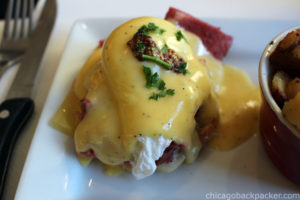 I crashed at my friend Marion’s house and went out early Sunday morning to check out L’Avenue, a trendy upscale brunch restaurant in the Plateau District. I realized pretty quickly that going on a Sunday was a mistake, as the line looked like it would take at least an hour. Screw that, I thought, and went to a diner somewhere else. I came back on Monday morning and got a table without any wait or hassle.
I crashed at my friend Marion’s house and went out early Sunday morning to check out L’Avenue, a trendy upscale brunch restaurant in the Plateau District. I realized pretty quickly that going on a Sunday was a mistake, as the line looked like it would take at least an hour. Screw that, I thought, and went to a diner somewhere else. I came back on Monday morning and got a table without any wait or hassle.
The atmosphere was comfortable, with a tall ceiling, trendy decor, graffiti, artwork, hip decorations, and decadent breakfasts. A young, attractive French server approached me to take my order, deliberately standing an inch away from my shoulder with her hand on the back of my seat. No reservations indeed. I didn’t mind; I like attention. I was in the mood for something good and savory, and ordered their Montreal smoked meat benedict.
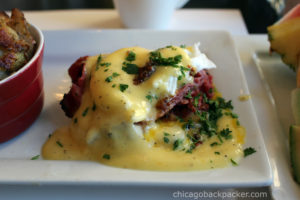 Handcut slices of Montreal’s signature smoked brisket piled on an English muffin, buried in poached egg with creamy, rich hollandaise and a dash of seasoning, it will bring a tear to your eye and a what the fuck weakness in the knees, I shit you not. It was maddening and beautiful to eat. The smokey, salty flavors from the beef blended amazingly with the egg and hollandaise sauce, creating a savory mess that was truly divine.
Handcut slices of Montreal’s signature smoked brisket piled on an English muffin, buried in poached egg with creamy, rich hollandaise and a dash of seasoning, it will bring a tear to your eye and a what the fuck weakness in the knees, I shit you not. It was maddening and beautiful to eat. The smokey, salty flavors from the beef blended amazingly with the egg and hollandaise sauce, creating a savory mess that was truly divine.
I cleaned that plate in minutes, and would do it again in seconds. Congratulations, L’Avenue, you serve the best Benedict I’ve ever had.
La Banquise
 An iconic poutinerie in the Plateau, La Banquise is just as popular as L’Avenue, perhaps even more so. With at least 30 different poutines in their menu, they draw lines out the door, even in off hours, even in horrible weather. I figured that out the hard way. I saw a line during lunch break and made the mistake of waiting until mid-afternoon, only to come back and see it double in size. Not even the shitty cold snap rolling in could dissuade these people.
An iconic poutinerie in the Plateau, La Banquise is just as popular as L’Avenue, perhaps even more so. With at least 30 different poutines in their menu, they draw lines out the door, even in off hours, even in horrible weather. I figured that out the hard way. I saw a line during lunch break and made the mistake of waiting until mid-afternoon, only to come back and see it double in size. Not even the shitty cold snap rolling in could dissuade these people.
I finally got inside after 45 minutes, thawed out, and ordered the large pulled pork poutine. Imagine a whole backyard barbecue of pork, cole slaw, sour cream, gravy on a pile of fries and cheese curds. It was a huge bowl of kickass, and remarkably, I got through it all.
Other options in their menu include combinations of bacon, peppers, sausage and smoked meat. I was beginning to notice a trend in this city.
Fairmount Bagel
 I heard from multiple sources to check this place out, and I’ll admit I was skeptical. It’s just a bagel, I thought, could it really be this cool? It turns out that it can. I went to their store first thing on Tuesday morning before starting my work day. I got their standard sesame bagel, bit into it, and the flavors came alive in my mouth as steam rose from the rest of the bagel and faded into the dry morning air. I felt every hot sesame seed on my tongue, and thought yes, a bagel really can be this cool.
I heard from multiple sources to check this place out, and I’ll admit I was skeptical. It’s just a bagel, I thought, could it really be this cool? It turns out that it can. I went to their store first thing on Tuesday morning before starting my work day. I got their standard sesame bagel, bit into it, and the flavors came alive in my mouth as steam rose from the rest of the bagel and faded into the dry morning air. I felt every hot sesame seed on my tongue, and thought yes, a bagel really can be this cool.
Why? I guess it’s because they prep their bagels with a sweet combination of malts, eggs, and honey, coat them in sesame seeds, bake them in wood-fire, and send them out the door by the thousands. That’s probably why. Fuck, I went back inside and got another one.
Schwartz’s
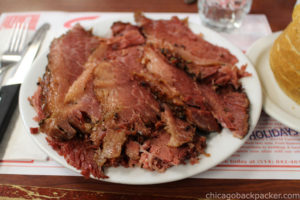 By my third day, it was obvious that smoked meat was a really big thing here. I wanted to find out why. So I went to Schwartz’s, one of Montreal’s best known delicatessens, to find out once and for all what all the fuss was about. And once again, I ran smack into a huge line of people who were all thinking the same thing. The sun was going down behind Mont Royal, the temperature was dropping by the minute, and freezing wind blew against us as we huddled like penguins outside the front door.
By my third day, it was obvious that smoked meat was a really big thing here. I wanted to find out why. So I went to Schwartz’s, one of Montreal’s best known delicatessens, to find out once and for all what all the fuss was about. And once again, I ran smack into a huge line of people who were all thinking the same thing. The sun was going down behind Mont Royal, the temperature was dropping by the minute, and freezing wind blew against us as we huddled like penguins outside the front door.
I finally got inside and they seated me with three other single people. A young Asian girl, a bald dude with a beard of two years, whom at my first glance I thought he listens to Times of Grace-era Neurosis. And then a guy next to me who was so normal that I don’t remember a single thing about him.
We were there for one reason: Montreal Smoked Beef. In places like Schwartz’s, it is salted and cured for at least a week in a secret house blend of spices, put in a smoker for a day, steamed to moisturize, and finally handcut and served to multitudes of patrons day in and out. Most people order the sandwich, consisting of a large helping of meat with mustard served between two slices of rye bread. I however, like Mike Ehrmantraut, don’t believe in half-measures. I ordered a large pile of just the meat served right on a plate with a side of sliced bread. Nothing fancy about it. It was simple, pure and delicious.
Les Brasseries
No visit to a new city is complete without at least one visit to at least one home brewery. On this trip, I found two: Vices et Versa and Dieu du Ciel! They were both charming, dimly lit, full of strong, hoppy aromas, and both had beer menus en Français that I couldn’t read. But variety is always key, and they had plenty of it, listing out their beers by the number on chalkboards. I gambled 5 or 6 choices each, and gave my random numbers to the bartenders.
I ended up with a good variety of sample draughts, polishing off the last two evenings with an array of blondes, wheats, IPAs, porters, stouts, and a cider for good measure.
Before I knew it, I was back at the bus station, boarding a Toronto-bound Megabus and leaving that fine city behind.
My Last Visit to Hot Doug’s
My Last Visit to Hot Doug’s
I wasn’t always this interested in culinary exploration. But Chicago has changed the way I think about food. Since I moved here, I have discovered that some of the most brilliant, innovative artists that our city has to offer are in our restaurants and our kitchens. And their creations are among the best that you will find anywhere.
Among the very best of them is Hot Doug’s – our wildly popular hot dog restaurant in the Avondale neighborhood. For 13 years, owner Doug Sohn has served a variety of amazing hot dogs and sausages, including classic Chicago-style dogs, Polish sausage, and beer soaked bratwurst, to thousands of loyal, hungry people.
But what really makes his restaurant stand out is the gourmet specialty selection. His menu rotates twelve different gourmet sausages of all different kinds of game meats, aged cheeses, sauces, and other random flavorful combinations and toppings, all on a hot dog bun.
Over the years, I have patronized his store for things like a Thanksgiving Turducken Sausage with pumpkin cream and cranberry-infused gourmet cheese, a smoked shrimp and pork hot dog with Cajun shrimp remoulade, goat cheese and honey drizzle. And sometimes just a plain old Chicago style hot dog with all the decorations would suit me just fine.
He is best known for his world famous Foie Gras Hot Dog. A foie gras and sauternes duck sausage with a spread of truffle aioli, chunks of foie gras mousse, and a dash of fleur de sel sea salt. It is as legendary as the culinary kings of old, and is to this day one of the best things I have ever eaten.
It is amazing enough to capture the attention of Anthony Bourdain, who had nothing but great things to say about it when he visited the restaurant. The clientele has done nothing but grow ever since, thanks to the publicity.
Last May, owner Doug Sohn announced on his website that he planned to close the store for good in October, giving his patrons five months to enjoy whatever they could from his one of a kind menu. Since then, the lines have been getting exponentially more and more insane. On a weekday morning, I used to wait ten minutes in line, but after the announcement it took me two hours to get inside. I went once on a Saturday at the end of June and got through the line three hours later. And it hasn’t stopped. It has doubled, tripled, and quadrupled in size over the summer.
Having just got back from a five week trip to Virginia, I wanted to go one last time, and it was now or never. So last Saturday, Mike and I agreed to meet in line at 8am. Word on the street was that the Saturday wait time was about 8.5 hours (yes, I’m serious) if you fail to beat the morning surge, so I bumped it ahead to 7 for safe measure. That would give us 3.5hrs at least to be optimistic.
We lucked out. When I got there, the sun was coming up and only ten people stood ahead of me. The crowds started showing up exponentially over the next few hours, backing up to what looked like a 6 hour wait around 9am. It didn’t stop there; the line kept going and going. So fuck yeah, we got this.
Our wait turned out just shy of 4 hours, and was actually quite a bit of fun, thanks to our knowing we earned the best spot in the line. Well, that and the bloody mary kit that the ladies in front of us generously shared to help kill the time. Why not tailgate to such a noteworthy occasion?
The last two hours blew by as Mike and I hung out with our new tailgating friends. Like us, they enjoyed exploring the food scene. They claimed to meet regularly to go on foodie adventures about the city, as Mike and I also do (though I hesitate to think of myself as a “foodie”, since it goes against my beliefs as a cowboy).
Before we knew it, it was 10:30 and the doors opened. The bittersweet feeling of closure was already starting to distract me from the menu as I walked in for the last time. Doug was at the front counter taking orders and giving Cindy a hard time for having never been to Hot Doug’s before. His banter was as sharp as a cleaver, and he could easily get the customers laughing, especially at the expense of one or two people. “What am I gonna do, get a bad review on Yelp?”
Mike and I put in our orders and sat down with our new friends at a table for five.
We both got a Foie Gras Hot Dog for obvious reasons. In addition, we got four more sausages and shared halves of them: The Smoked and Spicy Alligator Sausage with Crayfish and Shrimp Remoulade and Raspberry-infused Bellavitano Cheese, the Smoked Shrimp and Pork with Creole Mustard, Hominy Grits and Goat Cheese, a Veal Saltimbocca Sausage with Sage Mustard, Sheep’s Milk Brigante Cheese and Fried Prosciutto, and a Lamb and Pork Belly with Onion Butter, Brie Cheese and sweet fucking Tomato Preserves.
I don’t even know what half of this stuff is. But it all tasted as awesome as it sounds.
And I’m not one to waste any time savoring the flavors, fuck that. Even if they are out of this world. A few months ago, I visited Au Cheval, a great diner in the west loop that is well known among locals for their cheeseburgers. As soon as I finished one, a guy came up to me and told me that that was the fastest he had ever seen anybody eat a burger. And he’s right, when something is that good, I will mow it the fuck down.
Mike is pretty much the same way. We finished off our share of the sausages with some room left for duck fat fries. The ladies finished their decadent array of gourmet food and we all got up, satisfied and sad all the same that our favorite place in town will soon be gone forever.
When I walked outside, the line was at least as long as a football field.
But don’t let that discourage you from going. You still have time up to October 3rd, so make the most of it. They open at 10:30, but the line will already be there before. Do what we did and get there at 7, maybe even earlier at this point. The line is exponential as far as I can tell, so if you’re thinking of going on the closing day, you’ll probably have to camp out to beat the surge.
Do whatever you have to do. I promise you it’s worth it.
We will always have great places to eat in Chicago. But I don’t know if we’ll ever have something like this again. I am certain that Hot Doug’s will be remembered for many years to come as a truly, truly quintessential culinary venture.
#foodporn courtesy of Mike Bacos
